This website uses cookies to improve your experience. We believe you'll be OK with this, but you can opt-out if you wish. Or you can go to 'cookie settings' and choose which cookies to allow. Privacy policy
Southeast Asia Pilot – November 2025
8°21S, 116°5.5E
Picking up moorings at an anchorage like Gili Air, instead of dropping anchor, is increasingly necessary as authorities scramble to preserve coral. Be prepared to move if asked to do so by the mooring’s owner or a local authority. Remember, it’s your responsibility to check moorings in terms of their availability, condition and suitability for your yacht. Be aware that some moorings are suitable for small, light boats only.
The Gili Islands – Air, Meno and Trawangan – sit just off Lombok’s northwest coast. Gili Air is the cruiser’s favourite: relaxed, friendly and fringed with coral.
Anchor in 8–12 m on sand east of the island. Holding is good, but watch for coral heads. Best approached in daylight with clear water.
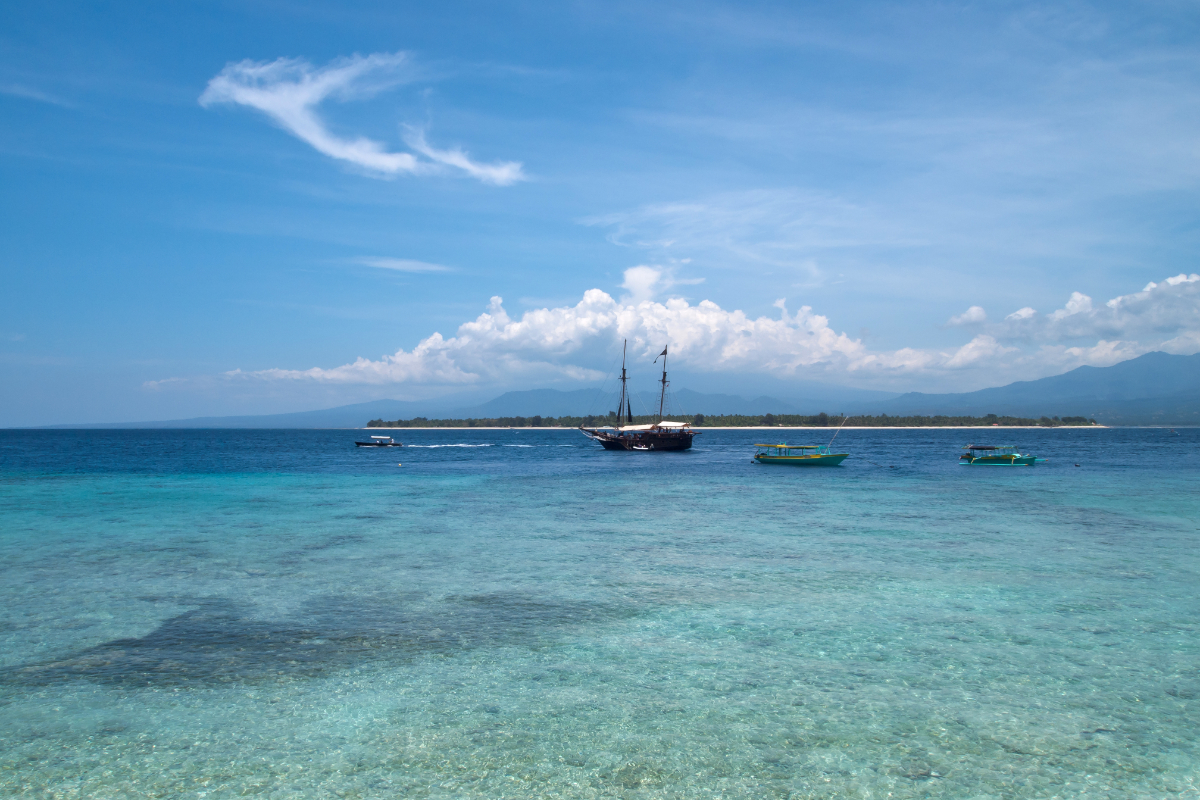
Small cafés, beach bars, and basic shops line the shore. Diving and snorkelling are superb right off the beach. Fuel and water can be arranged via local operators in Bangsal, a short dinghy hop away.
A perfect balance of comfort and simplicity – Gili Air is an easy place to linger, refuel the spirit, and enjoy a taste of island life.
Before heading to Gili Air, make sure to get hold of a copy of Southeast Asia Pilot – 7th Edition. It has detailed coverage of 600+ anchorages across nine countries. Available now in print and digital editions.
⇒ ⇒ ⇒ BUY Southeast Asia Pilot
Southeast Asia Pilot and Phuket Publicity Services do their best to ensure that the information on this website is accurate. However, good seamanship demands that seafarers check critical information carefully with relevant sources to ensure it is up to date.
Indonesia’s islands are magnificent – and vast. Once you leave the major hubs, supermarkets and chandlers become rare sightings. Successful provisioning can make or break a voyage through these remote waters.
Key ports like Bali, Lombok, Kupang and Sorong are provisioning havens. You’ll find decent supermarkets, local markets and sometimes import sections for cheese, wine, or spare parts. Stock up before heading to outlying anchorages where even rice may be scarce.
Traditional pasar (markets) are lively, colourful and full of surprises – from tropical fruits and fresh fish to hand-ground spices. Carry small notes, a smile and a reusable bag; bargaining is expected but friendly.
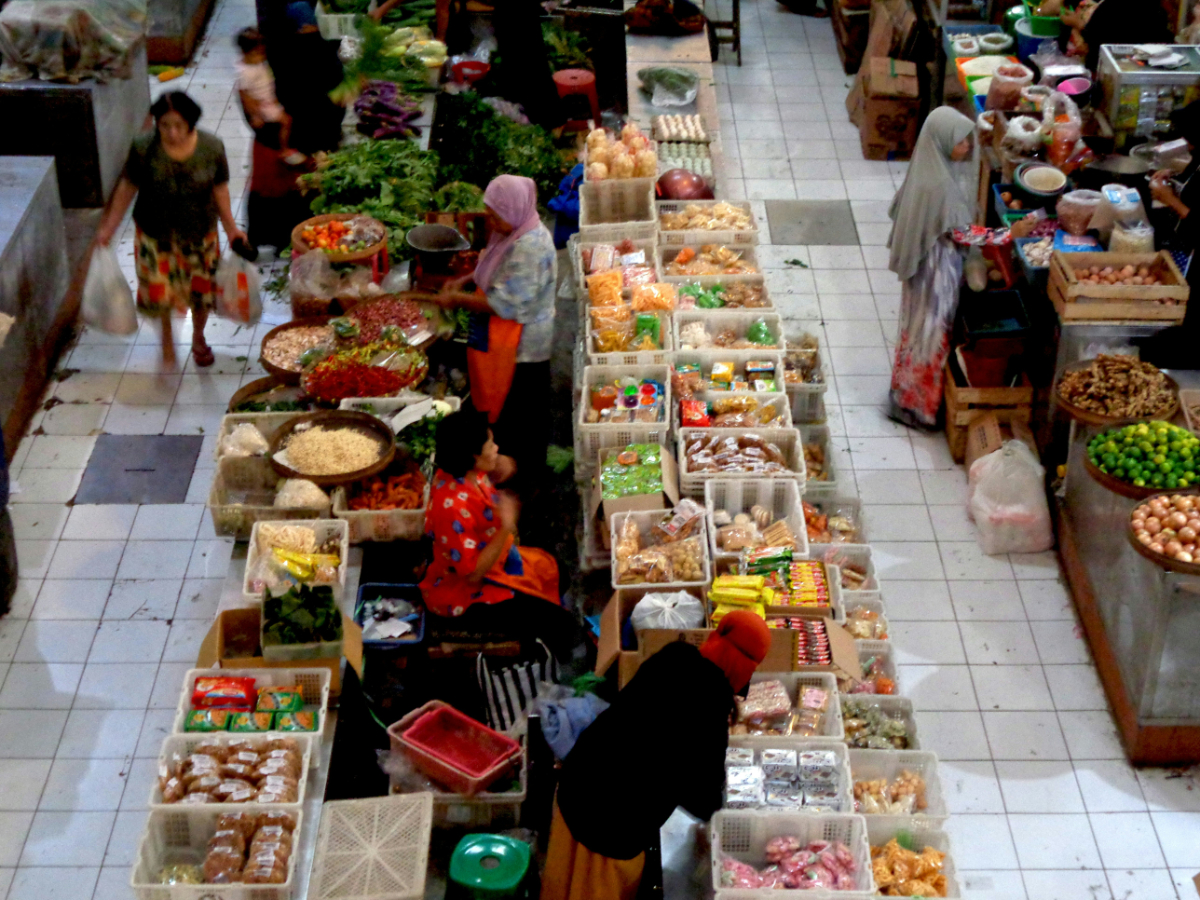
High humidity and heat demand careful storage. Vacuum-seal dry goods, keep tins off the hull and store produce in breathable nets. Local eggs and root vegetables last well if kept cool and dry.
Outside the main islands, diesel is often sold in jerrycans from the beach. Filter all fuel and treat local water if unsure. Carry spare filters and jugs – they’re worth their weight in gold
Provisioning in Indonesia isn’t just a chore – it’s an adventure into local life. Treat it that way and you’ll cruise longer and better supplied.
When planning your Indonesian cruise, don’t forget to get a copy of Southeast Asia Pilot, which remains the definitive cruising guide to all of Southeast Asia’s ocean wonderland. Available in print or as an interactive eBook, it details 600+ anchorages with shoreside tips and other useful insights. It covers nine countries, from the Andaman Sea to the Spice Islands – with introductory notes on several more. Available now in print and digital editions.
⇒ ⇒ ⇒ Buy Southeast Asia Pilot
Southeast Asia Pilot and Phuket Publicity Services do their best to ensure that the information on this website is accurate. However, good seamanship demands that seafarers check critical information carefully with relevant sources to ensure it is up to date.Facebook
Southeast Asia Pilot – October 2025
7°21.531N, 99°17.540E
Picking up moorings at an anchorage like Koh Muk, instead of dropping anchor, is increasingly necessary as authorities scramble to preserve coral. Be prepared to move if asked to do so by the mooring’s owner or a local authority. Remember, it’s your responsibility to check moorings in terms of their availability, condition and suitability for your yacht. Be aware that some moorings are suitable for small, light boats only.
Ko Muk, a gem in the Trang group, offers pristine beaches, a welcoming village, and one of Thailand’s most famous natural attractions – the Emerald Cave, just 1NM north along the coast. The approach is straightforward, and the anchorage off Hat Farang (Charlie Beach) provides good holding in mud.
Anchor in 6m on a muddy bottom. The holding is excellent and shelter reliable in the northeast monsoon, though exposed in the southwest.
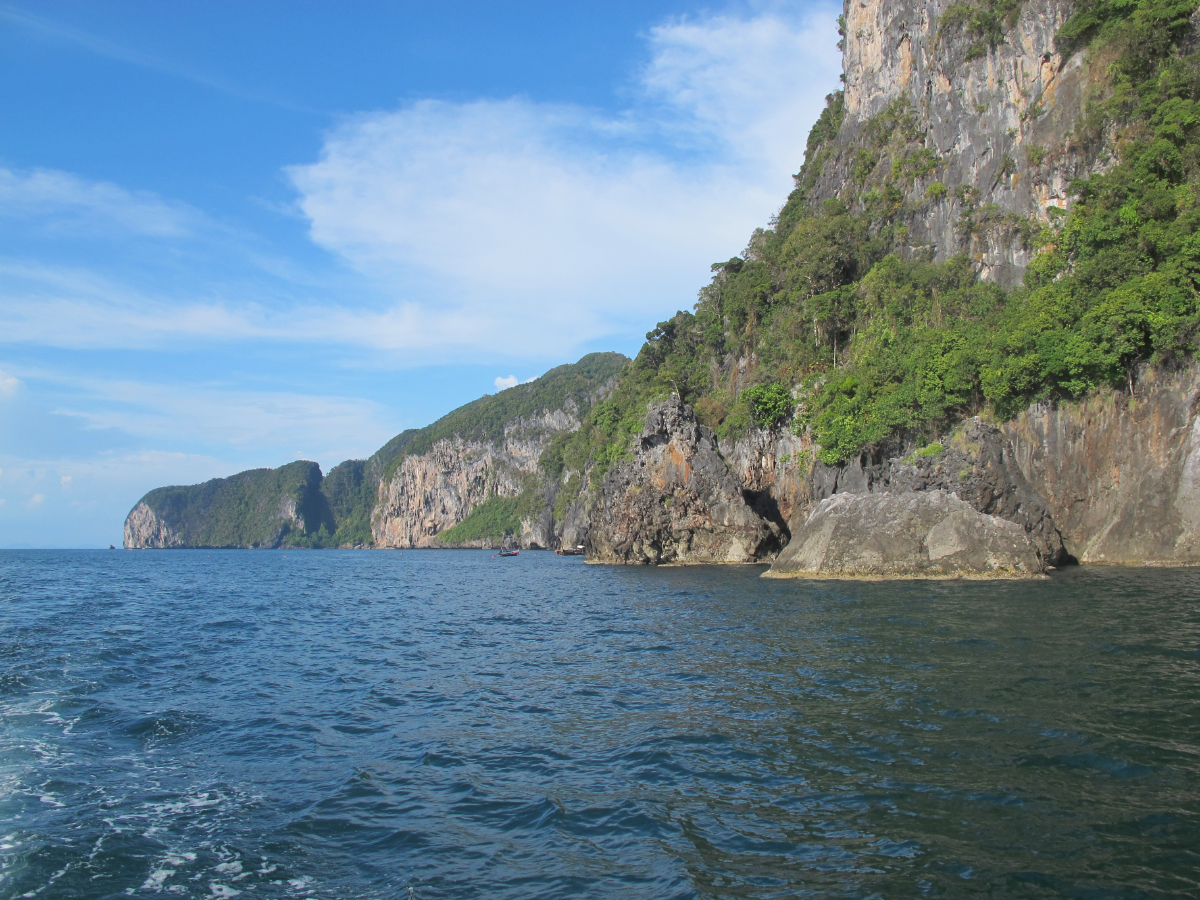
The island has small resorts and restaurants, with the local village – a pleaant 20-minute walk across to the east coast – offering basic provisions. Motorcycle taxis with sidecar are available. Perched high on, and jutting out over, the rocks at the southern end of the bay is a no-name, family-run, restaurant with good food and a warm welcome for yachties.Longtail boats can be noisy during day but fade at sunset.
Swim through the Emerald Cave – a hidden lagoon accessed via a short sea tunnel. It’s best at mid-tide when sunlight turns the water emerald green.
Ko Muk delivers all the Andaman charm in miniature – beauty, simplicity, and a sense of discovery just a day’s sail from Kantiang Bay on Koh Lanta.
Before heading to Koh Muk, make sure to get hold of a copy of Southeast Asia Pilot – 7th Edition. It has detailed coverage of 600+ anchorages across nine countries. Available now in print and digital editions.
⇒ ⇒ ⇒ BUY Southeast Asia Pilot
Southeast Asia Pilot and Phuket Publicity Services do their best to ensure that the information on this website is accurate. However, good seamanship demands that seafarers check critical information carefully with relevant sources to ensure it is up to date.
The joy of cruising Southeast Asia lies in its variety – remote islands, bustling ports, and year-round warmth. But that same tropical charm comes with a challenge: the region’s complex monsoon system. Knowing the weather, and therefore when and where to sail, can make the difference between an unforgettable season and an uncomfortable one.
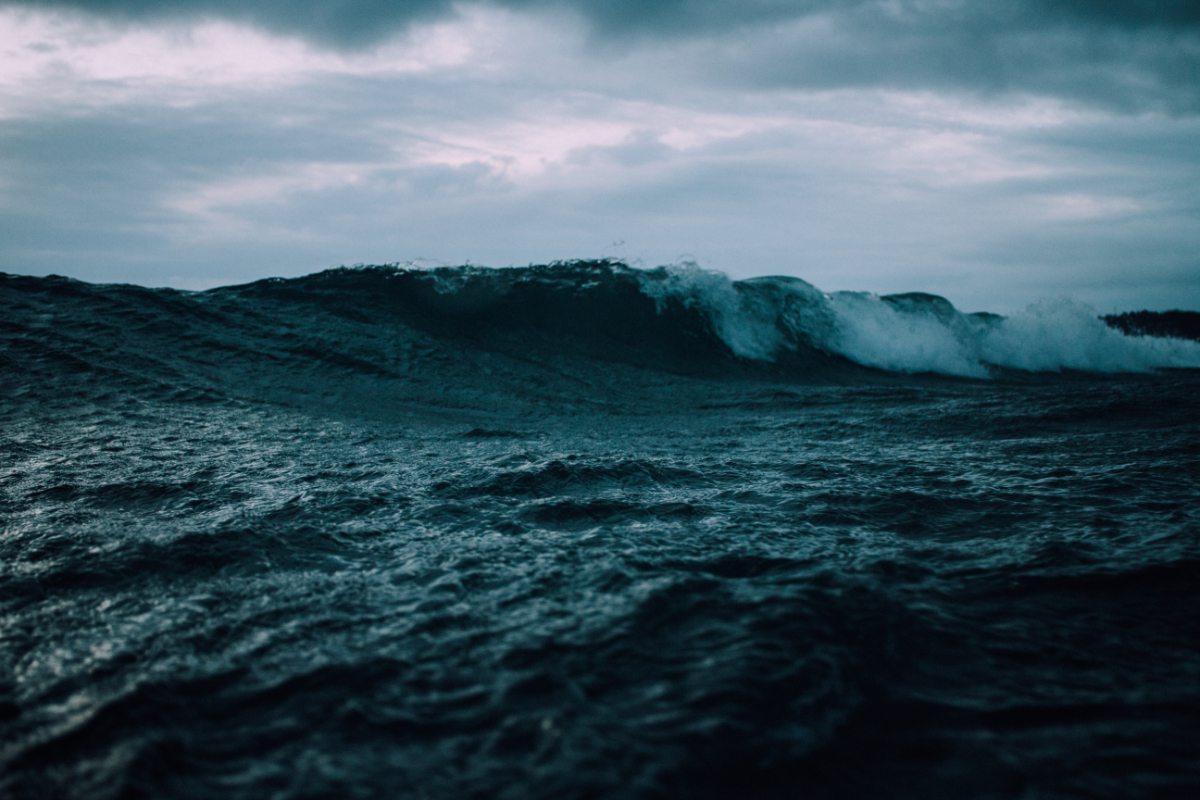
Southeast Asia experiences two dominant wind systems – the Northeast Monsoon (roughly November to April) and the Southwest Monsoon (May to October).
The northeast brings drier weather to Thailand, Malaysia’s west coast and the Andaman Sea, while Indonesia’s northern regions and the South China Sea get wetter conditions. The southwest flips that pattern – Thailand’s Andaman anchorages see swells and rain, while Indonesia’s southern cruising grounds shine under clear skies.
Many cruisers migrate seasonally: Thailand in the NE monsoon, Indonesia during the SW – and Malaysia as a transition or stopover. This rhythm lets you follow fair winds and calm seas while avoiding stormier months.
Coastal geography and mountain ranges mean wind and rain patterns can differ even within short distances. For example, Langkawi may bask in sunshine while Phuket gets drenched. Always check local forecasts before departure.
PredictWind, Windy, and local MET forecasts are invaluable – but so is local knowledge. Chatting with marina staff, fishermen, or other skippers often yields more accurate short-term insights than any app.
Southeast Asia rewards patience. Wait for the right window, sail with the season, and you’ll find every passage smoother and safer.
Plan smart, cruise safely – and let Southeast Asia Pilot be your guide to planning every voyage.
When planning your Southeast Asian cruising, don’t forget to get a copy of Southeast Asia Pilot. It remains the definitive cruising guide to all of Southeast Asia’s ocean wonderland. The book details 600+ anchorages with shoreside tips and other useful insights. It covers nine countries, from the Andaman Sea to the Spice Islands – with introductory notes on several more. Available now in print or as an interactive eBook.
⇒ ⇒ ⇒ Buy Southeast Asia Pilot
Southeast Asia Pilot and Phuket Publicity Services do their best to ensure that the information on this website is accurate. However, good seamanship demands that seafarers check critical information carefully with relevant sources to ensure it is up to date.Facebook
Welcome to the second part of our hazardous marine life blog. If you missed the first part, we suggest you go there first from this link.
Here we continue the ‘handful’ of ‘pain-inducing nasties’ among marine life to be particularly cautious of – and what to do if you are unfortunate enough to come into contact with them!
Tightly tie a broad ligature between the inflicted limb and the body, which must be released every 15 minutes.
Then immerse the inflicted area in water at a temperature of 50ºC for two hours, or until the pain stops. Follow this up by antibiotic and anti-tetanus treatment.
As opposed to being true coral, fire coral is more closely related to stinging hydroids. However, as its name suggests, any contact with fire coral will result in some very nasty and painful blistering. The treatment is the same as for stinging hydroids (Flush or submerge the affected area with acetic acid [vinegar] followed by antihistamine cream to ease any pain.)
Never handle cone shells! They can fire a poisonous dart from a tube-like organ. This results in numbness followed by local muscle paralysis, which can lead to respiratory paralysis and heart failure. The treatment is to immediately tie a broad ligature tightly between the infliction and the body and wash the wound. CPR may be necessary.
Sea urchins can have poisonous spines. Even if not poisonous, though, they still easily puncture skin and break off, especially if trodden on. This leaves painful wounds that can go sceptic. Apply HTW. This will help in softening up any embedded spines and allow the body to eject them. Applying papaya juice or wine will also help to reduce pain. Septic wounds will require antibiotics.
Ranging in size from a few centimetres across to several metres, stingrays have spines in the top of their tails. They can lash out in any direction if trodden on or caught. The wounds can be large and, in rare cases, fatal. Clean the wound and remove any spines with tweezers. Follow up with HTW.
The best camouflaged, stonefish are the most dangerous member of the scorpionfish family. The spines in their dorsal fins contain very nasty venom and are raised if the fish is disturbed. These cause intense pain and swelling and you should immediately clean the wound and adhere to HTW.
Although less camouflaged and not as dangerous as the stonefish, scorpionfish should still be avoided. Failing to do so will require the same treatment as for stonefish.
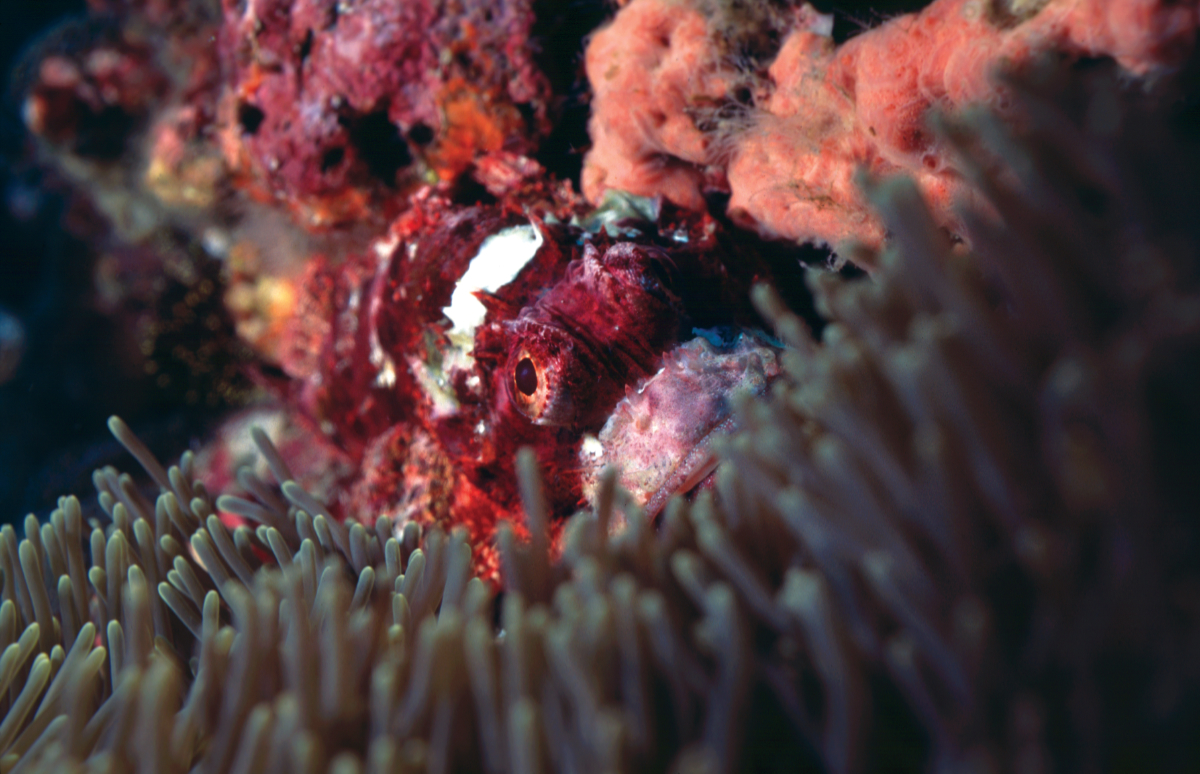
This should be waterproof, sealed and preferably compartmentalised for ease of finding things when needed quickly. As a minimum, ensure it contains the following items:
First Aid Manual | Hazardous marine life reference and identification guides | Emergency contact numbers for en-route locations & destination | Pencil and notebook | Tweezers | Round ended safety scissors | Large sterile dressings | Fabric band-aid plaster/dressing strip | Triangular bandage | Large safety pins | Sterile cotton wool | 2” wide crepe bandages | Eye drops | Antiseptic cream | Betadine | Antihistamine cream | Vinegar | Sachets of electrolytes | Sterilised syringe and needles
When planning your Southeast Asian cruising, don’t forget to get a copy of Southeast Asia Pilot. It remains the definitive cruising guide to all of Southeast Asia’s ocean wonderland. The book details 600+ anchorages with shoreside tips and other useful insights. It covers nine countries, from the Andaman Sea to the Spice Islands – with introductory notes on several more. Available now in print or as an interactive eBook.
⇒ ⇒ ⇒ Buy Southeast Asia Pilot
Southeast Asia Pilot and Phuket Publicity Services do their best to ensure that the information on this website is accurate. However, good seamanship demands that seafarers check critical information carefully with relevant sources to ensure it is up to date.Facebook
A golden rule to avoid any aquatic injuries repeated on all diver training courses is “don’t touch, chase or provoke anything under the water or on the surface”. However, there may be the odd occasion when it’s not quite as straight forward as that – in turbid waters for instance. So we offer a few tips on dealing with hazardous marine life.
Here is a ‘handful’ of ‘pain-inducing nasties’ to be particularly cautious of – and what to do if you are unfortunate enough to come into contact with them!
Tightly tie a broad ligature between the inflicted limb and the body, which must be released every 15 minutes.
Then immerse the inflicted area in water at a temperature of 50ºC for two hours, or until the pain stops. Follow this up by antibiotic and anti-tetanus treatment.
Jellyfish stings range from skin irritations to deep lesions. You can best avoid contact by constantly being aware of what’s around, above and below you. Keep a constant lookout! Avoid the tentacles.
If a jellyfish ‘stings’ you, immediately flush the area using the same water that it occurred in – stung in salt water, flush with salt water, NOT fresh, and vice versa. Immediately after that flush the area with acetic acid (vinegar). If there are any tentacles remaining in the skin, remove them with tweezers or gloved fingers. If the pain worsens or you experience breathing difficulties, seek medical attention immediately.
Barracuda are commonly seen in large schools. However, lone specimens have been known to bite. This generally happens in low visibility waters when a shiny item such as jewellery, a knife blade or a camera lens is mistaken for their prey of small fish. So it’s best to avoid shiny objects whilst in the water! If bitten, thoroughly clean any wound and apply antiseptic or antibiotic cream.
Lionfish are slow moving and generally encountered around reefs and wrecks. They have beautiful long feather like fins, but these harbour venomous spines which cause a very nasty sting. Immediately clean the wound and adhere to the Hot Water Treatment (HTW) if the spines have punctured the.
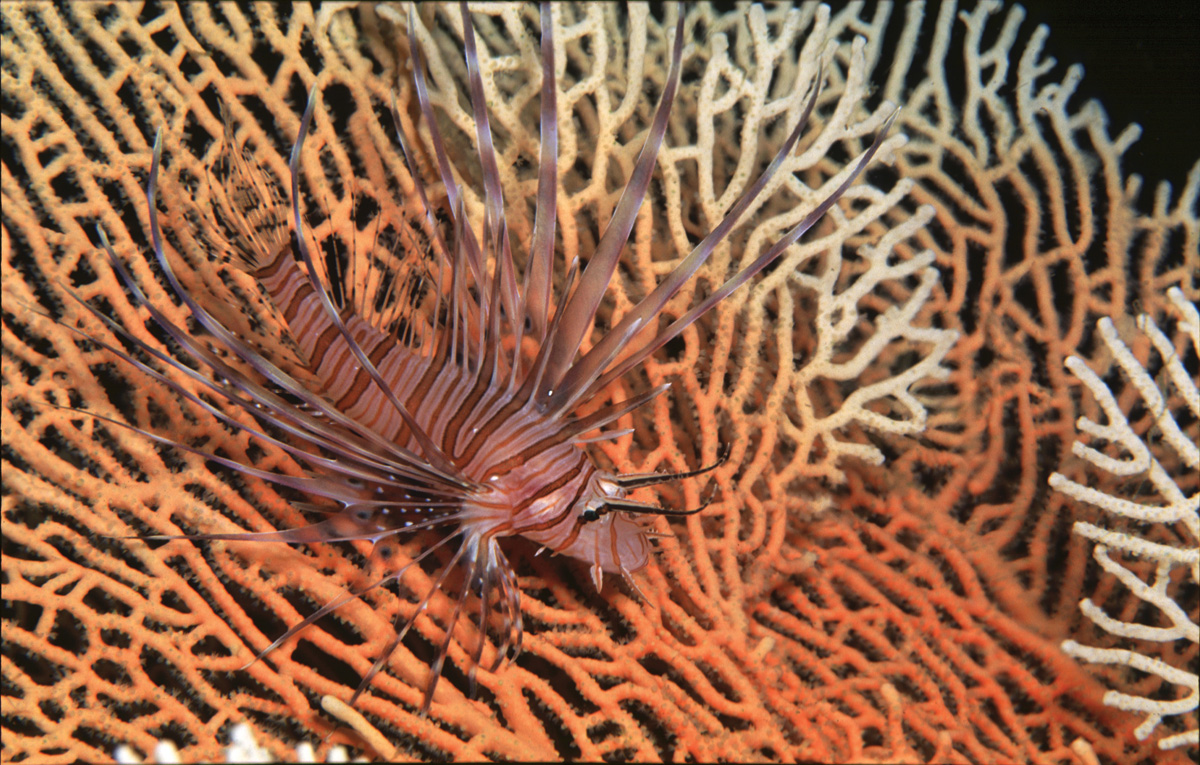
Sea snake venom is more potent than that of the cobra, but they are rarely aggressive, have very short fangs and small mouths which cannot be opened very wide; they would be capable of biting between fingers, so keep your fingers together in their presence! If bitten, immediately tie a broad ligature tightly between the infliction and the body and wash the wound. CPR may be necessary. Seek medical facilities as antivenins will be needed.
Triggerfish are all territorially aggressive, especially if they are nesting (shallow pits in the sandy seabed). If you approach too closely, males will charge at you to ward them off – and they have a nasty couple of teeth to finish the job! If you are unfortunate to be on the receiving end, the recommended procedure is to swim backwards and place your feet between you and the attacker. At NO TIME take your eyes off them, until you have backed away far enough to satisfy him that you are no longer a threat. If bitten, treat with antiseptic cream.
Stinging hydroids can cling to anchor lines. If you make contactwith them, they release nematocysts into the skin. Although not a serious problem, it can be very painful; in some cases they can cause blistering. To treat, flush or submerge the affected area with acetic acid (vinegar) followed by antihistamine cream to ease any pain.
This should be waterproof, sealed and preferably compartmentalised for ease of finding things when needed quickly. As a minimum, ensure it contains the following items:
First Aid Manual | Hazardous marine life reference and identification guides | Emergency contact numbers for en-route locations & destination | Pencil and notebook | Tweezers | Round ended safety scissors | Large sterile dressings | Fabric band-aid plaster/dressing strip | Triangular bandage | Large safety pins | Sterile cotton wool | 2” wide crepe bandages | Eye drops | Antiseptic cream | Betadine | Antihistamine cream | Vinegar | Sachets of electrolytes | Sterilised syringe and needles
When planning your Southeast Asian cruising, don’t forget to get a copy of Southeast Asia Pilot. It remains the definitive cruising guide to all of Southeast Asia’s ocean wonderland. The book details 600+ anchorages with shoreside tips and other useful insights. It covers nine countries, from the Andaman Sea to the Spice Islands – with introductory notes on several more. Available now in print or as an interactive eBook.
⇒ ⇒ ⇒ Buy Southeast Asia Pilot
Southeast Asia Pilot and Phuket Publicity Services do their best to ensure that the information on this website is accurate. However, good seamanship demands that seafarers check critical information carefully with relevant sources to ensure it is up to date.Facebook
Southeast Asia Pilot – October 2025
04°31.498S, 129°53.583E
Picking up moorings at an anchorage like Banda Neira, instead of dropping anchor, is increasingly necessary as authorities scramble to preserve coral. Be prepared to move if asked to do so by the mooring’s owner or a local authority. Remember, it’s your responsibility to check moorings in terms of their availability, condition and suitability for your yacht. Be aware that some moorings are suitable for small, light boats only.
Once the centre of the global spice trade, Banda Neira is steeped in history. Its one of the greatest natural harbours – and one of the safest – in the Indonesia, ringed by volcanic peaks and colonial forts.
Anchor off Banda Neira in 28-33 metres or on the shallower Gunung Api side at 04°31S, 129°53.498E. The holding in both is good. The harbour’s protection comes mainly from the live volcano, Gunung Api, that last erupted in 1988. This cluster of 10 volcanic islands is the famed ‘Spice Islands’.
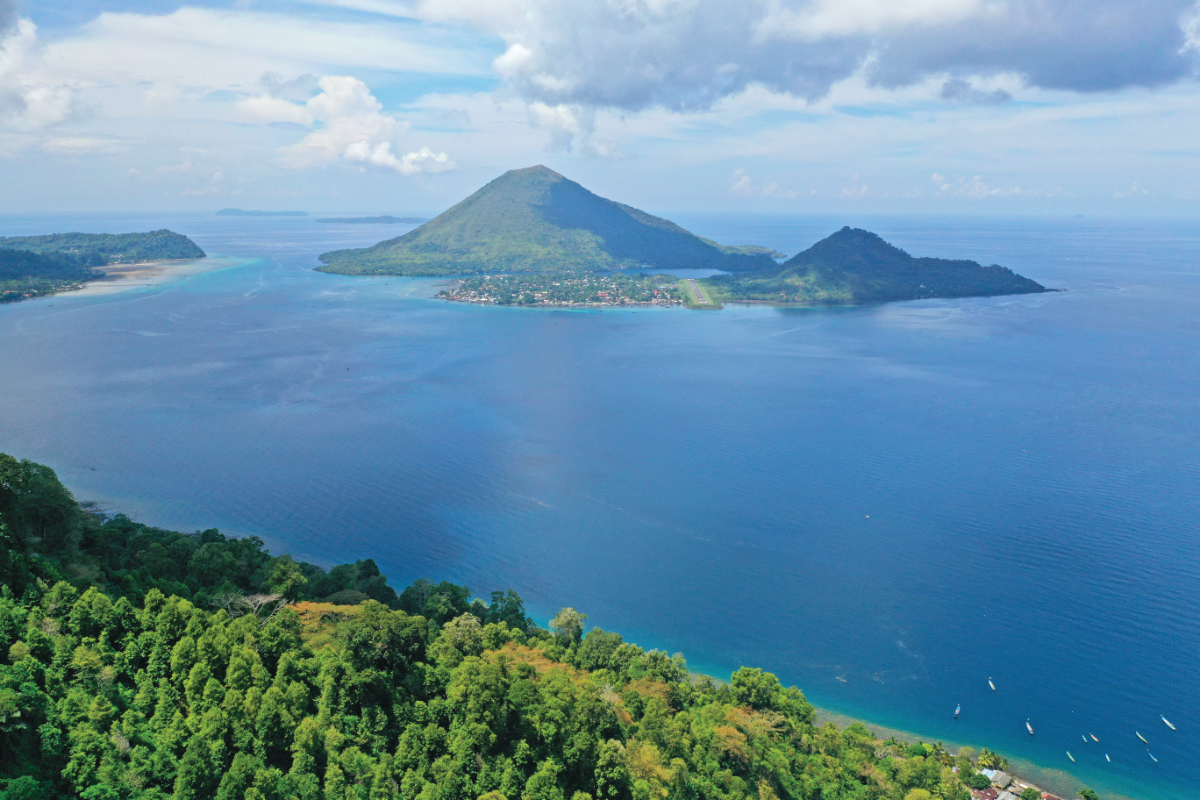
Ashore on the main island are forts and historical architecture, small hotels, guest houses and restaurants, a fascinating museum and a small airport. Banda Neira is not a fully-stocked provisioning port for large-scale or speciality items. The town has a fresh market, a fish market and a few small shops. There are no bars but you can find a cold beer at some guest houses. You can hire a bicycle rickshaw to get around.
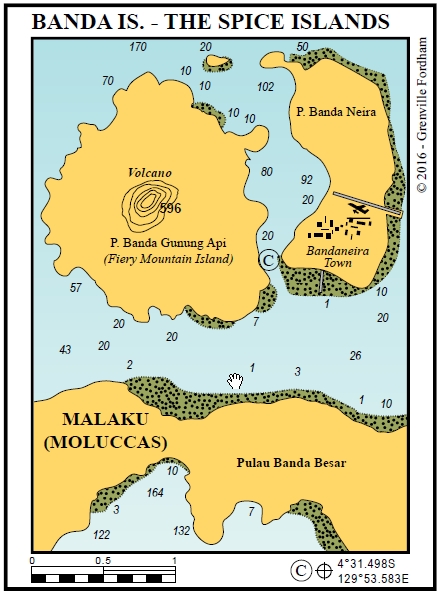
The Banda Islands are remote, requiring a committed passage, but the rewards – both cultural and scenic – are immense. This is cruising at its most authentic. The historic jewel of the Banda Sea, once you’ve visited Banda Neira, you’ll never forget it.
Before heading to Banda Neira, make sure to get hold of a copy of Southeast Asia Pilot – 7th Edition. It has detailed coverage of 600+ anchorages across nine countries. Available now in print and digital editions.
⇒ ⇒ ⇒ BUY Southeast Asia Pilot
Southeast Asia Pilot and Phuket Publicity Services do their best to ensure that the information on this website is accurate. However, good seamanship demands that seafarers check critical information carefully with relevant sources to ensure it is up to date.
Indonesia’s 17,000 islands are a yachtsman’s dream, and chartering is the ideal way to explore Indonesia if you don’t bring your own boat. But there are important differences from chartering in the Med or Caribbean.
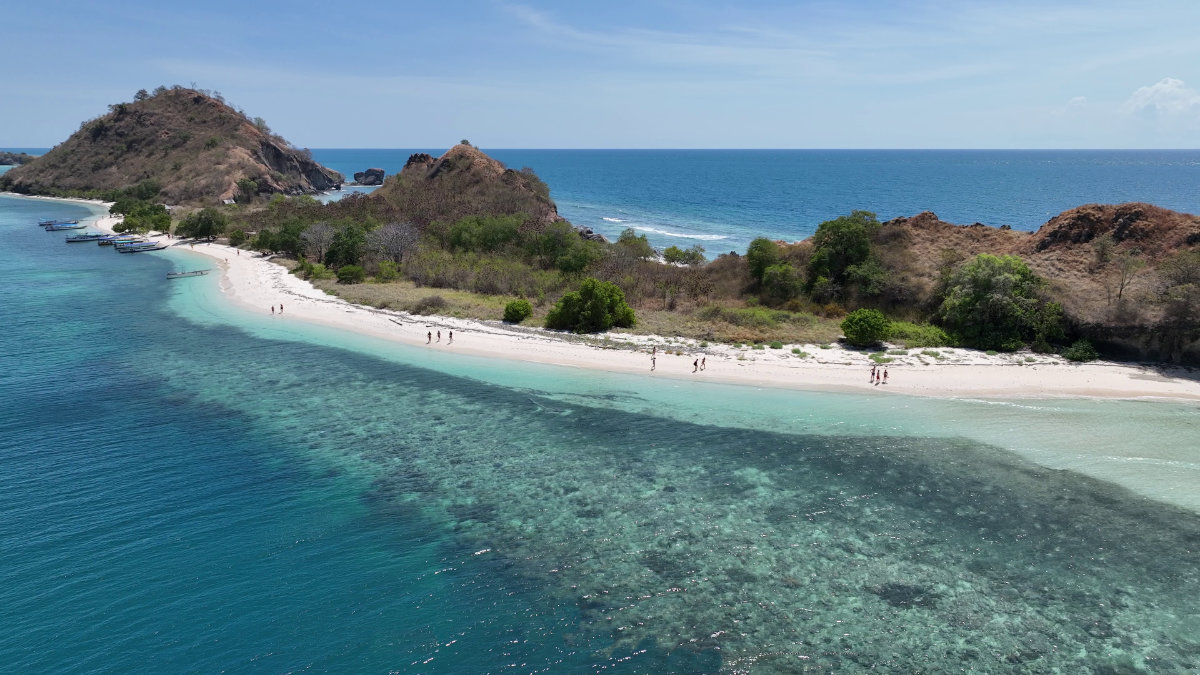
Most charters here are fully crewed, with experienced local captains who know the reefs and regulations. Bareboat options are rare, but that makes for a more relaxed holiday – and safer passages in remote waters.
Seasonality matters: The 8th Parallel band of islands, including Bali, Lombok and Komodo, is the key cruising area during the southeast trade winds which blow from April to October/November – what cruisers consider the southern hemisphere winter months. Raja Ampat and other areas in the Equatorial zone are the key cruising areas from December to February – the southern hemisphere summer months. However, cruising around the equator is more influenced by localised weather patterns than by seasonality, so cruising yachts and charter operators often cruise these waters year-round.
Permits, park fees and domestic flights should all be factored into planning your charter cruise. Make sure you have the right visas and check with your charter operator about any special rules and procedures – for example what documentation do you need if bringing prescription medicines with you.
For those willing to venture beyond the beaten track, chartering in Indonesia offers unspoiled anchorages, vibrant cultures, amazing surfing and some of the world’s most spectacular diving. The melting pot of Indonesian cultures and the welcoming local people all make Indonesia a hugely rewarding cruising destination.
When planning your Indonesian charter, don’t forget to get a copy of Southeast Asia Pilot, which remains the definitive cruising guide to all of Southeast Asia’s ocean wonderland. Available in print or as an interactive eBook, it details 600+ anchorages with shoreside tips and other useful insights. It covers nine countries, from the Andaman Sea to the Spice Islands – with introductory notes on several more. Available now in print and digital editions.
⇒ ⇒ ⇒ Buy Southeast Asia Pilot
Southeast Asia Pilot and Phuket Publicity Services do their best to ensure that the information on this website is accurate. However, good seamanship demands that seafarers check critical information carefully with relevant sources to ensure it is up to date.Facebook
Southeast Asia Pilot – October 2025
06°37.557N, 99°36.403E (Ao Son)
Picking up moorings at an anchorage like Koh Tarutao, instead of dropping anchor, is increasingly necessary as authorities scramble to preserve coral. Be prepared to move if asked to do so by the mooring’s owner or a local authority. Remember, it’s your responsibility to check moorings in terms of their availability, condition and suitability for your yacht. Be aware that some moorings are suitable for small, light boats only.
Koh Tarutao lies in the far south of Thailand, close to the Malaysian border. It is part of Tarutao National Marine Park, a haven of rainforests, mangroves and empty beaches. Unlike the more developed islands farther north, Tarutao remains largely untouched.
We recommend three anchorages on the west coast – Ao Pante, Baan Ao Makham and Ao Son – all with good holding in sandy bays. We suggest a further two anchorages on the eastern side of the island. The first, Ao Talo Wao, has a ferry service here serving Satun, the Butangs and Langkawi as well as a ranger station on the hill. The second, Ao Talo Udang, was once the site of a penal colony for political prisoners.
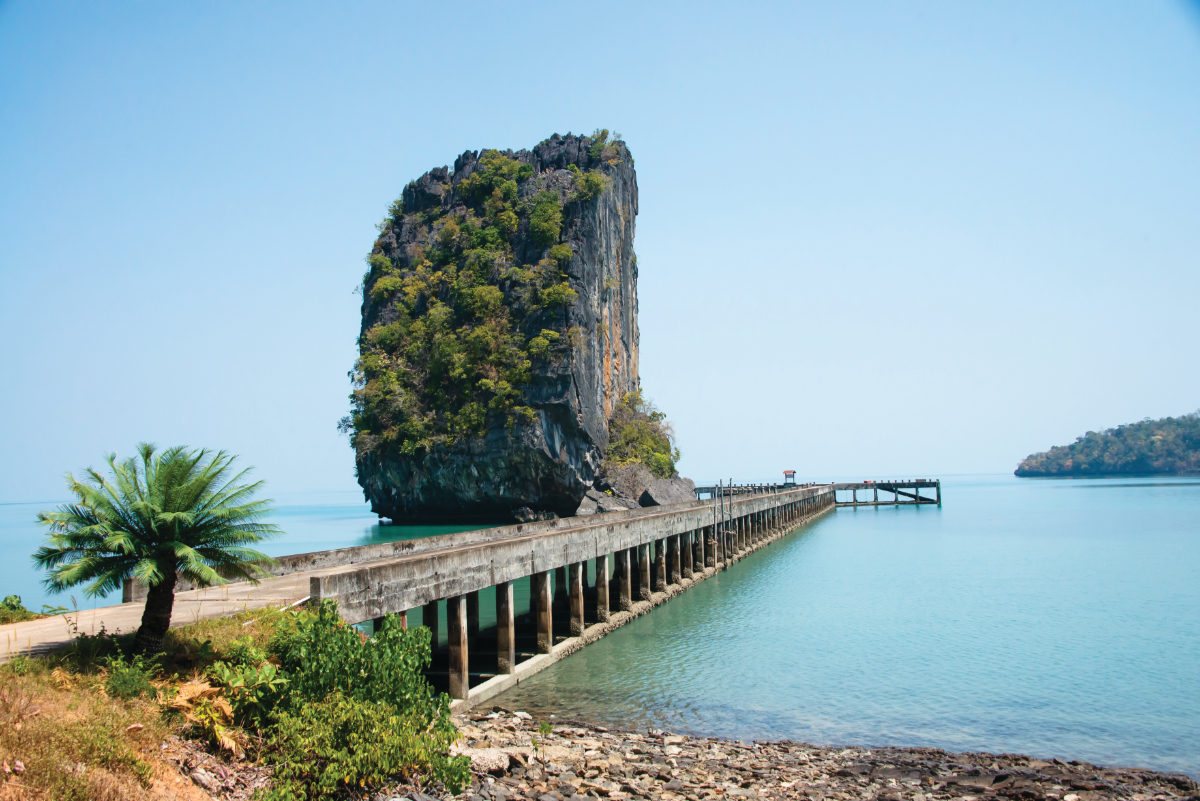
Ao Pante, with its National Park HQ, has a concrete pier, bamboo houses, bungalows, a small store, restaurant, museum, visitors’ centre, communications office, public toilets and a library. Expect to pay about 500 baht per person landing fee. Elsewhere, there are few facilities ashore – which is exactly why we like it. Wildlife abounds, with hornbills in the trees, turtles on the beaches and mangrove creeks just waiting to be explored by dinghy.
For yachts heading from Phuket to Langkawi, a stop at Tarutao is both practical and unforgettable – a glimpse of the Andaman as it once was.
Southeast Asia Pilot – 7th Edition has detailed coverage of 600+ anchorages across nine countries. Available now in print and digital editions.
⇒ ⇒ ⇒ BUY Southeast Asia Pilot
Southeast Asia Pilot and Phuket Publicity Services do their best to ensure that the information on this website is accurate. However, good seamanship demands that seafarers check critical information carefully with relevant sources to ensure it is up to date.
Thailand’s marine parks are among the most beautiful in the world, from the granite boulders of the Similans to the emerald lagoons of Phang Nga Bay.
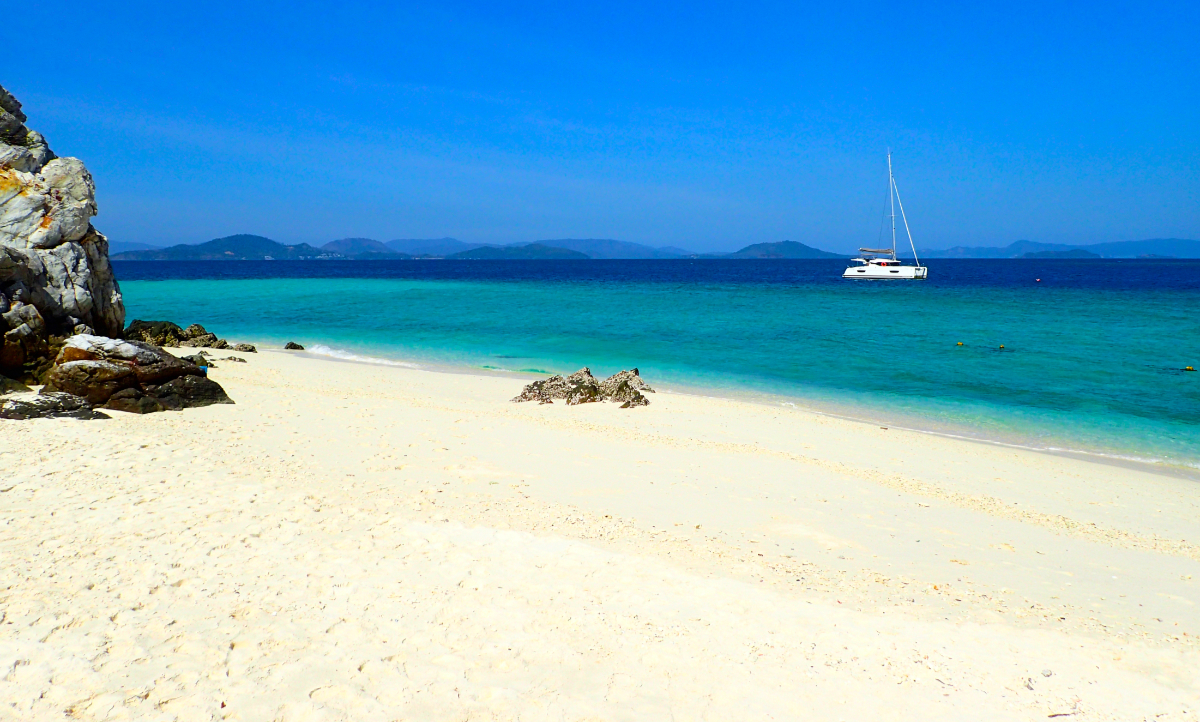
Yet these fragile ecosystems face pressures from mass tourism, overfishing and climate change. The Thai Marine Park authorities have started limiting visitor numbers, banning anchoring on coral, and enforcing seasonal closures. These measures have helped protect biodiversity while keeping the parks open to yachts.
Visiting skippers should be aware of fees and regulations – and embrace them as the price of preserving paradise. Sailing through these parks is a privilege.
Always pick up a mooring instead of dropping your anchor. If there is no mooring option, be careful to drop anchor away from all coral. Take nothing but photos and support local rangers where you can. The reward is clear: crystal waters, abundant marine life and bays that still feel like untouched sanctuaries.
For owners, charterers and captains cruising Thailand’s Marine Parks and the wider region, Southeast Asia Pilot remains the definitive cruising guide. It details 600+ anchorages with shoreside tips and other useful insights. It covers nine countries, from the Andaman Sea to the Spice Islands – with introductory notes on several more. Available now in print and digital editions.
⇒ ⇒ ⇒ Buy Southeast Asia Pilot
Southeast Asia Pilot and Phuket Publicity Services do their best to ensure that the information on this website is accurate. However, good seamanship demands that seafarers check critical information carefully with relevant sources to ensure it is up to date.Facebook
Southeast Asia Pilot – October 2025
08°29.805S, 119°52.553E
Picking up moorings at an anchorage like Labuan Bajo, instead dropping anchor, is increasingly necessary as authorities scramble to preserve coral. Be prepared to move if asked to do so by the mooring’s owner or a local authority. Remember, it’s your responsibility to check moorings in terms of their availability, condition and suitability for your yacht. Be aware that some moorings are suitable for small, light boats only.
Labuan Bajo is the western gateway to Komodo National Park, where dragons roam the hillsides and manta rays glide beneath the waves. Once a sleepy fishing village, it is now a bustling hub with marinas, dive operators and provisioning options.
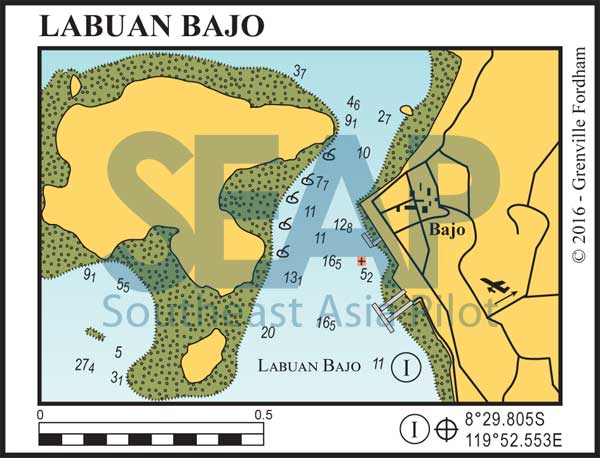
Anchoring in 12-14 metres on sand is straightforward in the well-sheltered bay, though holding can be patchy in places. Many skippers prefer moorings arranged via local agents. From here, it is only a short day’s sail to the pink beaches and dramatic anchorages of Komodo and Rinca.
Everything a cruising yacht needs is available – with access to small repairs, fuel, water and local provisions. Anything with any level of sophistication, including first-world provisions, though, has to be flown in from from Bali.
Labaun Bajo has an eclectic range and quality of restaurants and eating-houses. It is a hive of activity for diving and snorkelling tours and has some interesting overland excursions to unique villages in the mountains behind the town.
For yachts cruising east through Indonesia, Labuan Bajo is both a supply stop and a jumping-off point for one of the most spectacular cruising grounds in Asia.
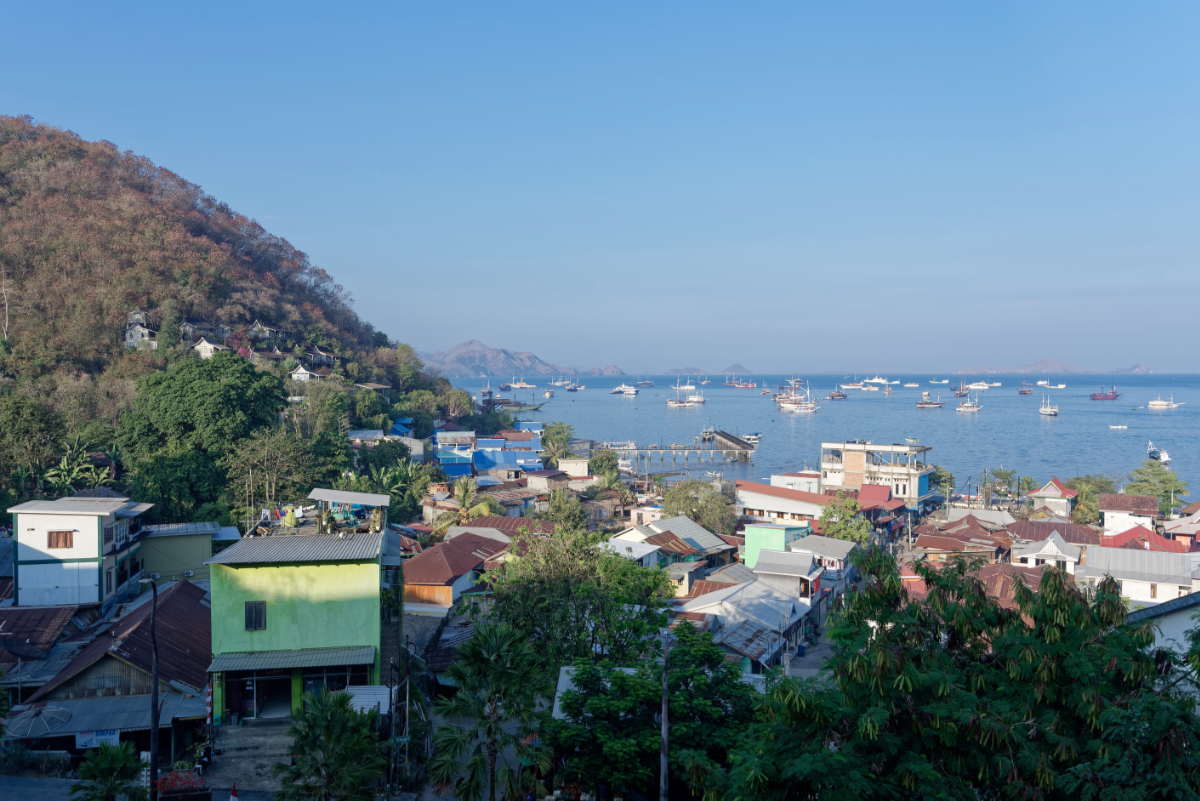
Southeast Asia Pilot – 7th Edition has detailed coverage of 600+ anchorages across nine countries. Available now in print and digital editions.
⇒ ⇒ ⇒ BUY Southeast Asia Pilot
Southeast Asia Pilot and Phuket Publicity Services do their best to ensure that the information on this website is accurate. However, good seamanship demands that seafarers check critical information carefully with relevant sources to ensure it is up to date.
Passage planning is more than plotting lines on a chart – it is the seamanship backbone of every safe and enjoyable cruise. In Southeast Asia, with its seasonal monsoons, tidal currents, busy shipping lanes and countless reefs, careful preparation is even more important.
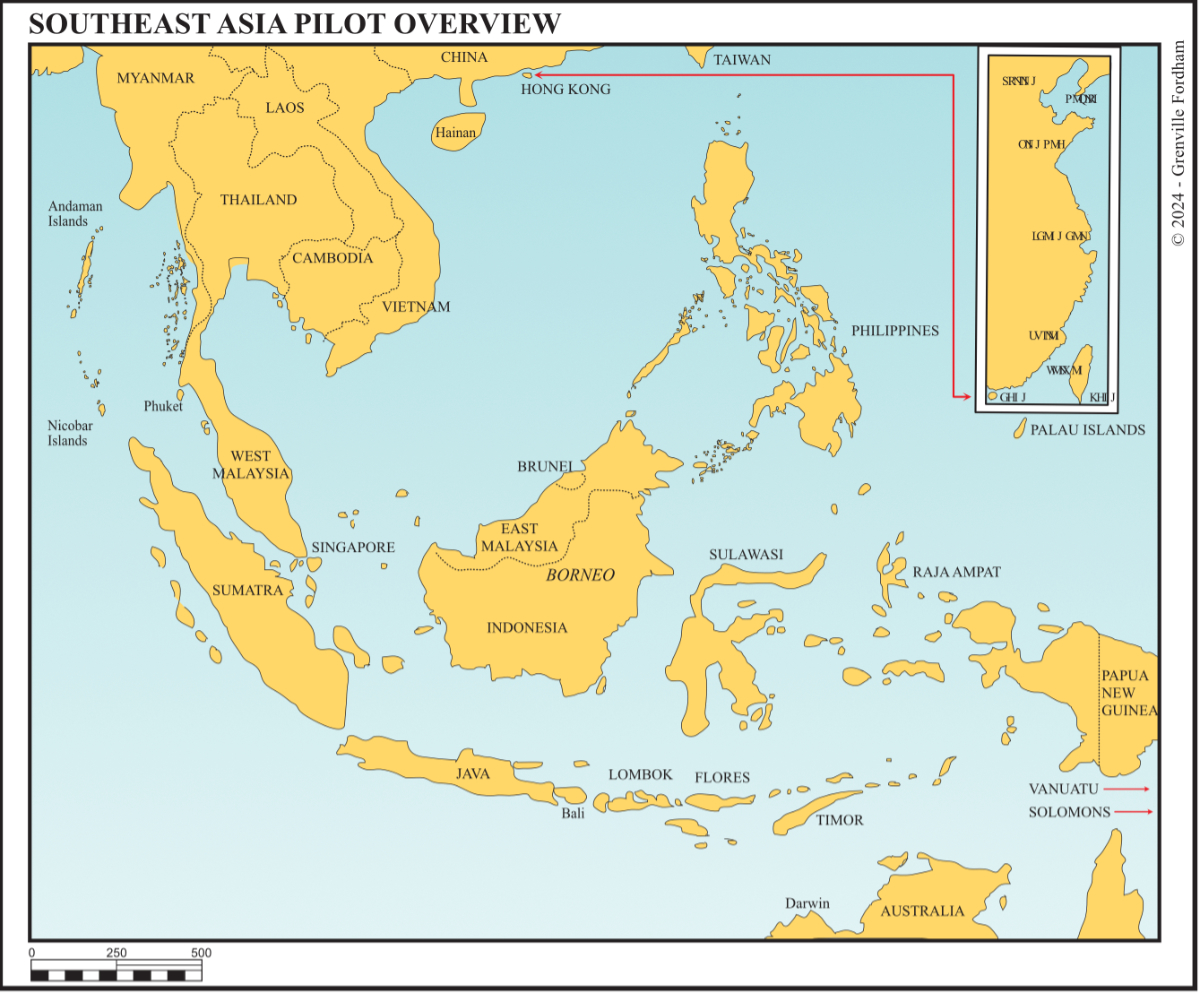
Yachts heading out from Phuket toward the Similan Islands, for instance, must plan around park entry rules, mooring availability and safe return windows. Those venturing across to Indonesia face longer passages, where fuel stops, visa requirements and weather routing all come into play.
Modern tools such as Navionics (see footnote) and PredictWind have made planning easier than ever. However, nothing replaces the skipper’s judgement – and a printed pilot book at the chart table.
Whether you are plotting a two-hour hop or a two-week voyage, the fundamentals remain: check the charts, know the tides, read the weather and always have a Plan B – as well as a copy of Southeast Asia Pilot!
In July 2025 Garmin announced they were discontinuing their Southeast Asia charts – to be replaced by new charts sometime in Q3 2025. They have now moved that target to Q4. In the meantime, they pulled the ‘old’ charts as soon as subscriptions expired. Customers had no opportunity to renew. Apparently without a thought for the consequences, they left countless boaters without digital charts in the middle of their voyage. They deleted downloaded charts from devices without notice.
At the moment, there doesn’t seem to be a viable alternative to Navionics with good coverage in Southeast Asia. If apps such as Savvy-Navvy were to up their game in the area, it’s unlikely Navionics would find many takers when they eventually release their new chart optons.
For owners, charterers and captains cruising this region, Southeast Asia Pilot remains the definitive cruising guide. It details 600+ anchorages with shoreside tips and other useful insights across nine countries, from the Andaman Sea to the Spice Islands – with introductory notes on several more. Available now in print and digital editions.
⇒ ⇒ ⇒ Buy Southeast Asia Pilot
Southeast Asia Pilot and Phuket Publicity Services do their best to ensure that the information on this website is accurate. However, good seamanship demands that seafarers check critical information carefully with relevant sources to ensure it is up to date.Facebook
Southeast Asia Pilot – October 2025
09°43.532N, 98°23.017E
Picking up moorings at an anchorage like Koh Phayam, instead dropping your anchor, is increasingly necessary as authorities scramble to preserve coral. Be prepared to move if asked to do so by the mooring’s owner or a local authority. Remember, it’s your responsibility to check moorings in terms of their availability, condition and suitability for your yacht. Be aware that some moorings are suitable for small, light boats only.
About 20nm west of Ranong, Koh Phayam is often described as “Phuket 30 years ago” – a laid-back island that has so far escaped large-scale development. With no cars (only motorbikes and scooters), long golden beaches, and welcoming locals, it makes a delightful anchorage for cruisers looking to slow the pace.
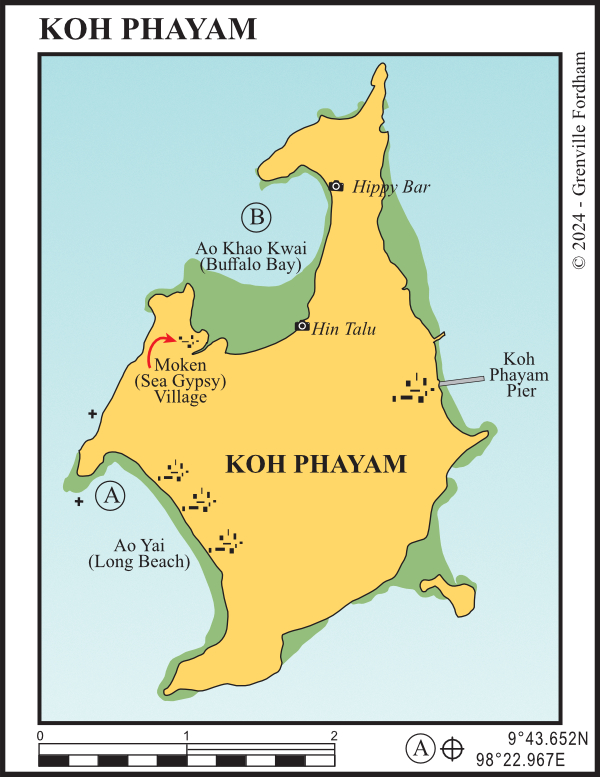
⇒ Depth: 6-10m on sand off the northern end of Ao Yai
⇒ Holding: Good holding
⇒ Protection: Best shelter from NE monsoon. Open to SW season swells.
Limited but improving. Motorbike rental (There are no cars on the island). Several beach restaurants, bungalow resorts and small shops. Fresh fruit and basics available in the village. No marina facilities – come provisioned.
Ao Yai’s sweeping 2km beach is perfect for long walks, while Ao Khao Kwai (Buffalo Bay) offers quieter anchorage and calm water. The island is known for its relaxed cafés, deserted beaches, yoga retreats and vibrant art scene.
Don’t miss the Hippie Bar at the far end of Ao Khao Kwai (entirely constructed from local driftwood) for sundowners. A round-the-island trip by motorbike is a must.
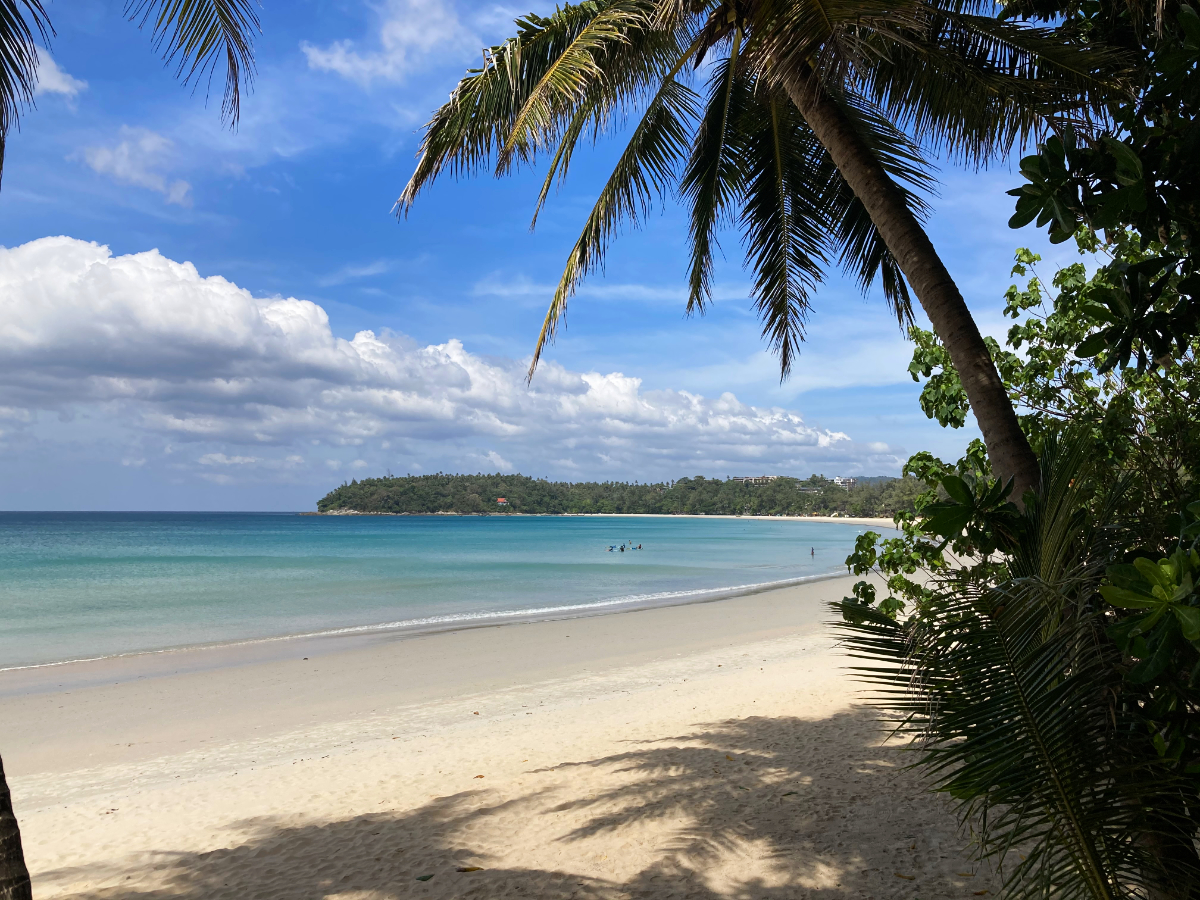
Southeast Asia Pilot – 7th Edition has detailed coverage of 600+ anchorages across nine countries. Available now in print and digital editions.
⇒ ⇒ ⇒ BUY Southeast Asia Pilot
Southeast Asia Pilot and Phuket Publicity Services do their best to ensure that the information on this website is accurate. However, good seamanship demands that seafarers check critical information carefully with relevant sources to ensure it is up to date.
Over the past decade, Southeast Asia has quietly emerged as one of the world’s most attractive playgrounds for superyachts. Once a niche destination, the region is now a serious contender in attracting superyacht tourism, alongside the Caribbean and the Med – and it’s easy to see why.
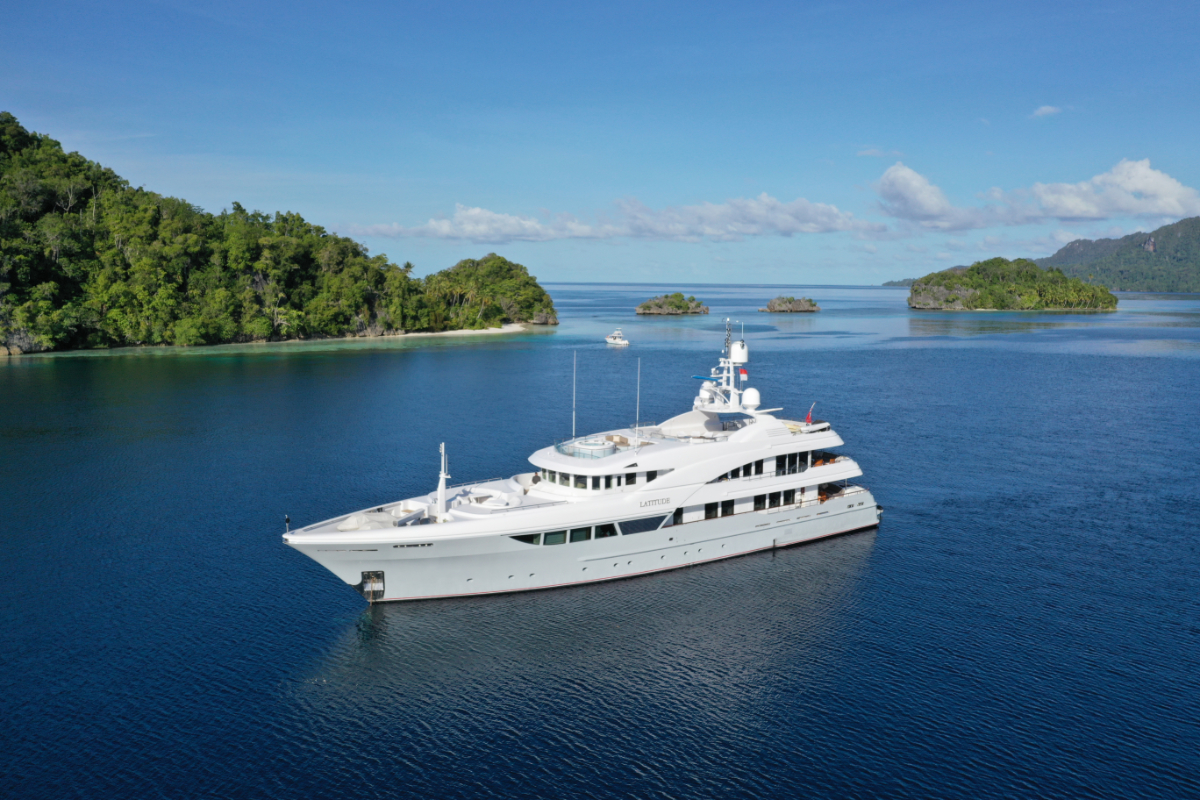
Marinas at Phuket, Pattaya, Langkawi – and the new Bali Gapura Marina (formerly Benoa Marina) – can accommodate superyachts between 75m to 100m. Vietnam’s newly opened Ana Marina Nha Trang should be able to handle yachts up to 70m. These facilities offer international-standard services – with technical support, chandleries and, in some cases, customs clearance.
⇒ Phuket Yacht Haven Marina: 100m+
⇒ Ocean Marina (Pattaya): 75m
⇒ Royal Langkawi Yacht Club: 80m
⇒ Bali Gapura Marina: 90m
The region straddles the Indian and Pacific Oceans. This makes it ideal for yachts repositioning between seasons. As a result, more and more owners and/or captains are planning ‘gap years’ in the region, spending six months cruising Thailand, Indonesia, Malaysia and Raja Ampat before heading back west.
Superyacht owners, guests and charterers demand exclusivity – and Southeast Asia delivers. Think private beach barbecues on uninhabited islands, diving in waters where you’re the only boat, or visiting tribal villages that rarely see outsiders.
There are still hurdles: inconsistent regulations, limited large-yacht repair yards and permit headaches. But the trend is undeniable – Southeast Asia is on every serious superyacht owner’s radar.
For owners, charterers and captains considering this region, Southeast Asia Pilot remains the definitive cruising guide. It details 600+ anchorages with shoreside tips and other useful insights across nine countries, from the Andaman Sea to the Spice Islands – with introductory notes on several more. Available now in print and digital editions.
⇒ ⇒ ⇒ Buy Southeast Asia Pilot
Southeast Asia Pilot and Phuket Publicity Services do their best to ensure that the information on this website is accurate. However, good seamanship demands that seafarers check critical information carefully with relevant sources to ensure it is up to date.Facebook
Southeast Asia Pilot – September 2025
Pulau Hatta in the Banda Islands group is a quiet anchorage with deep water and sheltered coves approximately 10 nautical miles from Banda Neira.
Picking up moorings at an anchorage, instead dropping your anchor, is increasingly necessary as authorities scramble to preserve coral. Where we suggest you pick up a mooring, be prepared to move if asked to do so by the mooring’s owner or a local authority. In some anchorages, you may find moorings that aren’t mentioned in these pages because they weren’t there when the anchorage was last surveyed. Whichever case, it’s your responsibility to check moorings in terms of their availability, condition and suitability for your yacht. Be aware that some moorings are suitable for small, light boats only.
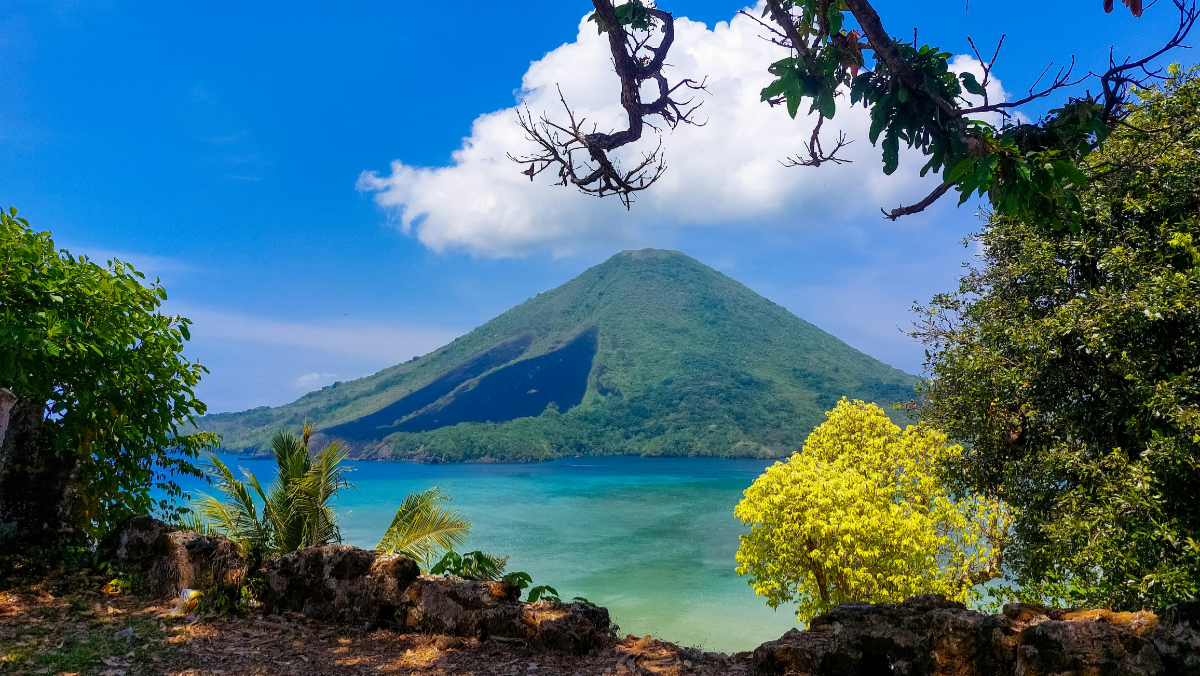
⇒ Depth: 15-25m generally on sand
⇒ Protection: Good, with ridges blocking most wind.
⇒ Facilities: Very limited (just one small shop) – but great for history lovers, divers and snorkellers
⇒ Activities: Two hiking trails to the hill tops for spectacular views
⇒ Beaches: Long deserted and undeveloped white sand beaches
⇒ Why we like it: A step back into history – spice-trade relics, rare corals, and minimal human footprint.
Southeast Asia Pilot – 7th Edition has detailed coverage of over 600 anchorages across nine countries. Available now in print and digital editions.
⇒ ⇒ ⇒ Buy Southeast Asia Pilot
Southeast Asia Pilot and Phuket Publicity Services do their best to ensure that the information on this website is accurate. However, good seamanship demands that seafarers check critical information carefully with relevant sources to ensure it is up to date.FacebookLinkedInInstagram
Southeast Asia Pilot – September 2025
Antibiotics used in the shrimp industry affect their efficiency in humans and result in antibiotic resistance, a global health threat. Non-native species of shrimp that escape into the wild impact native populations by transmitting diseases to, and competing with, native stocks. Industrial shrimp farming has been a major cause of destruction of mangrove wetlands, vital for wildlife and coastal fisheries. Enter The Sustainable Shrimp™ – a project so driven by love of the oceans that the Southeast Asia Pilot team just had to bring it to our readers’ attention.
The Sustainable Shrimp (Thailand) Company was born not in a boardroom, but underwater. Its founders, Frank van der Linde and Mark Shandur, were scuba divers in Phuket. They spent their lives exploring coral reefs and marveling at the biodiversity of the sea. They had also seen its decline: overfishing stripping the oceans bare, mangroves torn down for ponds, and antibiotics poured into shrimp farms. From those dives came a radical idea – what if we could enjoy shrimp without harming the ocean at all?
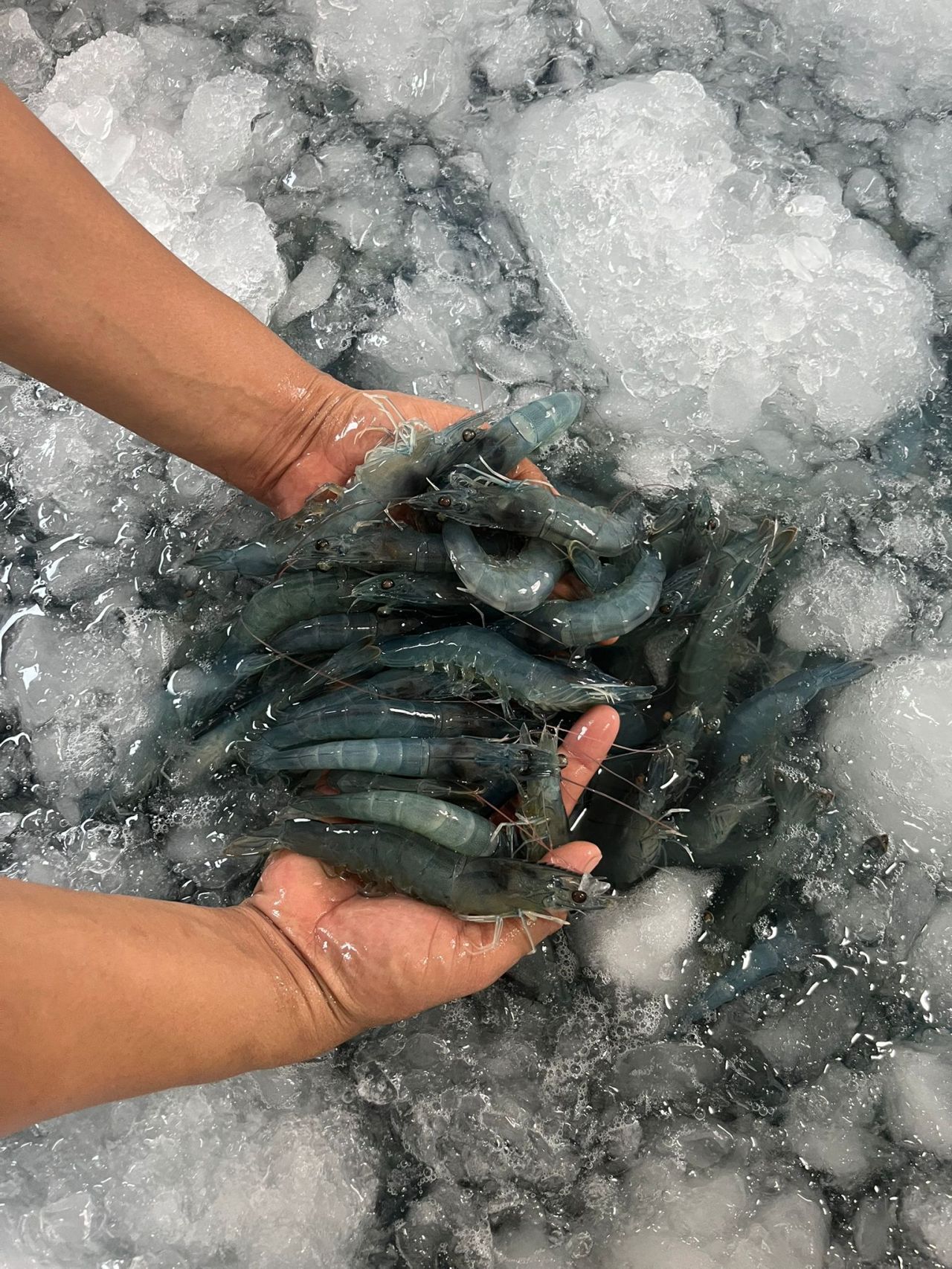
The journey began with land-based systems for raising marine fish, designed to prevent pollution and disease. But the deeper the divers looked, the more alarming the reality became. Aquaculture was one of the largest drivers of ocean depletion; millions of tons of wild fish are caught every year just to feed farmed species. And shrimp – already infamous for mangrove destruction, abandoned disease-ridden ponds, and poor environmental practices – was the worst culprit.
Something had to change. The divers knew that if shrimp could be farmed sustainably, it would prove that aquaculture could have a future. Thus, The Sustainable Shrimp™ was created – not as a marketing slogan, but as a promise.
The difference starts with how the shrimp are grown. Instead of open ponds, the company uses Recirculating Aquaculture Systems (RAS). These comprise high-tech tanks where water is constantly filtered through UV, ozone, and bio-systems until it is as pure as drinking water. No antibiotics, no escapes, no impact on mangroves. Covered tanks keep temperatures stable and diseases out, while the entire system can be reused endlessly without scarring the land.
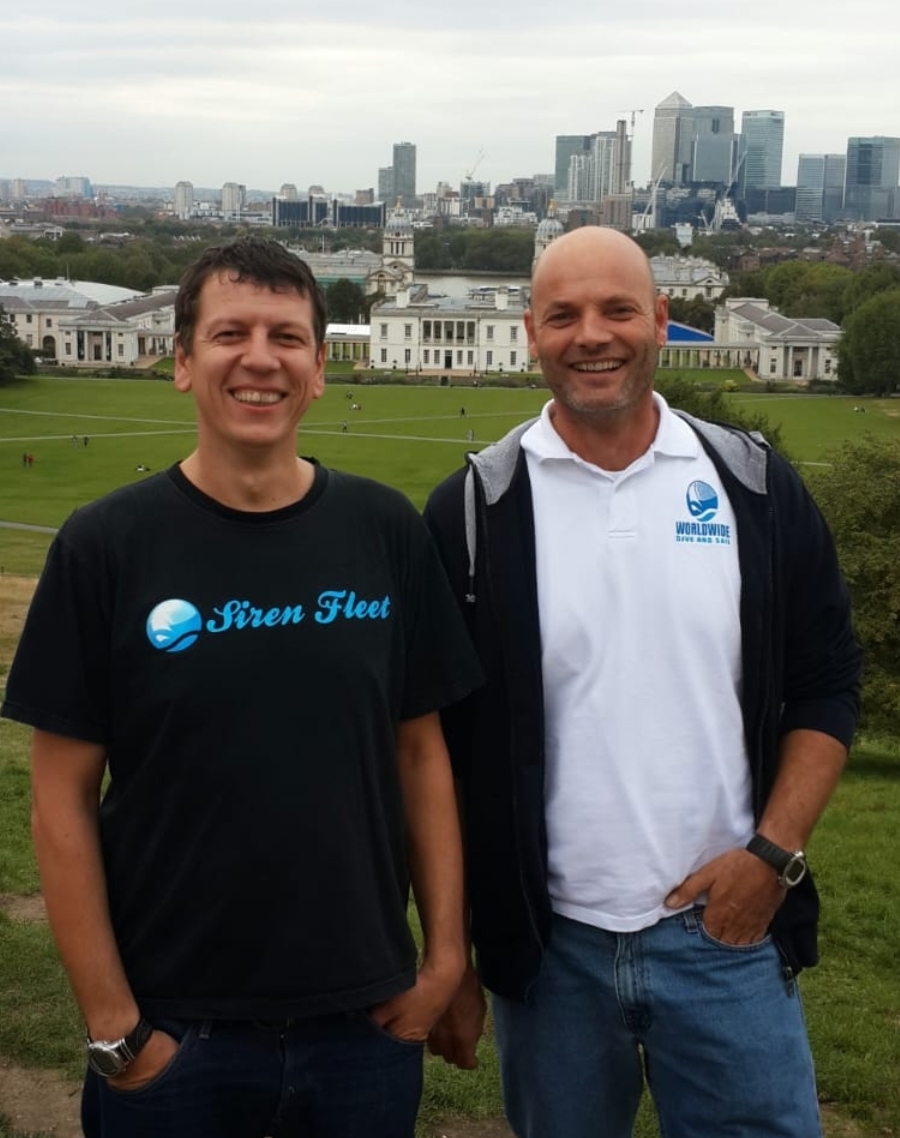
Just as important is what the shrimp eat. Conventional farms rely heavily on fishmeal and fish oil, accelerating the collapse of wild stocks. The Sustainable Shrimp™ took another path, developing its own feed made from insect larvae protein and algae oil – nutrient-rich alternatives that deliver the same Omega-3 benefits without taking a single fish from the sea. By 2026, every shrimp will be raised entirely on this diet, closing the loop of true sustainability.
What began as a small group of divers with a dream has grown into something much larger: a model for the future of shrimp farming. Scalable, replicable, and environmentally sound, The Sustainable Shrimp™ proves that it is possible to feed the world premium seafood without sacrificing the oceans.
For its founders, it is more than farming. It is a pledge to the seas they love – and a blueprint for how aquaculture can finally become part of the solution.
⇒ ⇒ ⇒ Return to Southeast Asia Pilot – 7th Edition.
⇒ ⇒ ⇒ ORDER Southeast Asia Pilot – 7th Edition in print or digital formats.
Southeast Asia Pilot and Phuket Publicity Services do their best to ensure that the information on this website is accurate. However, good seamanship demands that seafarers check critical information carefully with relevant sources to ensure it is up to date.FacebookLinkedInInstagram
Southeast Asia Pilot – September 2025
Pulau Padar, between Komodo and Rinca, is one of the most stunningly beautiful islands in Southeast Asia. A perfect stop before or after Komodo adventures.
Picking up moorings at an anchorage, instead dropping your anchor, is increasingly necessary as authorities scramble to preserve coral. Where we suggest you pick up a mooring, be prepared to move if asked to do so by the mooring’s owner or a local authority. In some anchorages, you may find moorings that aren’t mentioned in these pages because they weren’t there when the anchorage was last surveyed. Whichever case, it’s your responsibility to check moorings in terms of their availability, condition and suitability for your yacht. Be aware that some moorings are suitable for small, light boats only.
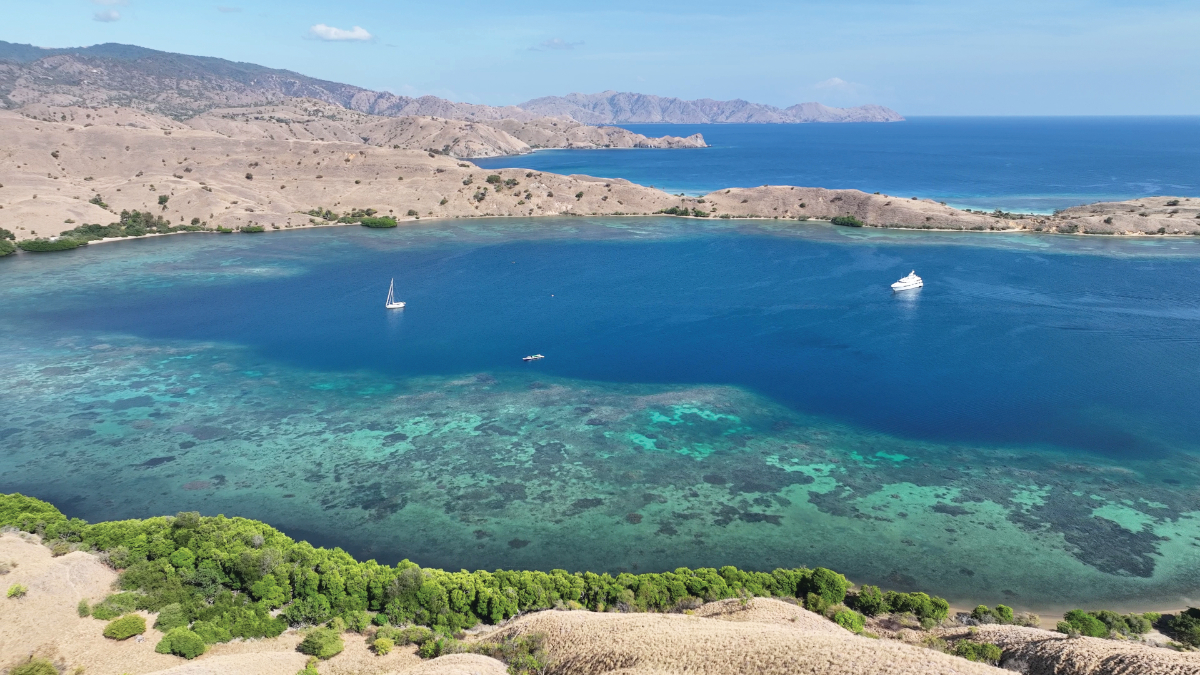
⇒ Depth: 10–30m on sand
⇒ Protection: Choose northern or southern end of the bay to suit the direction of the swell.
⇒ Facilities: Small local jetty
⇒ Activities: Two hiking trails to the hill tops for spectacular views
⇒ Beaches: Access only at high tide owing to fringing reef
⇒ Why we like it: A serene anchorage with deserted beaches and magical views.
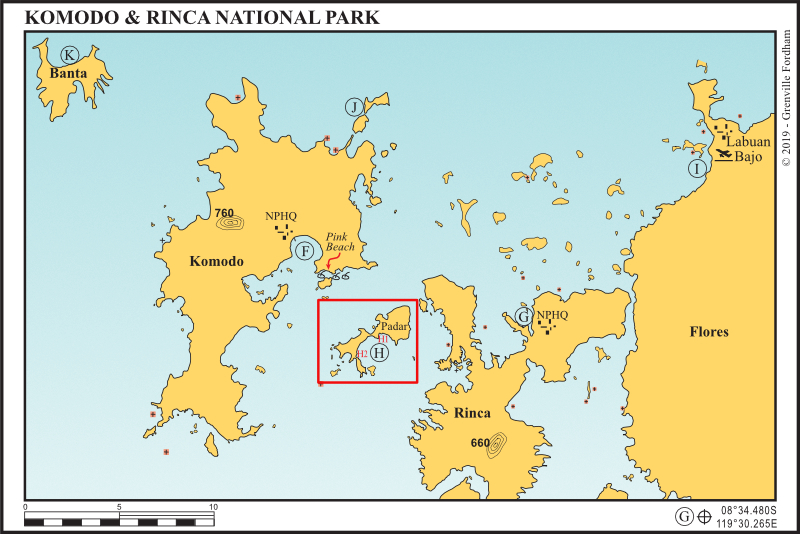
Southeast Asia Pilot – 7th Edition has detailed coverage of over 600 anchorages across nine countries. Available now in print and digital editions.
⇒ ⇒ ⇒ Order Southeast Asia Pilot
Southeast Asia Pilot and Phuket Publicity Services do their best to ensure that the information on this website is accurate. However, good seamanship demands that seafarers check critical information carefully with relevant sources to ensure it is up to date.FacebookLinkedInInstagram
Komodo National Park isn’t just home to the famous Komodo dragons – it also boasts pristine reefs, remote anchorages – and strict entry controls.
⇒ Permits Required: You must obtain national park permits before entry – available in Labuan Bajo.
⇒ Boat Fees and Conservation: Park fees fund rhino and reef conservation – make sure your visit contributes.
⇒ Anchor Smart: Use designated moorings when available. Otherwise anchor on sandy bottom. Anchoring is mostly prohibited and is policed.
⇒ Respect Wildlife: Keep distance from dragons and coral, limit noise and pack out all trash.
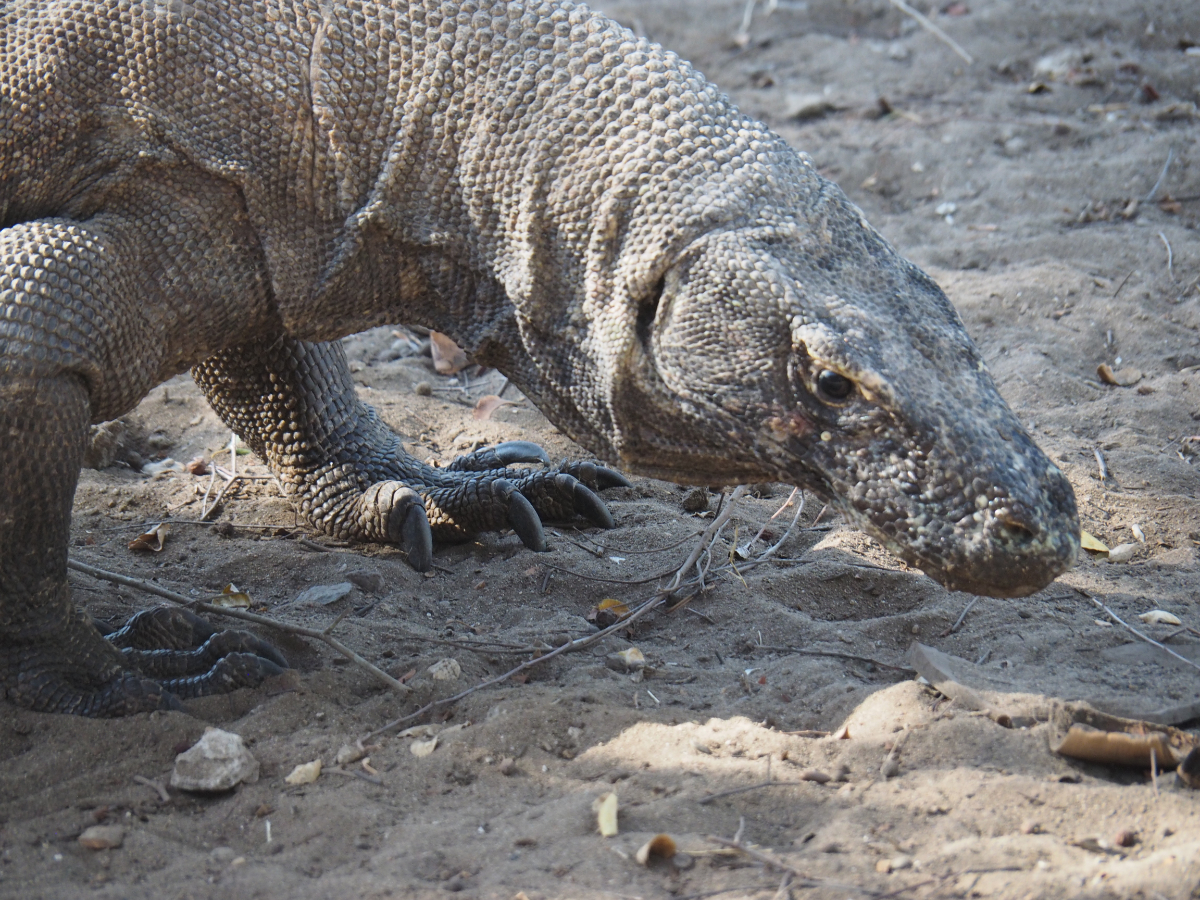
The islands of Komodo and Rinca are the only natural home of the legendary Komodo Dragons. A must-visit when cruising Indonesia. The Komodo group of islands are in the middle of the high-current channels between Flores and Sumbawa. Spectacular steep-sided bays deeply indent Komodo’s south coast. The You’ll find the National Park Head Quarters (Loh Liang) tucked away in the calm sheltered Sora Lia Bay mid-island on the southeast coast. Anchor near the moorings off the two jetties in 10-16 metres on a muddy bottom in front of the Ranger facility.
Onshore, report to the ranger station to buy your mandatory national park entrance permits. Guides are also mandatory and charges are levied for each camera in your group. When planning your walks, the longer you hike, the greater potential for seeing dragons. Always carry drinking water and wear good walking shoes.
There are many bays in this area, some with moorings (anchoring is mostly prohibited and policed) and some where the fishing, snorkelling and diving are pristine and alive with marine activity. At the southeast point of Sora Lia Bay you will find the world-famous Pink Beach, named because the shoreline consists of crushed red coral branches deposited by an updraft current in the deep channel area nearby.
There are many local people on boats here wanting to sell you their wares. They can be overly persistent and we recommend patience and kindness in your potential rejection of their sales techniques.
Across at Rinca Island is the very protected inlet anchorage of Loh Buaya. It’s right up the end of a narrow yet safe-depth, 250-metre wide mangrove lined waterway. On approaching the entrance, favour port side to keep well clear of the drying bank off the narrowing mouth. Motor the half mile south to 8°39.227S, 119°42.881E and anchor directly in front of the ranger station jetty in 10 metres on sand and mud.
This Park Ranger office is where Rinca dragon viewing hikes start and finish. In 2018 it was totally upgraded to handle the increasing traffic of dragon viewers. Rinca dragon viewing is superior to that of the Komodo island experience. There are fewer daily visitors, and more varied and spacious walks, allowing better dragon viewing opportunities. Best to anchor as close as you’re comfortable with and take your dinghy, leaving it tied on the local jetty away from the main traffic areas of local day boats.
For anchorage notes, charts, shoreside tips other useful information, see Southeast Asia Pilot – 7th Edition with detailed coverage of over 600 anchorages across nine countries, from the Andaman Sea to the Spice Islands. Available now in print and digital editions.
⇒ ⇒ ⇒ Order Southeast Asia Pilot
Southeast Asia Pilot and Phuket Publicity Services do their best to ensure that the information on this website is accurate. However, good seamanship demands that seafarers check critical information carefully with relevant sources to ensure it is up to date.FacebookLinkedInInstagram
Southeast Asia Pilot – September 2025
09°22.450N, 99°57.441E
Picking up moorings at an anchorage such as Koh Taen, instead dropping your anchor, is increasingly necessary as authorities scramble to preserve coral. Where we suggest you pick up a mooring, be prepared to move if asked to do so by the mooring’s owner or a local authority. In some anchorages, you may find moorings that aren’t mentioned in these pages because they weren’t there when the anchorage was last surveyed. Whichever case, it’s your responsibility to check moorings in terms of their availability, condition and suitability for your yacht. Be aware that some moorings are suitable for small, light boats only.
With a few bungalows and a restaurant ashore, Koh Taen is a pleasant and secluded overnight spot or an ideal day destination from the main island, Koh Samui. There are trails through the mangroves leading to bat caves ashore. Make sure to have provisions on board. The restaurant may be open only when the day trippers are about.
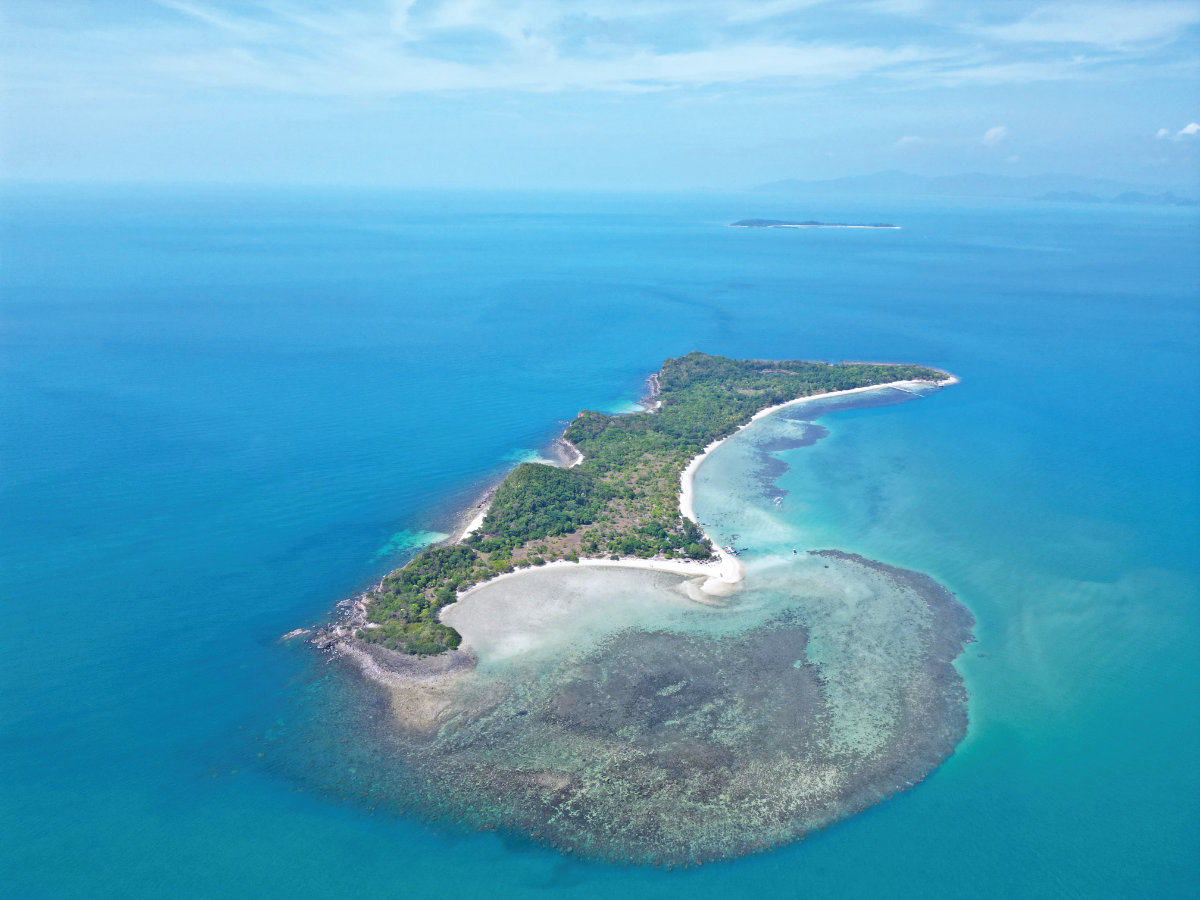
⇒ Approaching from the east, beware unmarked rocks just past Lamai Beach. Anchor between the islands in 5-6 metres on a muddy bottom, clear of the fringing reef on Koh Taen’s east coast. The approach from the west is clear and deep, following Koh Taen’s north coast.
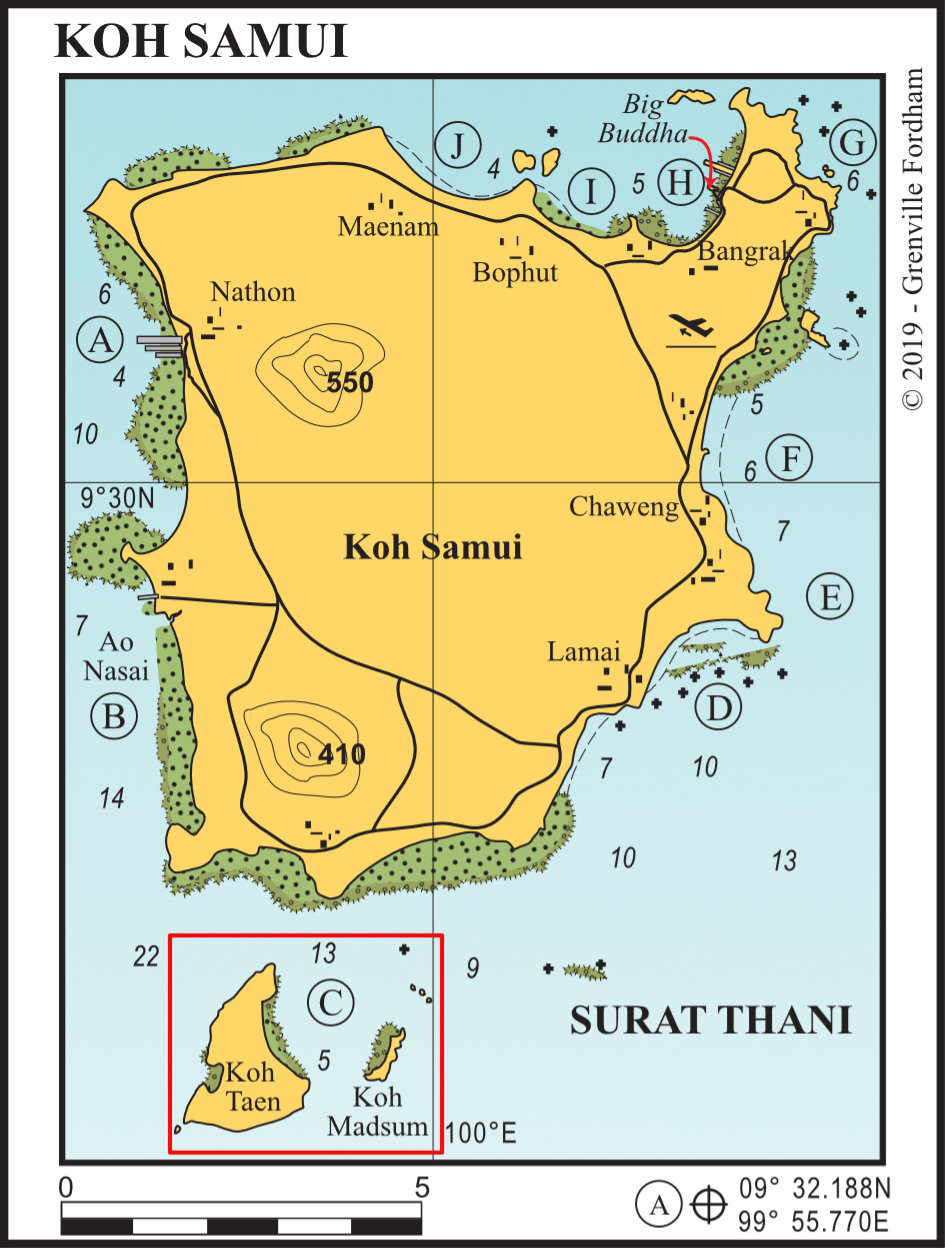
⇒ Koh Madsum (AKA Pig Island) is worth a visit too, with its long, pristine white sand beaches. Either go while the day trip hordes are on the island – it’s amusing to watch everyone trying to take selfies with the wandering ‘wild’ pigs while you sip an ice-cold beer at the Mad Sum Bar – or wait till they’ve gone by late afternoon and have it (and the pigs) all to yourself.
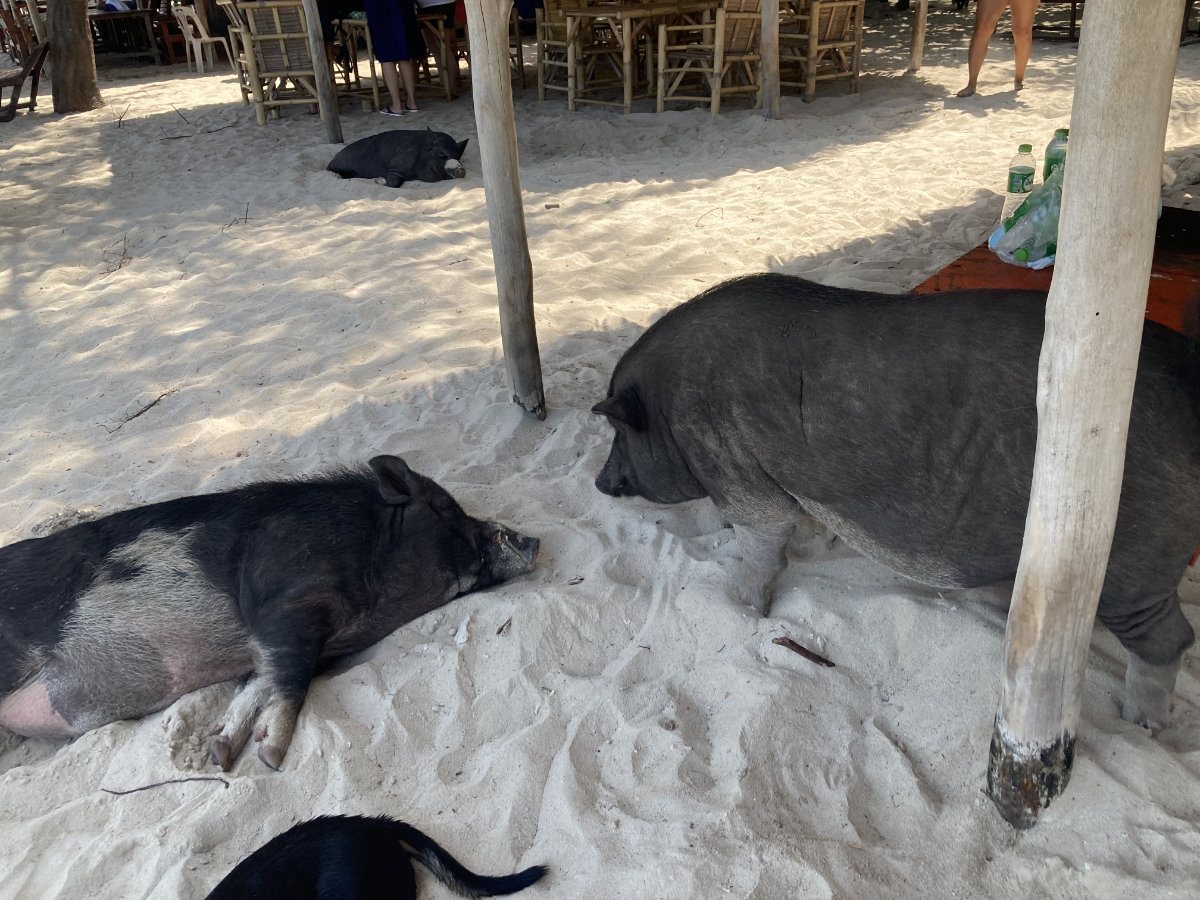
⇒ How did the pigs arrive on Koh Madsum? They didn’t always live there. For the low-down on how the pigs got to this tiny island, visit this link.
⇒ Southeast Asia Pilot – 7th Edition has detailed coverage of over 600 anchorages across nine countries. Available now in print and digital editions.
⇒ ⇒ ⇒ Order Southeast Asia Pilot
Southeast Asia Pilot and Phuket Publicity Services do their best to ensure that the information on this website is accurate. However, good seamanship demands that seafarers check critical information carefully with relevant sources to ensure it is up to date.FacebookLinkedInInstagram
Southeast Asia Pilot – September 2025
Southeast Asia’s cruising grounds are breathtaking. But they face increasing pressure from overtourism, coral damage and plastic pollution. Sustainable yachting is no longer optional – it’s essential.
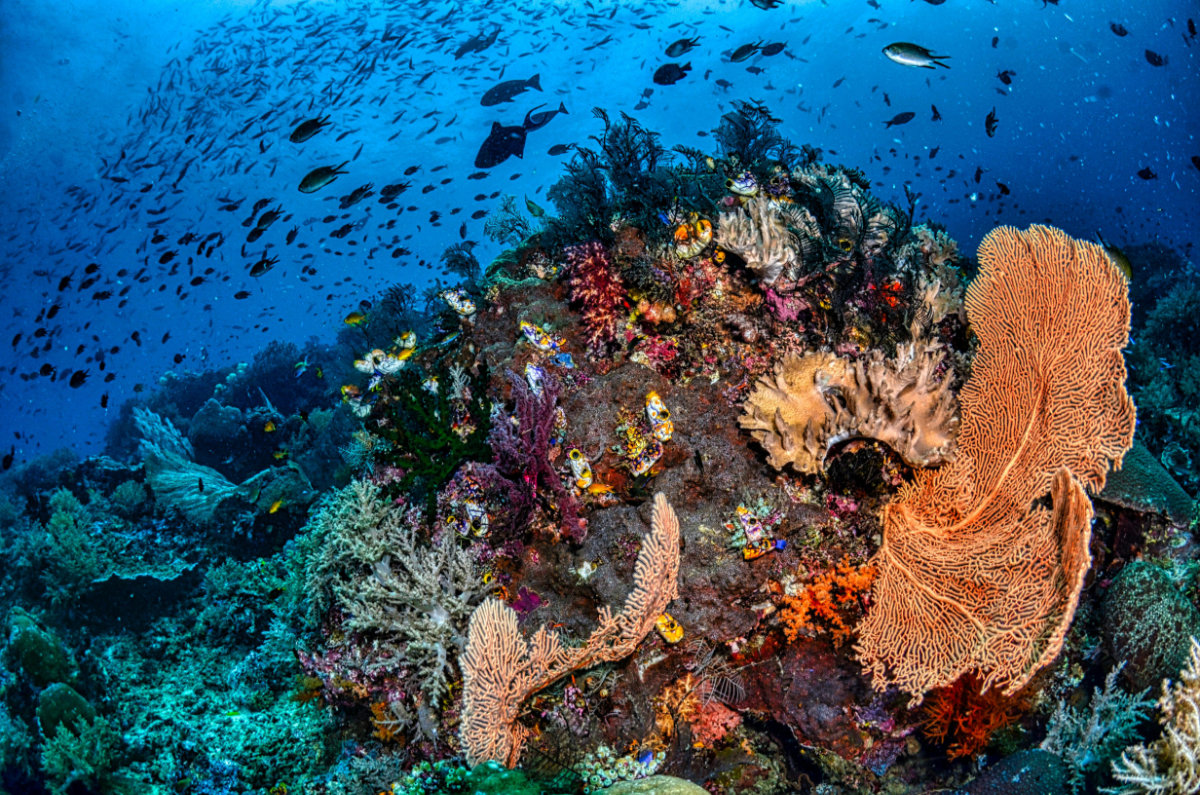
⇒ Use Reef-Friendly Anchoring: Whenever possible, pick sand anchoring spots or use mooring buoys. Protect the coral below.
⇒ Limit Single-Use Plastics: Swap bottled water for refillables and bring reusable shopping bags. Many ports now charge extra for plastic bags – or even ban them completely.
⇒ Support Eco-Conscious Businesses: Favour dive resorts and marinas with sustainability credentials. Many now partner with reef rehab programmes.
⇒ Leave It Better Than You Found It: Participate in beach clean-ups, adopt waste-minimizing habits onboard and educate crew and guests.
This is not just about preserving paradise. It’s about keeping yachting viable for future generations.
For anchorage notes, charts, shoreside tips other useful information, see Southeast Asia Pilot – 7th Edition with detailed coverage of over 600 anchorages across nine countries, from the Andaman Sea to the Spice Islands. Available now in print and digital editions.
⇒ ⇒ ⇒ Order Southeast Asia Pilot
Southeast Asia Pilot and Phuket Publicity Services do their best to ensure that the information on this website is accurate. However, good seamanship demands that seafarers check critical information carefully with relevant sources to ensure it is up to date.FacebookLinkedInInstagram
Southeast Asia Pilot – September 2025 poker run
Thursday, 11 December 2025
Registration is open for the 2025 Kata Rocks Poker Run (KRPR), Phuket’s high-octane nautical adventure.
Now in its 6th edition, luxury yachts and performance boats will circle the island, collecting playing cards at scenic checkpoints. The best poker hand wins.
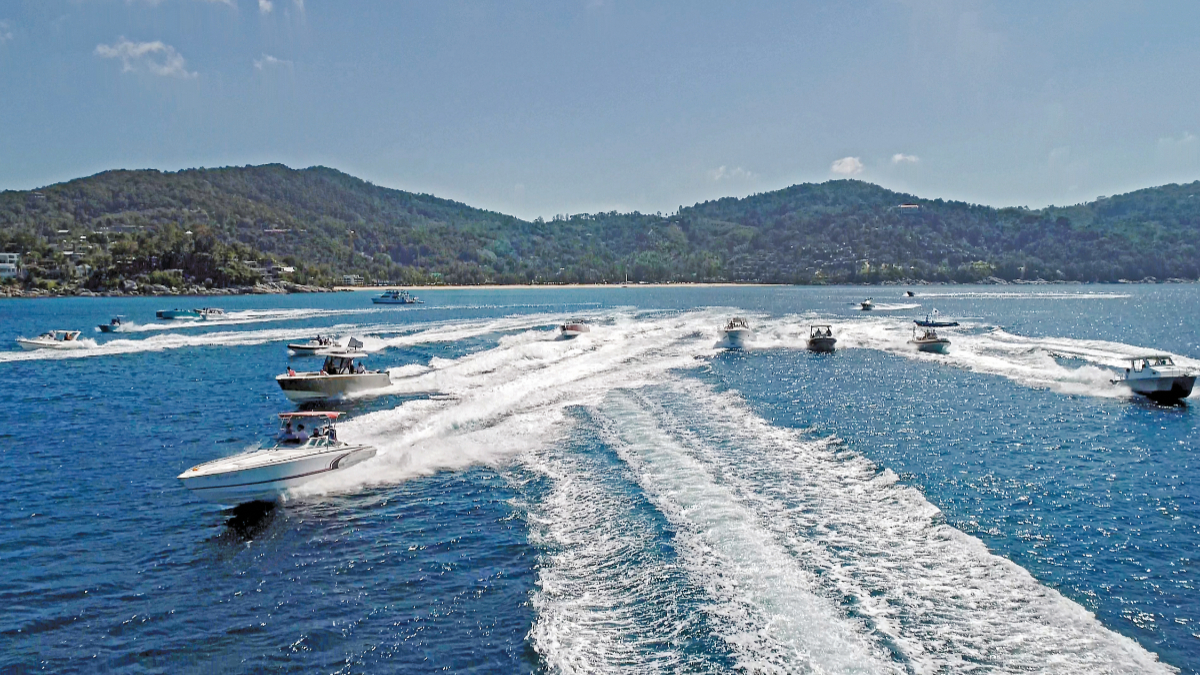
Over THB 10,000 of inclusions per person
⇒ Early bird entry fee priced at THB 3,000
⇒ Iconic around-the-island course with scenic checkpoints
⇒ Post-run BBQ & Drinks Awards Celebration at Kata Rocks
⇒ Exclusive ‘invite only’ access to the KRSR Closing Party (13 Dec)
⇒ KRPR 2025 T-shirt for every registered participant
⇒ Refreshments & snacks at checkpoints along the route
⇒ A full day of speed, style, and Miami Vice-inspired fun.
Southeast Asia Pilot is a proud media partner of KRPR
For anchorage notes, charts, shoreside tips other useful information, see Southeast Asia Pilot – 7th Edition with detailed coverage of over 600 anchorages across nine countries, from the Andaman Sea to the Spice Islands. Available now in print and digital editions.
Southeast Asia Pilot – September 2025
Mark your calendars: the 10th Anniversary Edition of the Kata Rocks Superyacht Rendezvous (KRSR) will take place 11–13 December 2025, hosted at the award-winning Kata Rocks Resort & Residences in Phuket.
Celebrating ten years of high-seas elegance, world-class networking, and signature luxury experiences, KRSR has established itself as one of Asia’s premier superyacht gatherings – an unmissable highlight on the global yachting calendar.
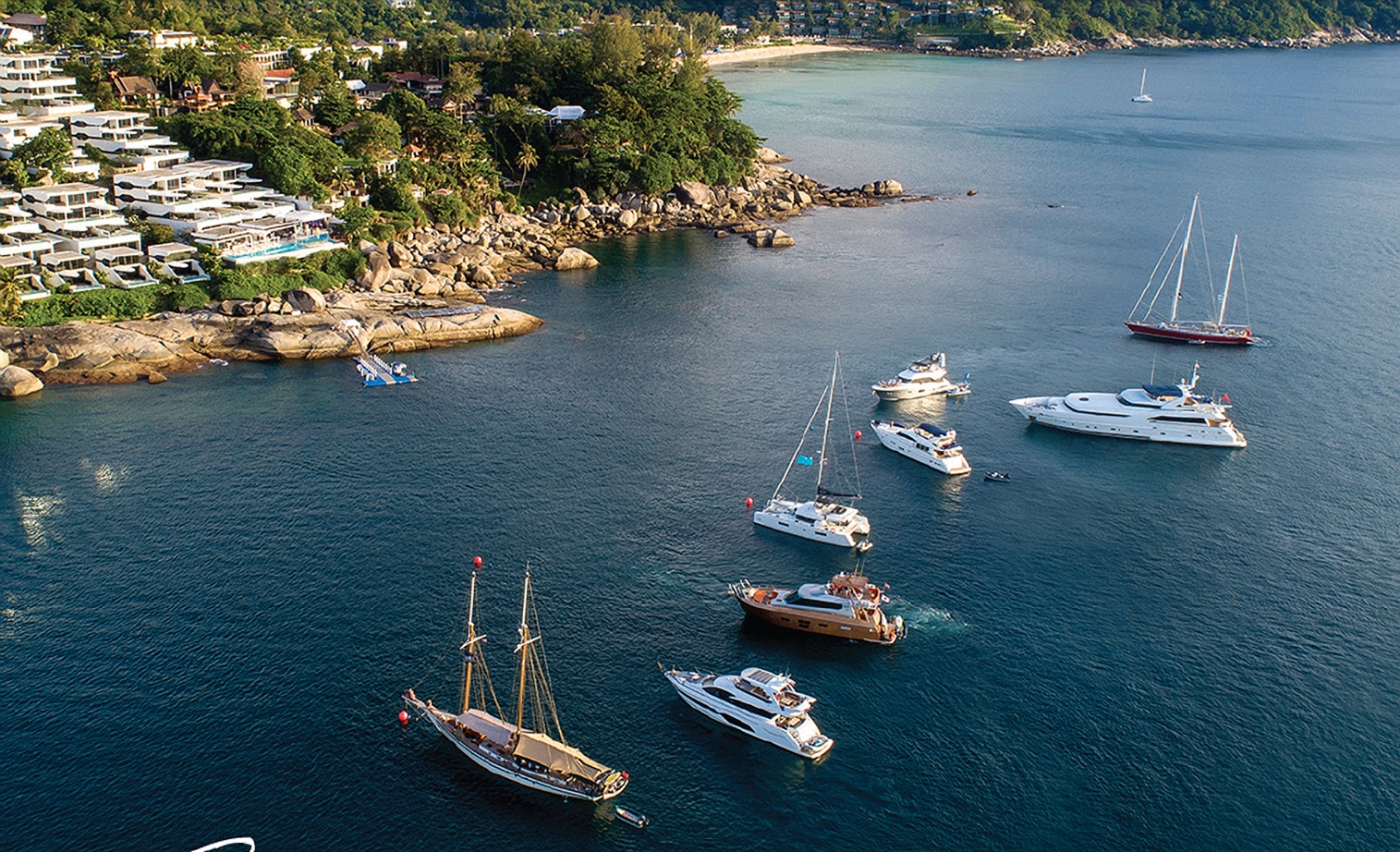
KRSR welcomes both sailing and motor yachts visiting or based in Phuket. The event signals the opening of Phuket’s luxury charter season, offering superyacht owners a prime opportunity to showcase their flagship vessels to an exclusive audience.
⇒ ⇒ ⇒ Register your interest
Southeast Asia Pilot is a proud media partner of KRSR
For anchorage notes, charts, shoreside tips other useful information, see Southeast Asia Pilot – 7th Edition with detailed coverage of over 600 anchorages across nine countries, from the Andaman Sea to the Spice Islands. Available now in print and digital editions.
Southeast Asia Pilot – September 2025
04°49.50N, 103°40.20E
Picking up moorings at an anchorage, instead dropping your anchor, is increasingly necessary as authorities scramble to preserve coral. Where we suggest you pick up a mooring, be prepared to move if asked to do so by the mooring’s owner or a local authority. In some anchorages, you may find moorings that aren’t mentioned in these pages because they weren’t there when the anchorage was last surveyed. Whichever case, it’s your responsibility to check moorings in terms of their availability, condition and suitability for your yacht. Be aware that some moorings are suitable for small, light boats only.
Pulau Tenggol is a jewel of Peninsular Malaysia’s east coast – steep cliffs, lush jungle and some of the country’s best dive sites. It’s well off the main yacht rally routes, making it an unspoiled, peaceful anchorage for those seeking quiet beauty.
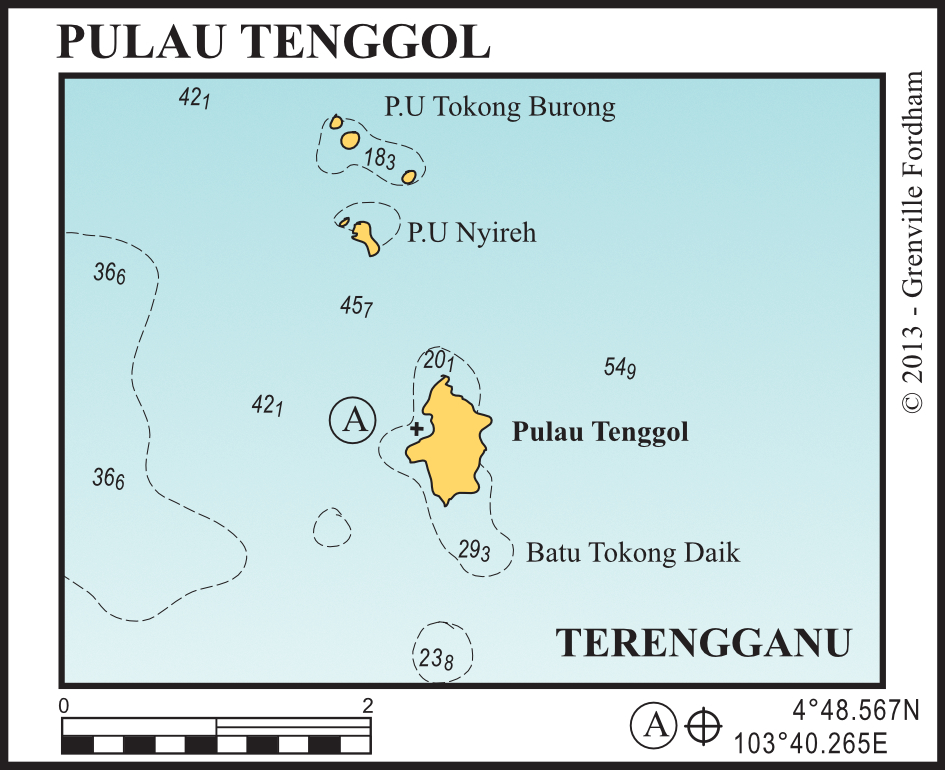
⇒ Depth: 10–15m on sand
⇒ Holding: Good in sand patches; avoid coral areas
⇒ Protection: Best during SW monsoon; exposed in NE monsoon
⇒ Hazards: Watch for strong currents near reef edges
⇒ No formal marina – dinghy to the beach
⇒ Small dive resorts offer meals and occasional fuel (arrange ahead)
⇒ Dive sites include Tokong Laut (Turtle Point) and Coral Garden
⇒ Excellent snorkelling right off the boat
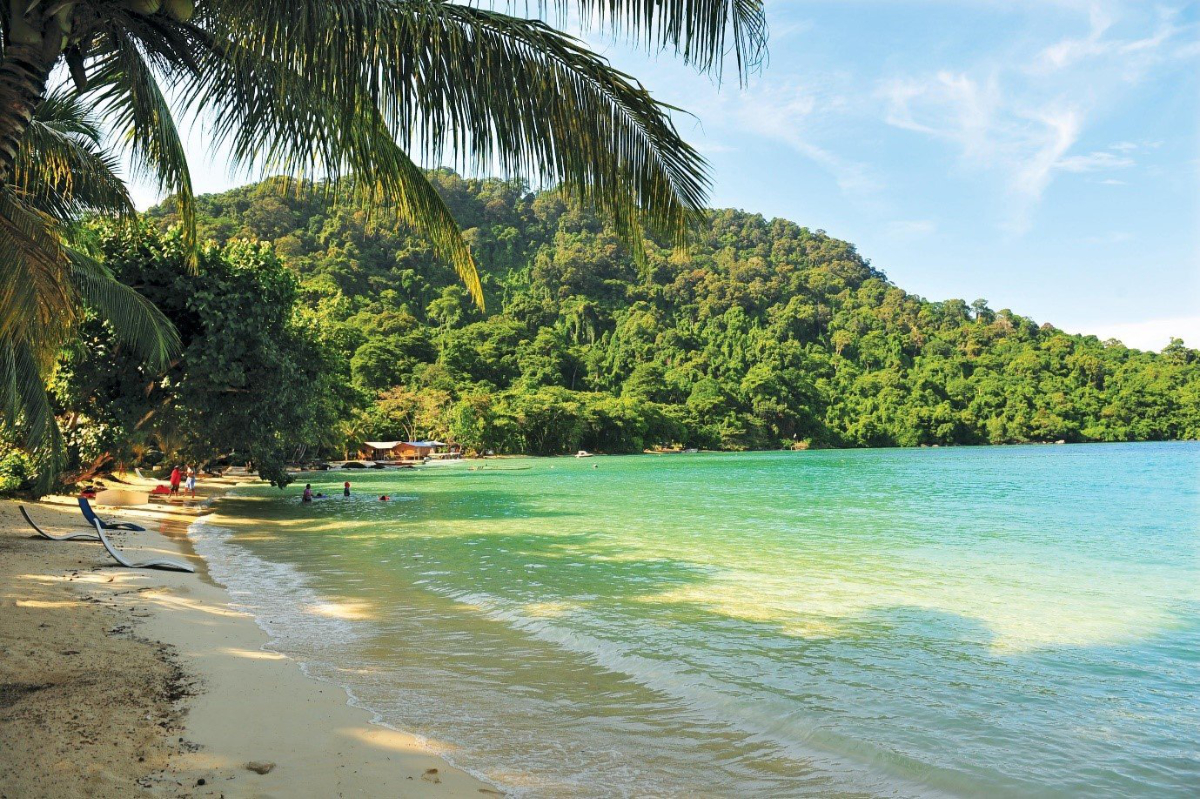
⇒ Quiet, natural beauty away from busy ports
⇒ Superb underwater life – turtles, reef sharks, and colourful soft corals
⇒ A restful pause before heading north toward the Perhentians or south to Tioman
Southeast Asia Pilot – 7th Edition has detailed coverage of over 600 anchorages across nine countries. Available now in print and digital editions.
⇒ ⇒ ⇒ Order Southeast Asia Pilot
Southeast Asia Pilot and Phuket Publicity Services do their best to ensure that the information on this website is accurate. However, good seamanship demands that seafarers check critical information carefully with relevant sources to ensure it is up to date.FacebookLinkedInInstagram
Southeast Asia Pilot – September 2025
Clever provisioning makes a difference. Cruising through Southeast Asia is an adventure in flavours, sights and – if you plan well – delicious meals onboard. But provisioning here isn’t the same as in the Med or Caribbean. You might find imported cheese in one port, and a week later be trading for fresh coconuts on a beach.
Here’s how to provision smartly, stay stocked and make the most of the region’s unique bounty.
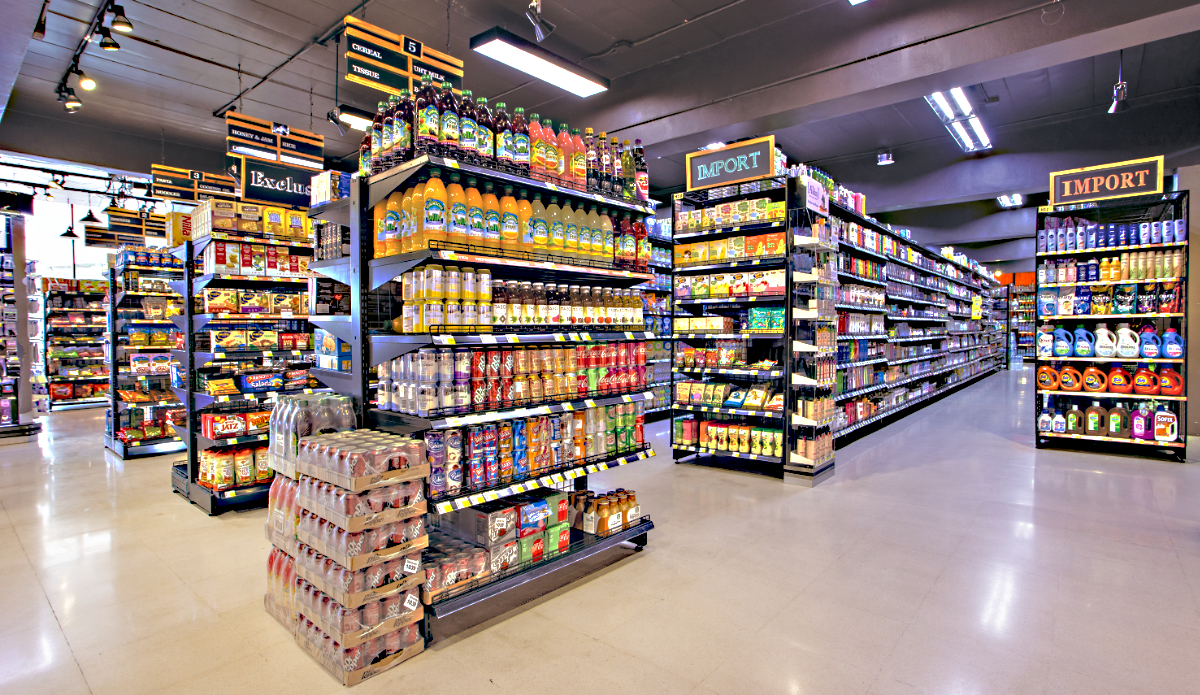
Some ports are better for stocking up than others. Our top provisioning hubs:
⇒ Langkawi, Malaysia – Duty-free everything, from wine to washing powder.
⇒ Phuket, Thailand – International supermarkets and excellent fresh markets.
⇒ Bali, Indonesia – Imported goods in Benoa; fresh fruit and vegetables from local pasar markets.
⇒ Davao, Philippines – Affordable bulk rice, coffee, and local produce.
In smaller towns, skip the minimart and head straight to the morning wet market. You’ll find:
⇒ Fresh-caught fish and prawns at dawn
⇒ Exotic fruits like rambutan, mangosteen, and dragon fruit
⇒ Aromatic herbs and spices for onboard cooking experiments
The tropical climate can turn lettuce to mush overnight.
⇒ Buy in smaller quantities and replenish often
⇒ Keep veggies dry and in cool, shaded spots
⇒ Vacuum-seal meat and freeze where possible.
Certain items can be tricky to find consistently:
⇒ Baking supplies (yeast, specialty flours)
⇒ Good-quality coffee
⇒ Your favourite condiments and sauces
If you see them – grab them!
Successful provisioning in Southeast Asia is part planning, part improvisation, and part culinary adventure. The reward? Fresh flavours, happy crew, and fewer last-minute dashes ashore.
For anchorage notes, charts, shoreside tips other useful information, see Southeast Asia Pilot – 7th Edition with detailed coverage of over 600 anchorages across nine countries, from the Andaman Sea to the Spice Islands. Available now in print and digital editions.
⇒ ⇒ ⇒ Order Southeast Asia Pilot
Southeast Asia Pilot and Phuket Publicity Services do their best to ensure that the information on this website is accurate. However, good seamanship demands that seafarers check critical information carefully with relevant sources to ensure it is up to date.FacebookLinkedInInstagram
Southeast Asia Pilot – August 2025
00°10.184N, 130°01.112E
Picking up moorings instead of anchoring is increasingly necessary as authorities scramble to preserve coral. Where we suggest you pick up a mooring, be prepared to move if asked to do so by the mooring’s owner or a local authority. In some anchorages, you may find moorings that aren’t mentioned in these pages because they weren’t there when the anchorage was last surveyed. Whichever case, it’s your responsibility to check moorings in terms of their availability, condition and suitability for your yacht. Be aware that some moorings are suitable for small, light boats only.
Wayag is the poster child for Raja Ampat’s beauty – jagged limestone karsts rising from turquoise lagoons, pristine beaches, and diving that’s among the best in the world. It’s remote, breathtaking, and unforgettable.
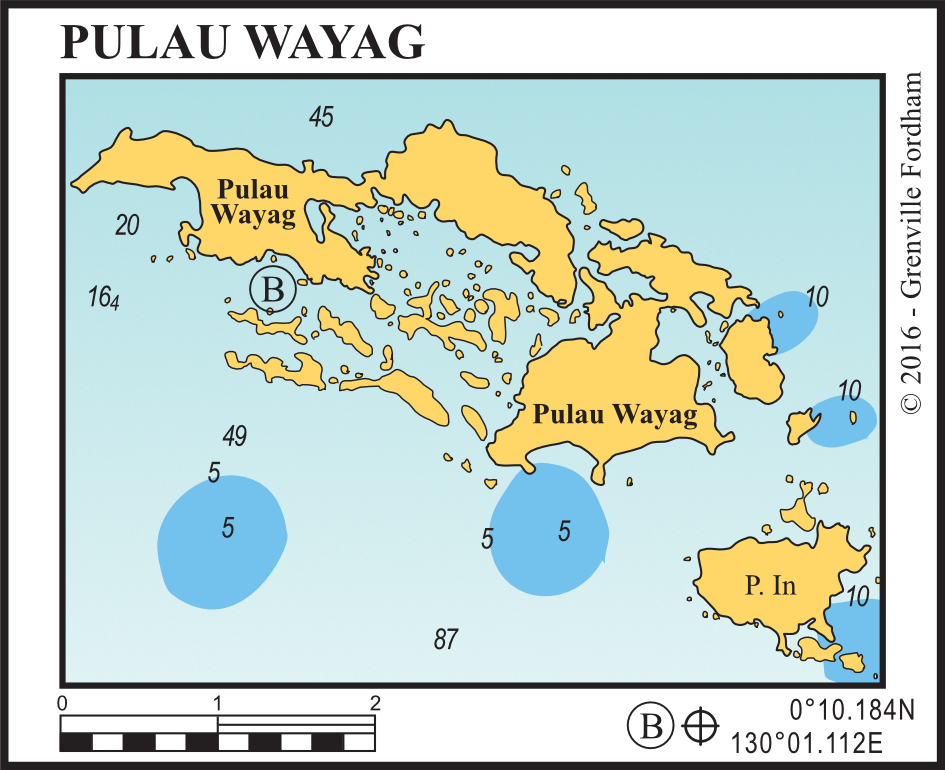
⇒ Depth: 15–20m on sand with scattered coral
⇒ Holding: Generally good in sand patches; avoid coral heads
⇒ Protection: Good in settled weather; exposed to strong NW winds
⇒ Hazards: Narrow lagoon entries with coral outcrops – best entered in good light
⇒ No shore facilities – pure wilderness
⇒ Climb the Wayag viewpoint for one of the most photographed panoramas in Indonesia
⇒ Snorkelling and diving directly from the boat – expect manta rays, reef sharks, and endless coral gardens
⇒ Visits now require a Raja Ampat Marine Park entry permit, obtainable in Waisai or Sorong
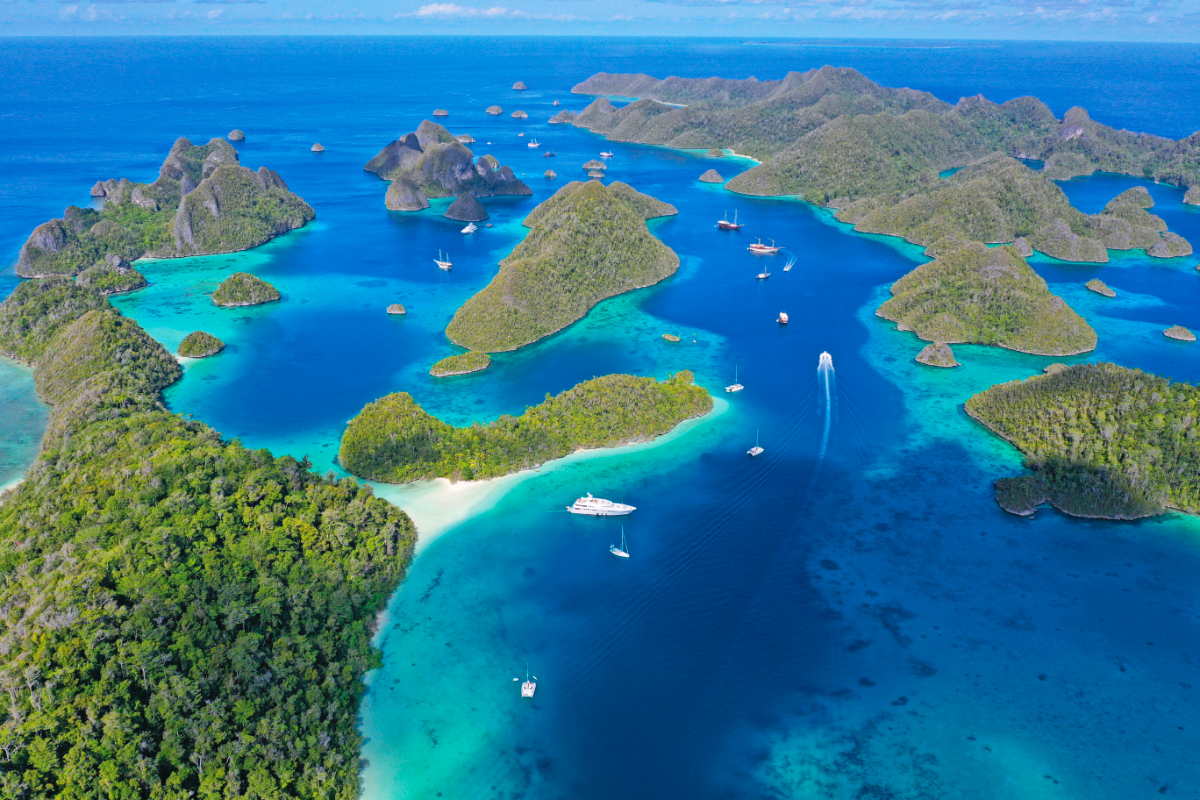
⇒ Remote and pristine – feels like true exploration
⇒ Incredible natural beauty both above and below water
⇒ A bucket-list stop for serious cruisers in Indonesia
Southeast Asia Pilot – 7th Edition has detailed coverage of over 600 anchorages across nine countries. Available now in print and digital editions.
Southeast Asia Pilot and Phuket Publicity Services do their best to ensure that the information on this website is accurate. However, good seamanship demands that seafarers check critical information carefully with relevant sources to ensure it is up to date.FacebookLinkedInInstagram
Southeast Asia Pilot – August 2025
Monsoons, microclimates & yachting safety
In many parts of the world, cruising is all about catching a fair wind and avoiding the occasional storm. In Southeast Asia, the stakes are higher. Here, the weather isn’t just background – it’s the stage manager for your entire voyage.
With two distinct monsoon systems, microclimates shaped by rugged coastlines and occasional tropical storms, timing your passages is just as important as plotting your course.
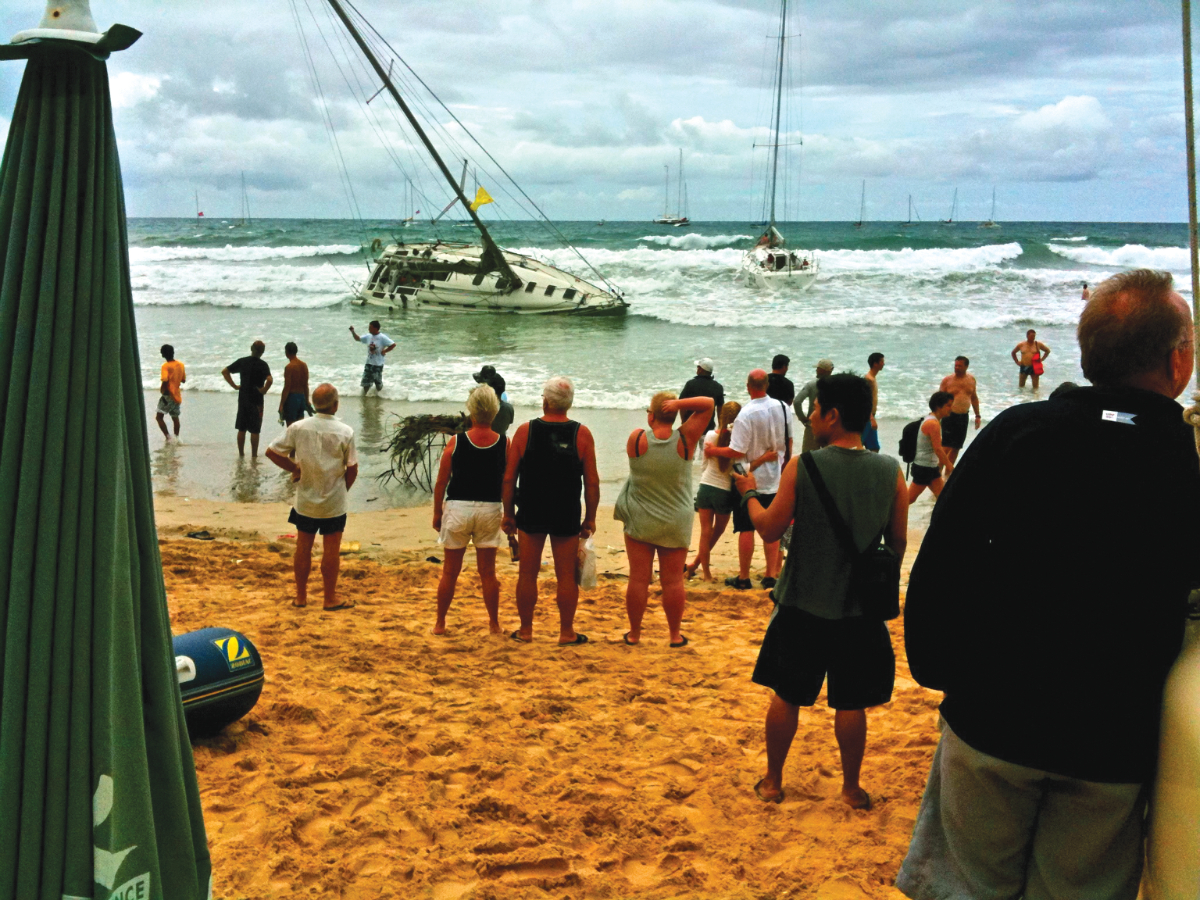
Northeast Monsoon (Nov–Apr)
⇒ Dry, cooler air dominates the Andaman Sea and Gulf of Thailand
⇒ Best for cruising Thailand’s west coast, Langkawi, and the Andaman Islands
⇒ Expect steady NE winds, calm seas on western shores, and occasional early-season squalls
Southwest Monsoon (May–Oct)
⇒ Warmer, wetter conditions prevail, especially in the Andaman Sea
⇒ The “dry” side shifts eastward – Indonesia’s eastern islands and the Philippines become prime cruising grounds
⇒ SW winds can bring swell and reduced visibility in the west
In Raja Ampat, a squall can roll in under blue skies. In Palawan, afternoon katabatic winds funnel down mountain slopes without warning. Always check multiple forecasts – and expect local quirks to override the models.
While rare in the equatorial zone, typhoons can affect the northern Philippines, South China Sea, and occasionally the Gulf of Thailand between June and November. Keep an eye on regional cyclone tracking during this period.
⇒ Plan your cruising route around monsoon patterns – don’t fight the seasons
⇒ Use local knowledge from marinas, fishing fleets and other cruisers
⇒ Factor in shelter options every 50-80 nm when passage making
The weather in Southeast Asia isn’t just something to “keep an eye on.” It’s the foundation for safe, comfortable, and memorable cruising.
For anchorage notes, charts other useful information, see Southeast Asia Pilot – 7th Edition with detailed coverage of over 600 anchorages across nine countries, from the Andaman Sea to the Spice Islands. Available now in print and digital editions.
Southeast Asia Pilot and Phuket Publicity Services do their best to ensure that the information on this website is accurate. However, good seamanship demands that seafarers check critical information carefully with relevant sources to ensure it is up to date.FacebookLinkedInInstagram
Southeast Asia Pilot – August 2025
06°21.46N, 99°41.20E
Picking up moorings instead of anchoring is increasingly necessary as authorities scramble to preserve coral. Where we suggest you pick up a mooring, be prepared to move if asked to do so by the mooring’s owner or a local authority. In some anchorages, you may find moorings that aren’t mentioned in these pages because they weren’t there when the anchorage was last surveyed. Whichever case, it’s your responsibility to check moorings in terms of their availability, condition and suitability for your yacht. Be aware that some moorings are suitable for small, light boats only.
Koh Rok Nok and Koh Rok Nai, part of the Mu Ko Lanta National Park, offer some of the clearest water in the Andaman Sea. With vibrant coral reefs, white sand beaches, and good holding in sand, it’s a favourite stopover for cruisers exploring the southern Thai islands.
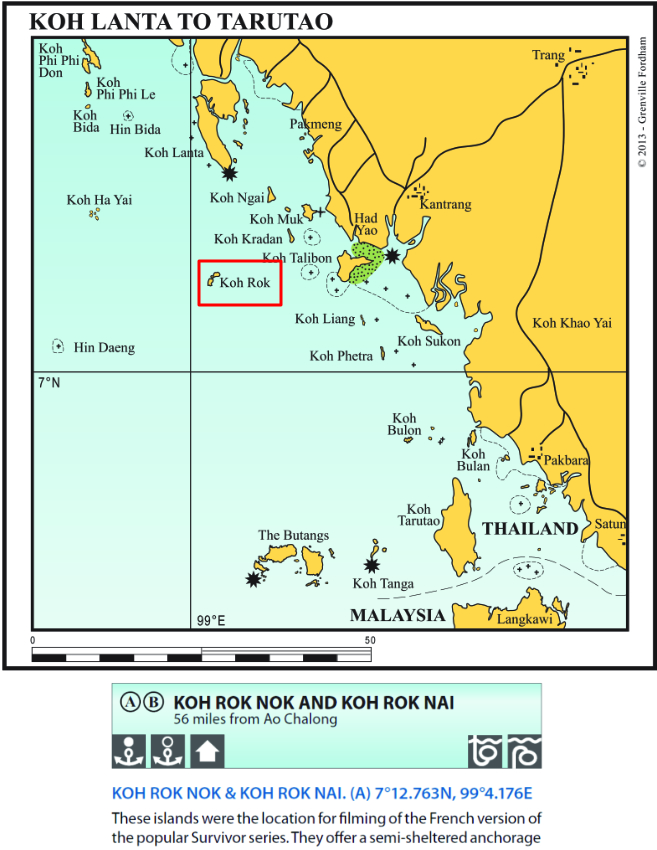
⇒ Depth: 8–12m on sand
⇒ Holding: Good, but check set as patches of coral are present
⇒ Protection: Best in NE monsoon; can be uncomfortable in SW monsoon
⇒ Hazards: Pick up a buoy if available. Otherwise don’t anchor too close to reef edges; snorkellers often in the water
⇒ Ranger station for National Park fee payment
⇒ Mooring buoys available to protect reefs
⇒ Good snorkelling right off the boat – giant clams, turtles, and healthy coral gardens
⇒ Small beach for picnics and short walks

⇒ Spectacular underwater visibility – often 30m+
⇒ Great lunch stop en route between Ko Lipe and Koh Lanta
⇒ Managed as a marine park, so reefs remain healthy
Southeast Asia Pilot – 7th Edition has detailed coverage of over 600 anchorages across nine countries. Available now in print and digital editions.
Southeast Asia Pilot and Phuket Publicity Services do their best to ensure that the information on this website is accurate. However, good seamanship demands that seafarers check critical information carefully with relevant sources to ensure it is up to date.FacebookLinkedInInstagram
Southeast Asia Pilot – August 2025
Southeast Asia offers some of the most rewarding cruising grounds in the world – hundreds of islands, diverse cultures, and year-round sailing if you plan correctly. But even seasoned skippers can make mistakes – by overlooking a few region-specific realities.
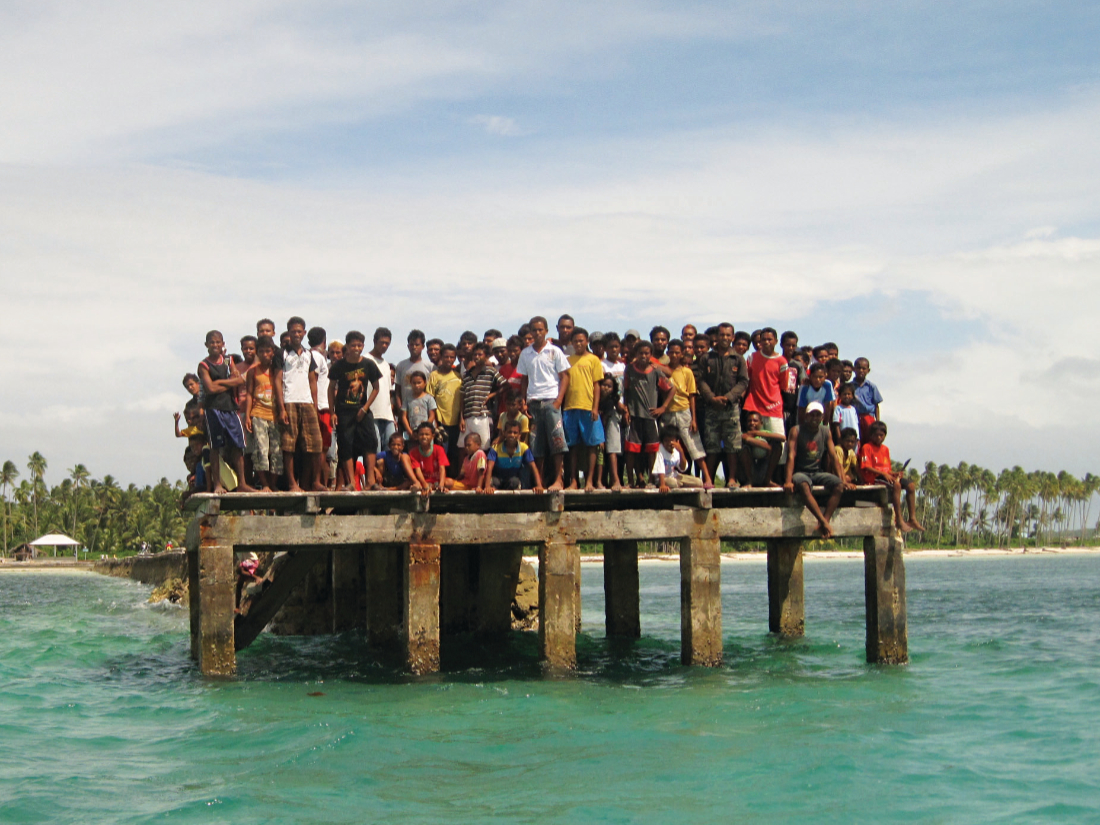
Here are the top five mistakes we see time and again, and how you can avoid them.
In Southeast Asia, seasons aren’t just about temperature – they dictate safety, comfort and where you can go. Ignore them at your peril.
⇒ Avoid: Sailing the Andaman Sea in August, or the southern Philippines during typhoon season.
⇒ Do: Use seasonal routing to follow the dry monsoon winds and dodge the storms.
Clearance here can be refreshingly simple – or baffling. Each country has its quirks, from mandatory AIS declarations to multiple paper copies of crew lists.
⇒ Avoid: Arriving without the right crew lists, boat documents, or prior notification where necessary.
⇒ Do: Keep multiple printed copies of your documents and digital backups.
In the Med, there’s always a chandler nearby. In Raja Ampat or the Andaman Islands, not so much.
⇒ Avoid: Waiting until something breaks in a remote anchorage.
⇒ Do: Stock spares, tools and critical consumables before leaving major ports.
Many Southeast Asian bays look perfect on a sunny afternoon – but can turn into washing machines if the wind shifts.
⇒ Avoid: Relying only on satellite images.
⇒ Do: Consult cruising guides and check for swell exposure and seasonal wind directions.
Cruising here means entering communities with deep traditions. What’s acceptable in one village may cause offence in another.
⇒ Avoid: Walking into a rural Muslim village in swimwear.
⇒ Do: Dress modestly ashore and learn a few greetings in the local language.
Southeast Asia rewards preparation. Know the seasons, respect local customs, carry your spares and your trip will be all smooth sailing.
For anchorage notes, charts other useful information, see Southeast Asia Pilot – 7th Edition with detailed coverage of over 600 anchorages across nine countries, from the Andaman Sea to the Spice Islands. Available now in print and digital editions.
Order at https://www.southeastasiapilot.com/order/
Southeast Asia Pilot and Phuket Publicity Services do their best to ensure that the information on this website is accurate. However, good seamanship demands that seafarers check critical information carefully with relevant sources to ensure it is up to date.
FacebookLinkedInInstagram
📍06°21.46N, 99°41.20E
Overview:
Telaga Harbour offers one of the most yacht-friendly anchorages on Malaysia’s northwest coast. With excellent holding in sand, straightforward entry, and access to customs and immigration, it’s a favoured stop for cruisers heading north to Thailand or south to Penang.
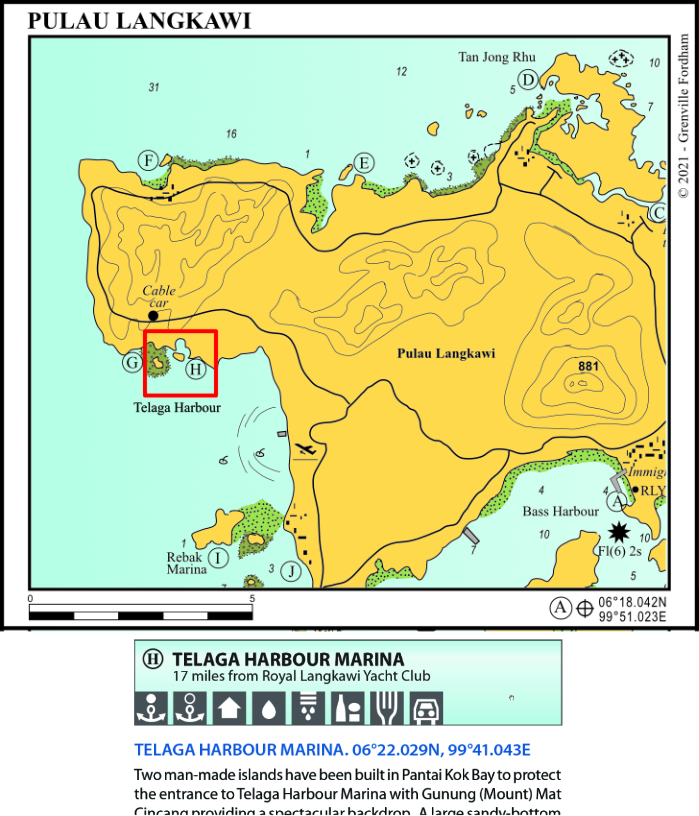
🌊 Anchorage Notes
Depth: 5–10m on firm sand bottom
Holding: Excellent
Protection: Good protection from most directions, though open to W/SW
Hazards: Reefs to the west and north—approach with caution using chart plotter
🛟 Facilities & Shore Access
Nearby fuel dock at the marina entrance
Water & electricity available at the dock (Telaga Marina, operated by Perdana Quay)
Provisioning: Duty-free shops and groceries 10 mins by taxi
Restaurants & cafes: Located along Perdana Quay boardwalk
Check-in/out services: Customs, immigration, and port authorities all within walking distance
🧭 Why We Like It
Efficient clearance process for both Malaysian and international boats
Easy dinghy access from anchorage to marina
Proximity to Langkawi International Airport (15 mins)
Good stop before or after Thai border clearance at Ko Lipe or Satun
📌 Southeast Asia Pilot – 7th Edition has detailed coverage of over 600 anchorages across nine countries. Available now in print and digital editions.
🔗 Order your copy here:
www.southeastasiapilot.com/order/
Southeast Asia Pilot and Phuket Publicity Services do their best to ensure that the information on this website is accurate. However, good seamanship demands that seafarers check critical information carefully with relevant sources to ensure it is up to date.
August 2025
As the world’s cruising grounds become increasingly regulated, crowded, and commercialised, Southeast Asia stands out as one of the last regions where true adventure, discovery, and freedom still thrive. With vast island chains, rich cultures, year-round sailing routes, and affordable services, it’s little wonder more yacht owners and charterers are turning their bows east.
Here’s why Southeast Asia might just be the last great frontier in global yachting—and why it deserves a spot on your chart plotter.
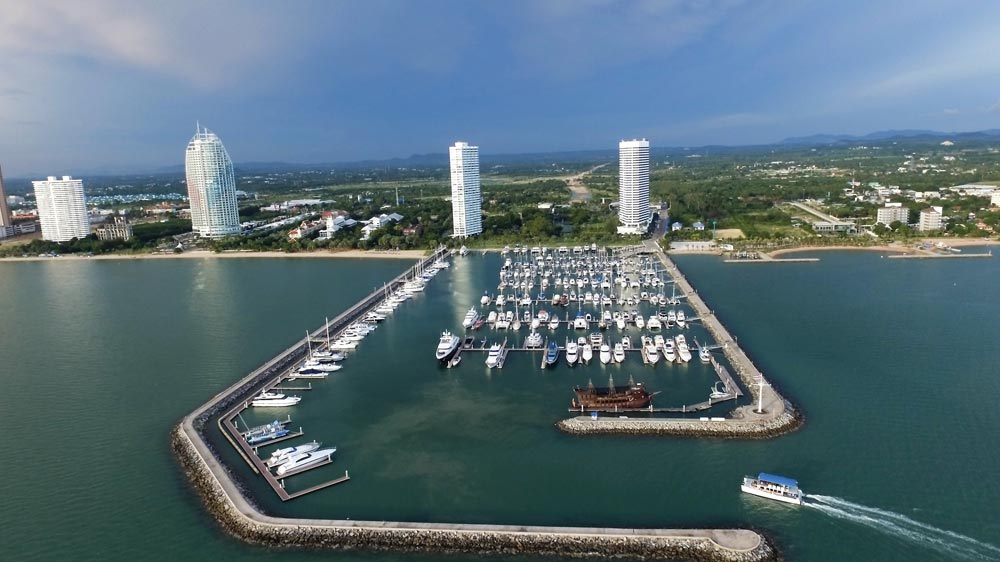
🌴 1. Untouched Cruising Grounds
From the turquoise waters of Thailand’s Koh Lipe to the remote, Jurassic splendour of Indonesia’s Wayag Islands, the sheer variety of anchorages in Southeast Asia is unmatched. Many areas—especially in Indonesia, the Philippines and The Andamans—see only a handful of visiting yachts each year.
That means fewer mooring fees, more freedom to explore, and plenty of room to drop the hook in peace.
🌤 2. Year-Round Cruising—If You Know Where to Go
Thanks to the region’s dual monsoon seasons, it’s always yachting season somewhere. You can cruise Thailand’s west coast and Langkawi from November to April, then hop over to Indonesia’s east coast or the Philippines for the dry season between May and October.
Southeast Asia Pilot helps you plan a smooth seasonal migration.
🛠 3. Better Marinas, Lower Costs
Thailand, Malaysia and Indonesia have seen impressive marina upgrades in recent years, often at a fraction of the cost you’d pay in the Med, the Caribbean or Australia. Many marinas offer haul-out services, bonded storage and technical support—plus easy access to airports and provisioning.
Langkawi (duty-free), Puteri Harbour, and Phuket Boat Lagoon in Thailand are especially popular bases for long-haul cruisers.
📜 4. Increasingly Yacht-Friendly Regulations
Cruising permits are still a patchwork, but efforts to streamline check-in/check-out procedures are showing results—especially in Indonesia, where the “CAIT” has been scrapped in favour of simpler systems. Malaysia remains one of the easiest countries in Asia for long-term yacht stays.
Keep your paperwork current, and most officials are friendly and professional—especially if you fly your Q flag properly and arrive with a smile.
🌐 5. Growing Rally Culture & Support Network
Events like Sail Malaysia, the Wonderful Sail 2 Indonesia rally, and the Spice Islands Darwin–Ambon race have helped build a supportive community of cruisers. There are now dozens of Facebook groups, WhatsApp channels, and marina-based networks offering updates on weather, paperwork, repairs, and local tips.
Cruising here might be off the beaten path—but you’re rarely alone.
⚓ Still a Frontier—But for How Long?
Cruising Southeast Asia is not without its challenges—language barriers, bureaucratic oddities and vast distances still keep things interesting. But that’s also what makes it so rewarding.
Whether you’re a seasoned passage maker or a new liveaboard, Southeast Asia is one of the last places you can still feel like an explorer.
📚 Want to know more?
Southeast Asia Pilot has detailed coverage of over 600 anchorages across nine countries, from the Andaman Sea to the Spice Islands. Available now in print and digital editions.
🔗 Order at https://www.southeastasiapilot.com/order/
Southeast Asia Pilot and Phuket Publicity Services do their best to ensure that the information on this website is accurate. However, good seamanship demands that seafarers check critical information carefully with relevant sources to ensure it is up to date.

Blog – Featured anchorages and other things
Nov 2025 Provisioning for remote cruising
Nov 2025 Featured anchorage – Koh Muk
Nov 2025 Weather windows & monsoon seasons
Oct 2025 Hazardous Marine Life (Part 2)
Oct 2025 Hazardous Marine Life
Oct 2025 Featured anchorage – Banda Neira
Oct 2025 Chartering in Indonesia
Oct 2025 Featured anchorage – Koh Tarutao
Oct 2025 Thailand’s Marine Parks
Oct 2025 Featured anchorage – Labuan Bajo
Oct 2025 Art of Passage Planning in SE Asia
Oct 2025 Featured anchorage – Koh Phayam
Sep 2025 Superyacht Tourism in SE Asia
Sep 2025 Featured anchorage – Pulau Hatta, Banda Islands
Sep 2025 The Story of The Sustainable Shrimp™
Sep 2025 Featured anchorage – Pulau Padar, Indonesia
Sep 2025 Komodo & Rinca National Park
Sep 2025 Featured anchorage – Koh Taen & Koh Madsum
Sep 2025 Sustainable Yachting
Sep 2025 Kata Rocks Poker Run (KRPR)
Sep 2025 Kata Rocks Superyacht Rendezvous (KRSR)
Sep 2025 Featured anchorage – Pulau Tenggol, Malyasia
Sep 2025 Provisioning Like a Pro
Aug 2025 Featured anchorage – Wayag, Raja Ampat
Aug 2025 Why Weather Matters More Here
Aug 2025 Featured anchorage – The Rok Island Group
Aug 2025 Mistakes that cruisers make
Aug 2025 Featured anchorage – Telaga Harbour
Aug 2025 Is Southeast Asia the Last Great Yachting Frontier?
Jan 25 Andaman Islands chapter ⇒ Free PDF download
Facebook
This information is offered in good faith and is based on the latest advice from locals involved in the business of yachting in Malaysia at the time we updated the 7th Edition. We can’t guarantee the accuracy or the current validity of this information. You are always advised to check the latest requirements with either a local agent or the Malaysian maritime and national park authorities rather than online forums. While forums are useful and interesting, you’ll often find conflicting advice based on individual experiences which may, or may not, contain every detail of incidents referred to.
Ships’ documents and valid passports for all crew members must be carried to gain entry into Malaysia. Most international visitors will be granted a tourist visa on entry. This is valid for 60 days and extendable by up to three months. As of 1st December 2023, Immigration recommends that all persons entering Malaysia fill in a Malaysian Digital Arrival Card (MDAC) online up to 3 days before arriving and clearing in. This document can be found at https://imigresen-online.imi.gov.my/mdac/main?registerMain.
This is an effort by the government to streamline digital Autogate Facilities for foreigners, especially multi-visit individuals arriving by air and ferry. At the time of print Digital Autogate is offered to passport holders of 10 nationalities. Individuals from these 10 countries are invited to register and once ratified by an immigration officer on first arrival, can use Autogate facilities for all subsequent visits. Although this requirement is not yet mandatory for yacht crew clearing into Malaysia, we strongly recommend visiting yachts fill out the on-line forms for each crew member and register in advance. It will certainly help streamline the process.
Yachts entering Malaysian waters on the Malacca Straits side should proceed to the nearest port of entry.
From Singapore north these are Puteri (pronounced Poo-tree) Harbour – 5 miles past the Tuas 2nd Link bridge in the west Johor Strait – Malacca, Port Dickson, Port Klang, Lumut, Penang and Langkawi.
Yachts entering east side of Peninsular Malaysia through the South China Sea from Singapore can clear into Malaysia close by at two international ferry terminals with Customs, Immigration and Quarantine (CIQ) facilities.
These are located in the East Johor Strait, seven miles from Changi Village at Tanjung Belungkor Ferry Terminal – in the mangrove channel north of Pulau Tekong – and at Pengileh Ferry Terminal Pengarang east of Pulau Tekong just south of the Malaysian Navy base. Visiting vessels that intend to steam further east to Senibong Cove Marina are required to first clear into Malaysia at Belungkor or Pengileh CIQ.
Opportunities to check in much further up the South China Sea coast are located at Desaru Coast Ferry Terminal, Tioman Island, Kuantan, Kuala Terengganu and Kota Bharu.
Yachts making passage past ports on either coast are unlikely to be challenged as long as ships papers are in order and they are heading for Thailand or another local port of entry. Visiting yachts should always report to Marine Harbourmaster, Immigration, and Customs in that order.
On leaving the port, this process needs to be repeated and a port clearance document for the vessel and crew obtained even if you are heading for another destination in Malaysia. Most officers will facilitate both on the same day if required.
Since the new government came into power in 2018 there have been occasional ‘sticky’ new policy interpretations of old and new pleasure yacht marine transit laws. Some on-line forums have complained of recent clearing in and out procedural headaches for visiting yachts.
For instance, in Langkawi Marine Department officers insist that an agent must facilitate all ‘Motor Boats’ over 24 metres, including some smaller sailing catamarans. Malaysian Marine Department is currently undergoing sweeping changes in personnel and procedures, including those for foreign yachts and crews.
We’ve been assured that the changes (when fully implemented) are designed to assist free passage and support foreign yachts cruising or parked within Malaysian territories without compromising the safety and security of the nation’s sovereign waters. At the time of writing foreign yachts can still be left periodically in Malaysian marinas and the formalities involved for vessels and crew are relatively simple compared with other countries in the region.
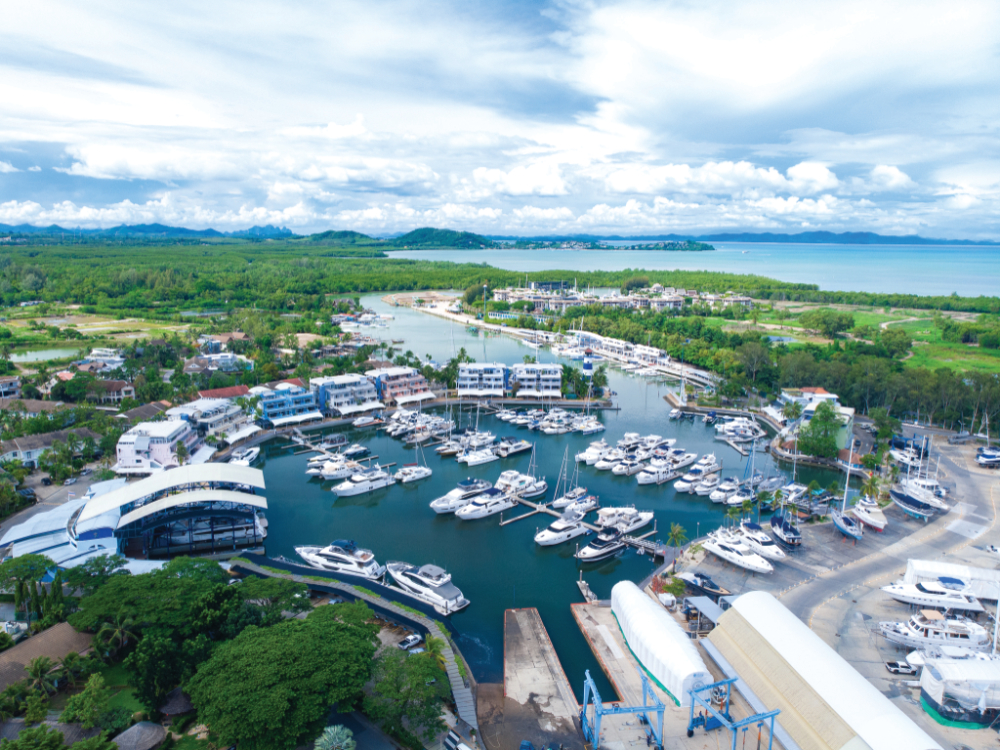
As the saying goes, “Necessity is the mother of invention” and that is how the history of Thailand’s first and premier marina – Phuket Boat Lagoon – started 30 years ago. Now Phuket Boat Lagoon is Phuket’s first integrated marina complex.
This development, which today is a fully developed ‘Lifestyle Marina Village’, is the brainchild of the Founder and Chairman, Khun Kanit Yongsakul.
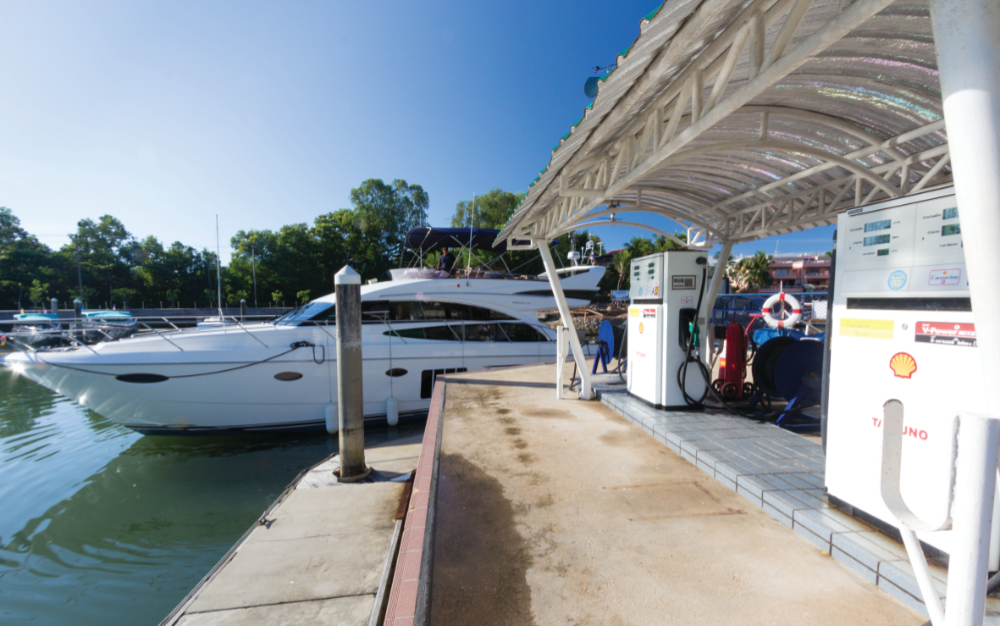
Officially opened in 1994, the marina is situated at the end of a two-mile creek, Klong Tha Rua, on the east coast of Phuket in southern Thailand. The circular marina provides moorings for vessels up to 32 metres long. Most sailors consider the complex to be on par with other leading marinas across the globe.
Located strategically in the centre of Phuket Island, traffic from the international airport, using the main highway, must pass our entrance to get to Phuket town or the west coast beaches. We are 25 km from the airport, 10 km to Phuket town, and 20 km to Kata, Karon and Patong beaches.
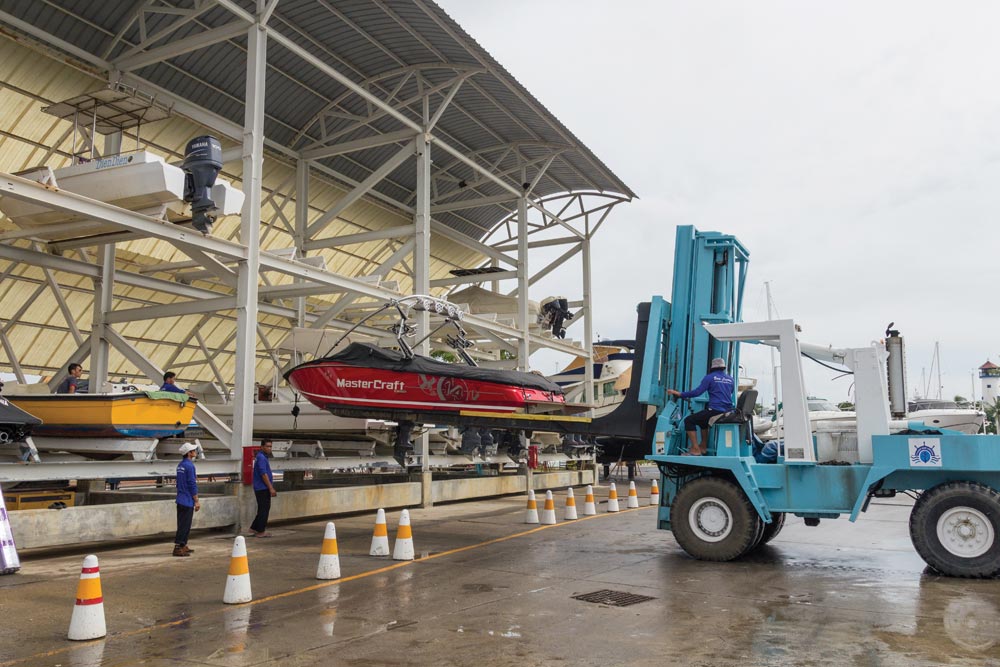
Phuket Boat Lagoon was intended to be a marina first; then, with increased demand and need, hardstand facilities were introduced with travel lift services.
“We are focused on being the region’s leader, in the boating and hospitality industry. We aim to excel in our core businesses, which are boating and lifestyle retail, by providing the quality standard for the community that we care for”, says Boon Yongsakul, Managing Director of Phuket Boat Lagoon.
As the marine industry in Thailand took a greater step, with Phuket becoming the region’s hub, vast opportunity was shining for Phuket Boat Lagoon’s expansion.
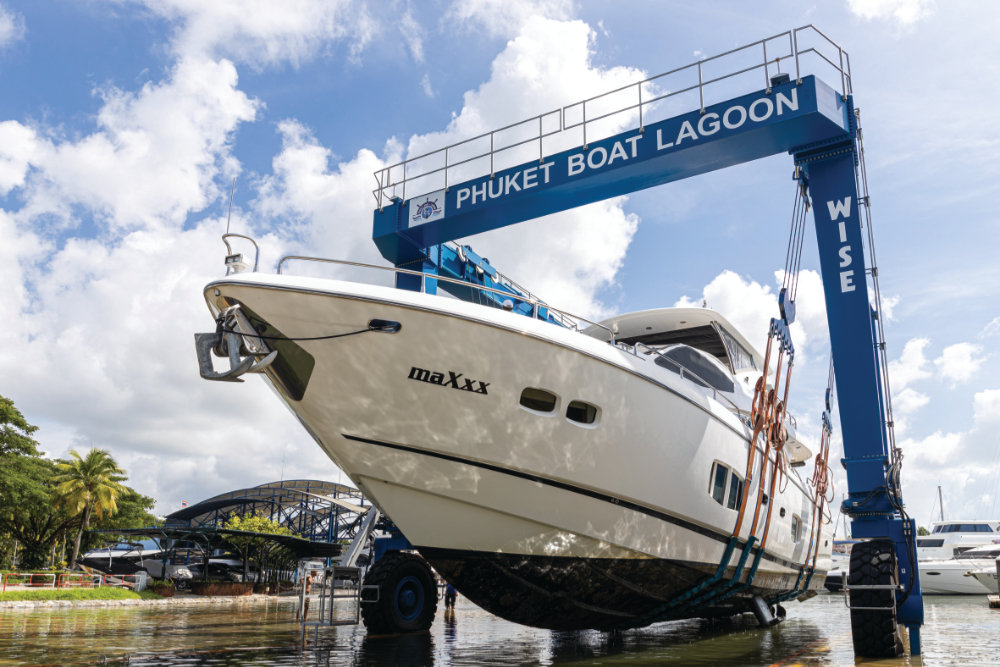
With international yachting and marine businesses making Phuket and Phuket Boat Lagoon their base, there was an increasing need for this complex to cater for the growth.
The marina complex itself is surrounded by shop-office lots for a wide range of businesses, including marine-related, lifestyle, commercial, financial services and an international early learning school.
The marina village has a 271-room resort, which caters to both the yachting community and business and leisure travellers. The marina complex itself is surrounded by shop-office lots for a wide range of businesses, including marine-related, lifestyle, commercial, financial services – and even an international school.
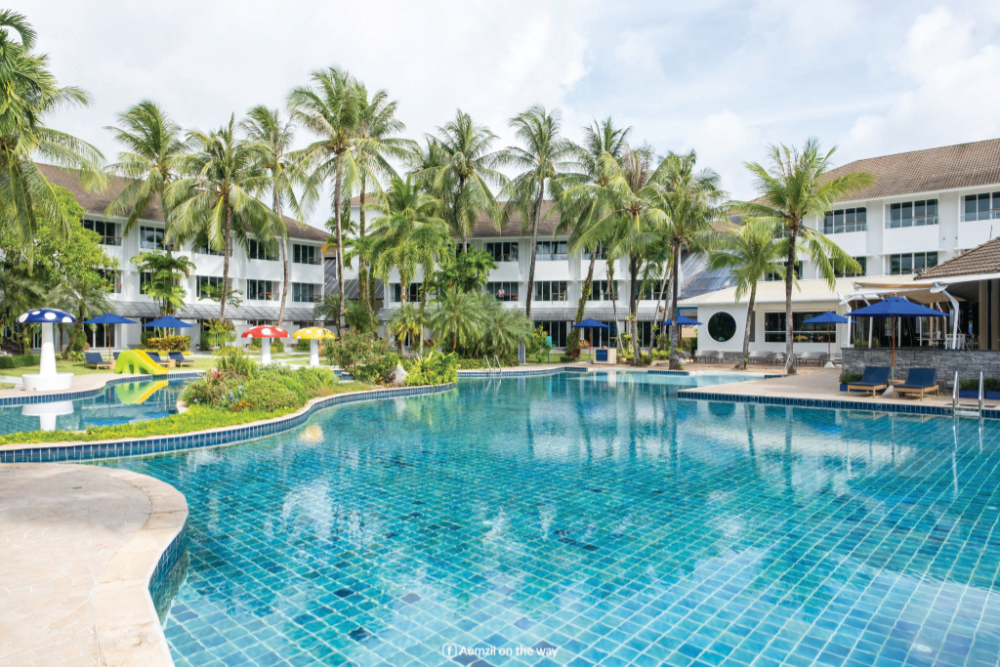
The Phuket Boat Lagoon village also comprises residential developments, ranging from condominium townhouses to villas and bungalows. These residential areas are available for both ownership and long-term lease.
Next, the marina took a greater step towards on-water and off-water expansion. Today, the Phuket Boat Lagoon is an international standard, full-service marina with 180 berths in the water, 160 on the hardstand and 22 dry stacking bays.
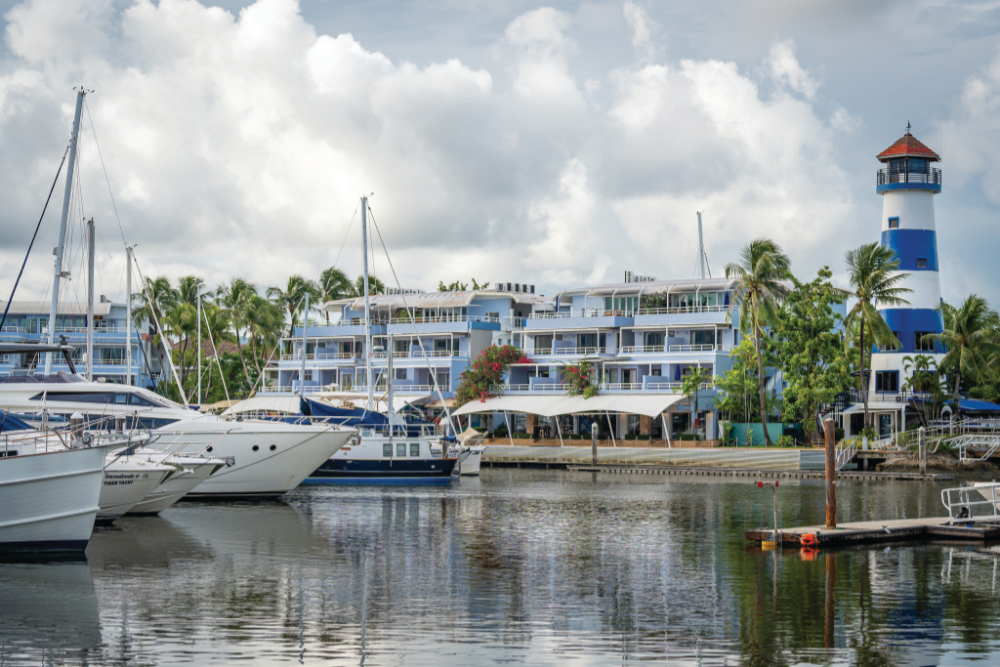
Other facilities include a fuel dock, three marine travel lifts with capacity from 40 tons up to 120 tons, forklift services up to 6 tons, a large concrete work area (hardstand) and a concrete boat ramp 7.8 metres wide.
All berths are complete with power and water. The marina is also equipped with 24-hour security service, high network CCTV coverage, firefighting services and security controlled access to the marina pontoons.
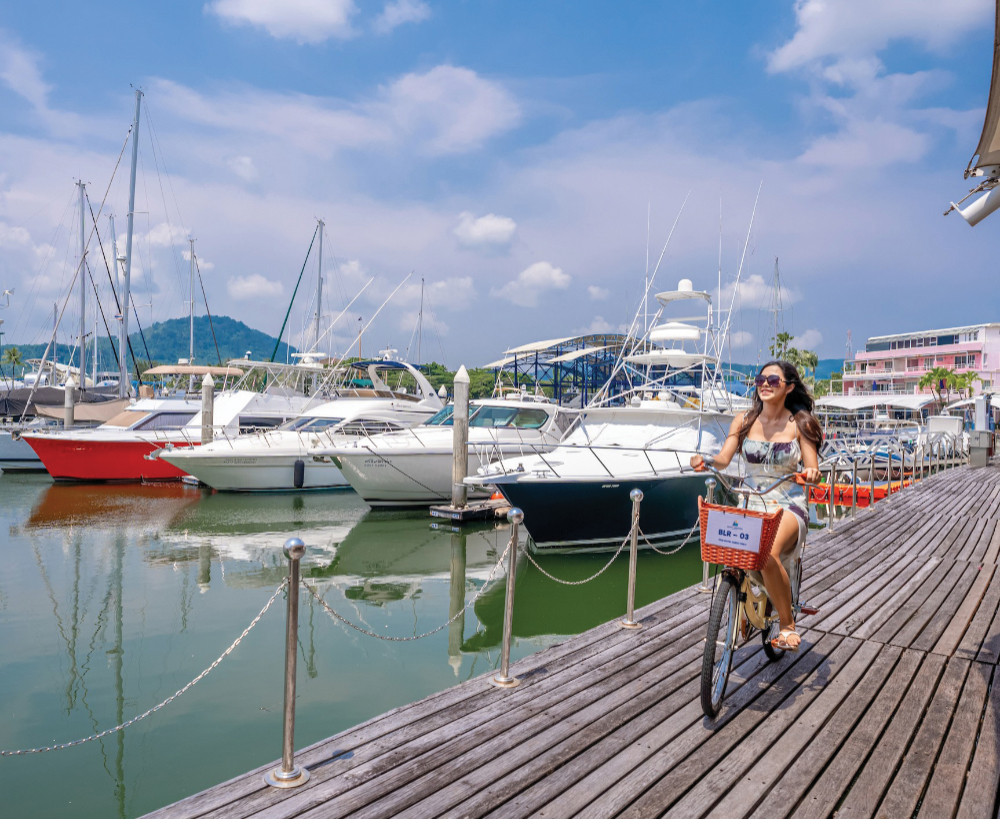
Beside providing complimentary wireless internet, the marina also offers storage room rentals for short and long-term needs. A well-protected marina, Phuket Boat Lagoon is ideal for owners to keep their yacht long term.
The resort NH Boat Lagoon Phuket Resort is a hotel resort with 271 rooms and full-service apartments. These apartments, with their nautical décor and ambience, are unique in Phuket.
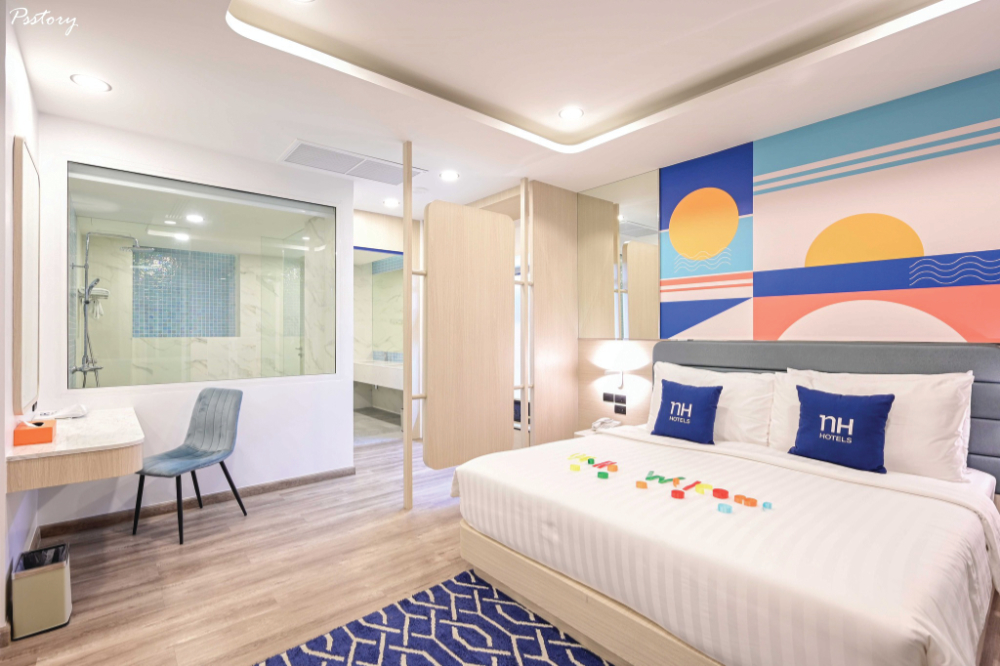
The Lagoon Quay, located on the ground floor of the marina zone, consists of a collection of dining outlets and marine oriented businesses – overlooking the beautiful marina with its moored yachts and pleasure craft.
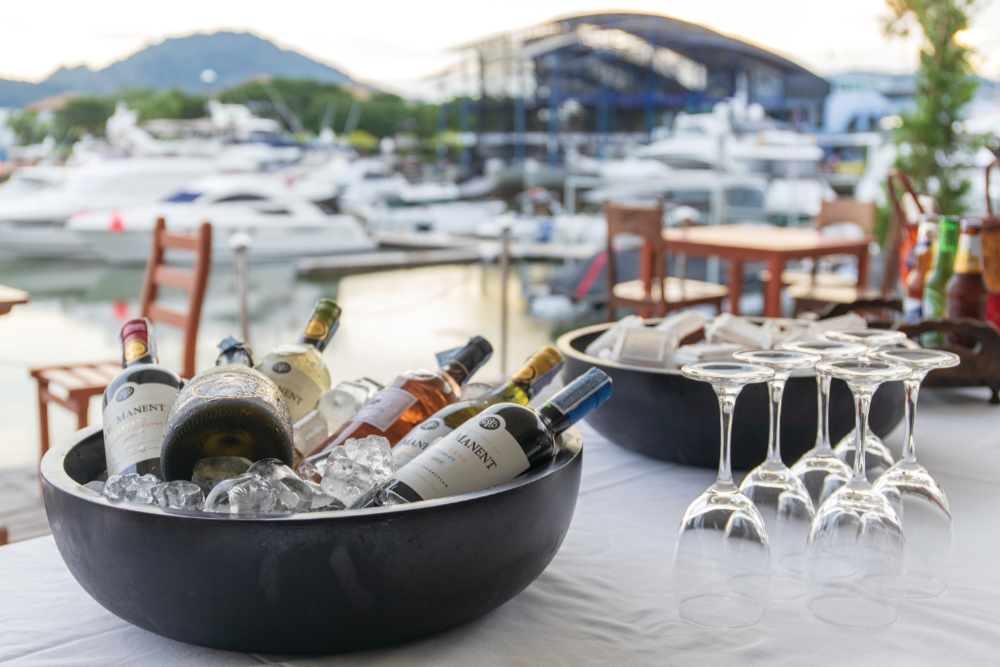
The marina complex today houses a wide range of businesses, services and products – meaning that boat owners, residents or hotel guests may not need to travel out of the marina village.
Phuket Boat Lagoon has everything – from fully-fledged banking services, an international supermarket, ice skating rink, dental and skin clinics, a pharmacy, a wide range of restaurants, bars, business service offices, health centres (spa, yoga, martial arts, gymnasium), car rental services, car wash, laundry, daily island tour operators and private yacht charters.
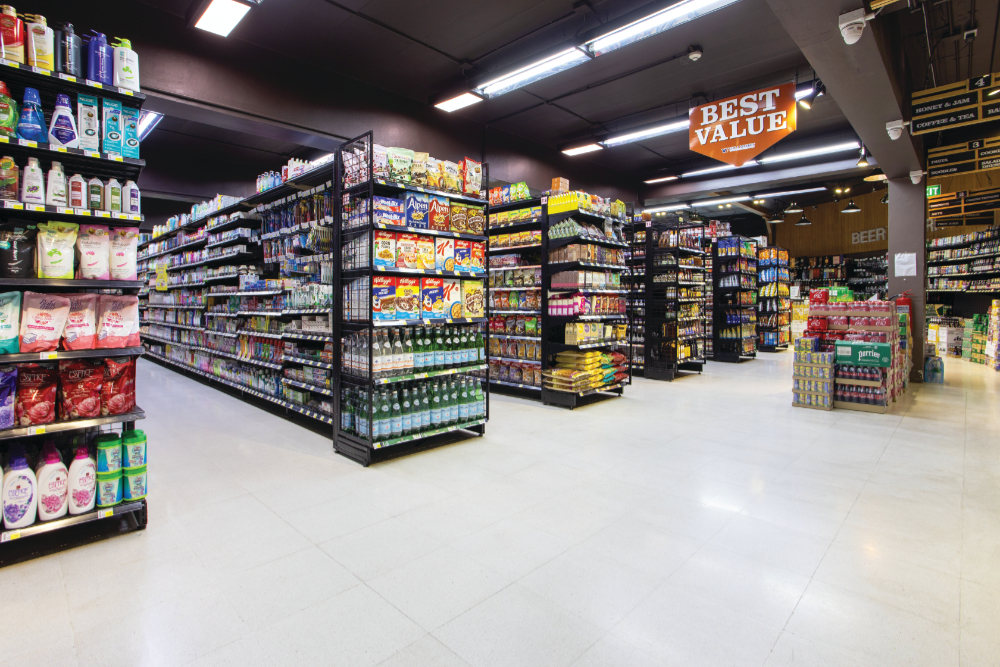
For avid boaters, the marina boasts chandleries, electronic parts, navigational systems, fibre and stainless-steel repairs, woodwork including teak wood and much more. Furthermore, Phuket Boat Lagoon has a large workshop specialising in stainless steel and welding works.
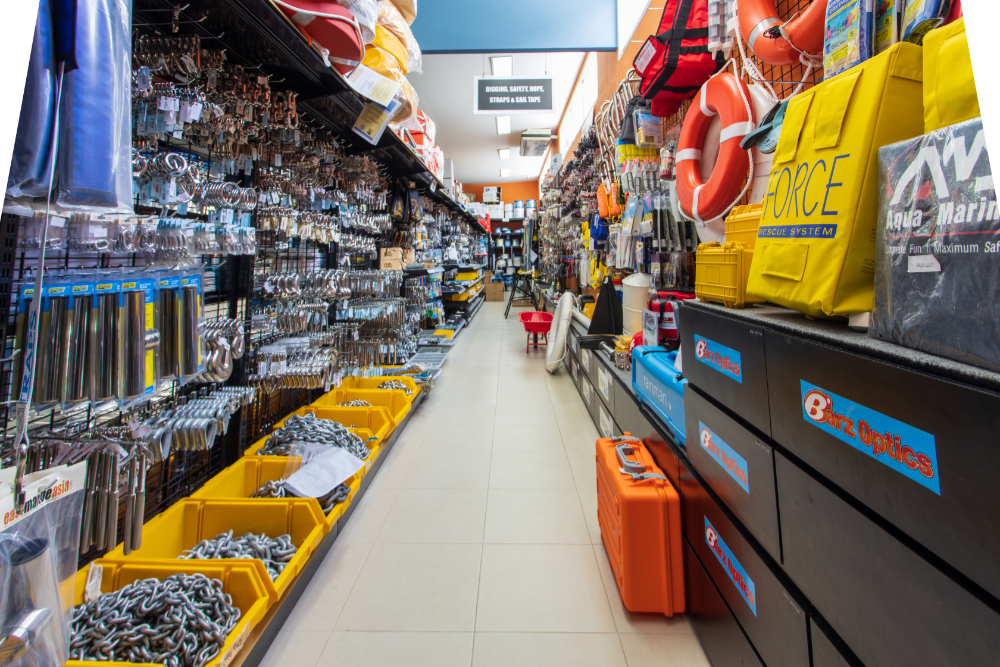
Additionally, to enhance our service to boat owners, we are equipped with a licensed Bonded Warehouse – which is our one-stop centre for the importation of tax-free marine parts. Our Bonded Warehouse also provides services for repairs, with a team of experienced yacht repair technicians, to carry out work on your boat.
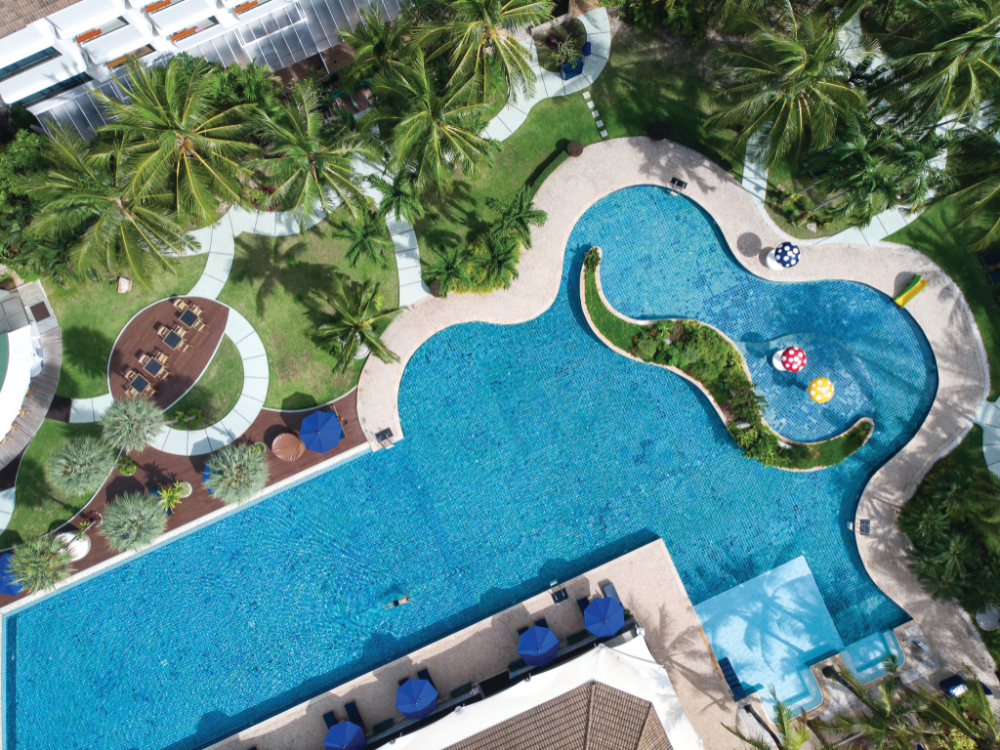
Today, Phuket Boat Lagoon has branded itself as ‘Phuket’s Most Lively Marina’ and to live up to the tagline, regular activities and events are organised for the residents, guests and visitors. “I’m proud to be associated with a group that has a wonderful vision and places great importance on its prime role in promoting the marine industry in Thailand. The owners are truly ‘people-orientated’ and the team at Phuket Boat Lagoon is well experienced and a pleasure to work with”, says Executive Director, Wicky Sundram.

For more information on Phuket Boat Lagoon, kindly visit our website, our Facebook pages or email us – all details below:
PHUKET BOAT LAGOON CO., LTD.
22/1 Moo 2 Thepkasattri Rd., T. Kohkaew, A. Muang, Phuket, 83000, Thailand
Tel: + 66 76 239 888 Fax: +66 76 273 371
Email: info@phuketboatlagoon.com
Facebook: @PhuketBoatLagoon & @BoatLagoonWeekend
www.phuketboatlagoon.com
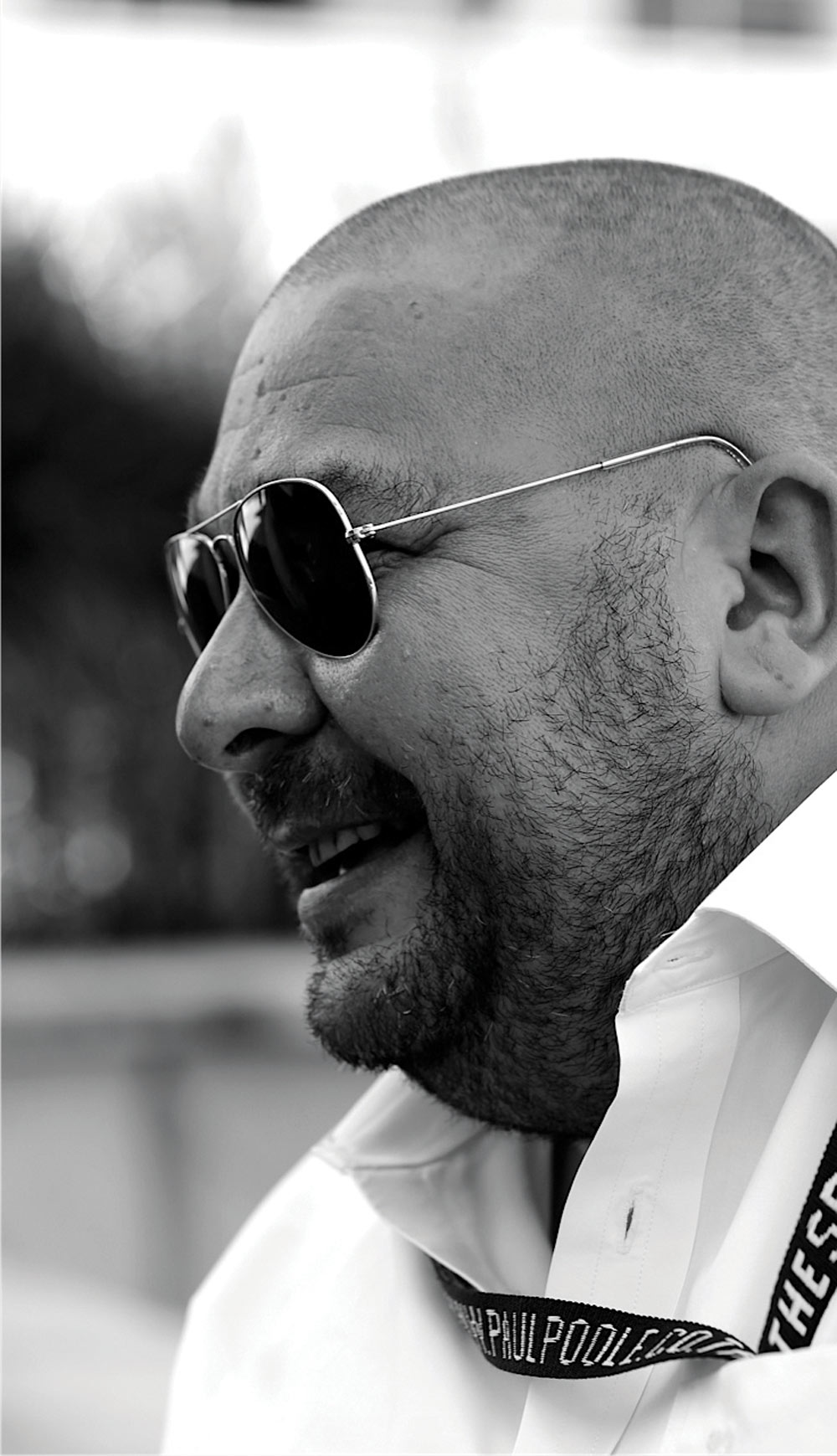
The yachting industry in Southeast Asia has seen significant growth in recent years with yacht shows, races and regattas increasing in both size, numbers and frequency. Sports tourism is becoming a buzzword and entrepreneurs, investors and governments are all buying in.
This presents a huge opportunity for organisers to put on bigger and better events and for brands and businesses to reach out to a specific target group of high net worth individuals, build brand identity, and align their marketing initiatives with some of the region’s biggest and most prestigious events. It also means that there is a growing need for marketing consultants to help sponsors and organisers to maximise their potential.
Below are some steps organisers and sponsors can take to make successful events and get the most out of the partnership.
Planning is the key to a successful event and it is important that sponsors and organisers identify their objectives. Sponsorship is a value-adding exercise for both organisers and sponsors and it is important to approach it from that point of view. Organisers should understand the needs and objectives of brands and businesses, just as brands and businesses should understand the particular event and its participants in order to maximise the benefits of the sponsorship.
Activation is the key to a successful sponsorship. A rule of thumb is for every dollar spent on sponsorship, sponsors are encouraged to spend an additional dollar on the activation of the sponsorship. The world of advertising is changing and specialised events such as yacht shows, races or regattas offer a perfect opportunity for brands and businesses to engage and interact with their target customers. With event participants active on a variety of social media platforms, sponsors also have a vested interest in being highly visible throughout the event and organisers can increase their visibility by being associated with brands and businesses who already have a large following.
Now is the time to measure the benefit of the sponsorship, and while most sponsors are looking for a return on investment, which they can quantify in terms of actual sales and leads during the event itself, there are benefits which aren’t immediately measurable, such as long term brand attributes, increased awareness and indirect sales.
As Southeast Asia’s yachting calendar becomes increasingly busy, and consumers and participants have more shows, races and regattas to choose from than ever before, it is crucial that organisers and sponsors work together to ensure events remain relevant, attractive and entertaining – or they risk losing out to the competition.
Paul Poole is the founder, managing director and chairman of Paul Poole (South East Asia) Co., Ltd., an independent marketing consultancy based in Bangkok, Thailand. The company specialises in commercial sponsorship and partnership marketing, working with both rights holders and brands. Paul Poole (South East Asia) Co., Ltd. has packaged, sold and managed sponsorship and partnership opportunities for a number of Southeast Asia’s leading yachting events. www.paulpoole.co.th
Cruising from Phuket to Langkawi includes some of the most beautiful islands in the Andaman Sea. Perfect for a quick 10-day cruise or a couple of lazy months. Deserted beaches, crystal clear bays and mysterious creeks just tempting dinghy explorations.
Cruising – Koh Lanta to Tarutao
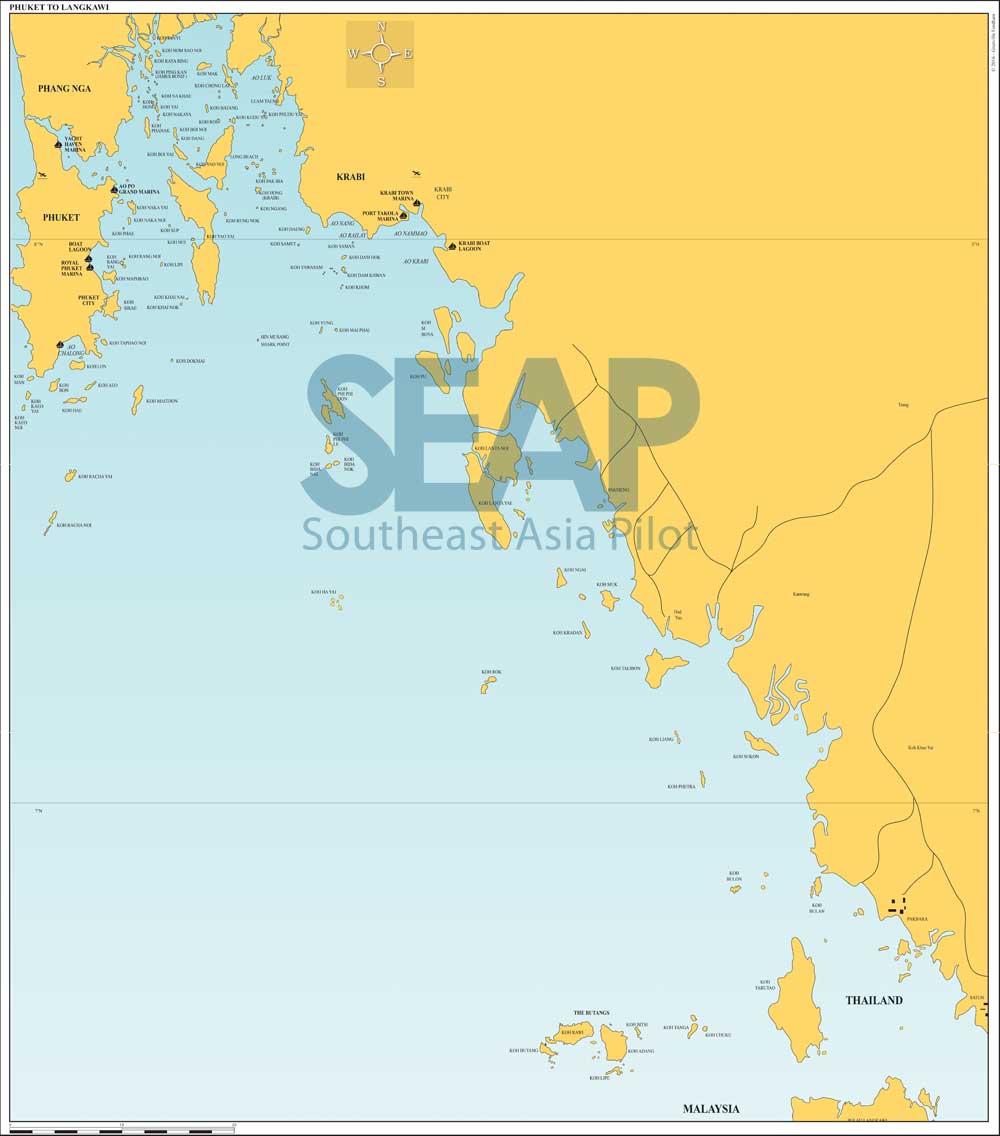
For guidance on finding, managing and retaining event sponsors, visit:
Paul Poole (South East Asia) Co., Ltd
ASIA’S LEADING SYPERYACHT EVENT
By invitation only, the Kata Rocks Superyacht Rendezvous (KRSR) is designed to bring like-minded people together from a curated guest list that features yacht owners, major trend-setters, builders, industry professionals and VIP guests interested in yachting and luxury lifestyle, plus an influential mix of luxury lifestyle and yachting media.
Read more
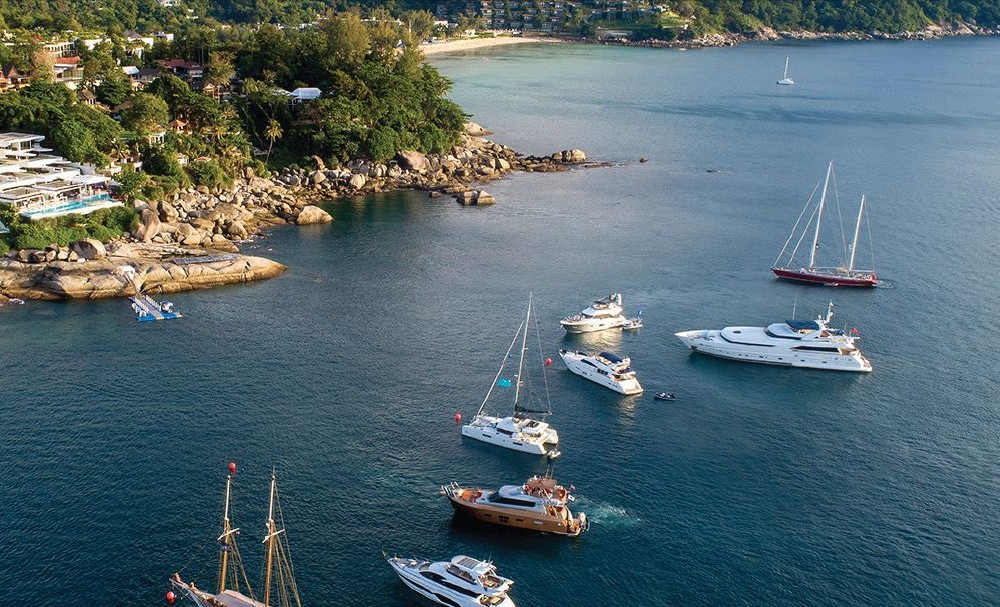
Five days of coastal and round-the-cans racing with based at Langkawi Yacht Club. Free berthing for participants. Raced under IRC, OMR and local handicap system. www.langkawiregatta.com
Launched in 2023, 20 years after the ground-breaking PIMEX. Organised by JAND Events, the show relocated to Phuket Yacht Haven for the 2025 edition and will remain there in 2026. After a turbulent few years of competing boat shows in Thailand, this event appeared to have established itself as Phuket’s only boat show – until along came the Thailand Boat Festival, setting itself up on the same dates as TIBS in 2026. www.thailandinternationalboatshow.com
Sail and motor yacht rally takes place entirely in Indonesian waters with a start and finish at Nongsa Point Marina. There’s a sprint race across the equator and a line-crossing ceremony with King Nepture.
Enquries email marina@nongsapointmarina.com
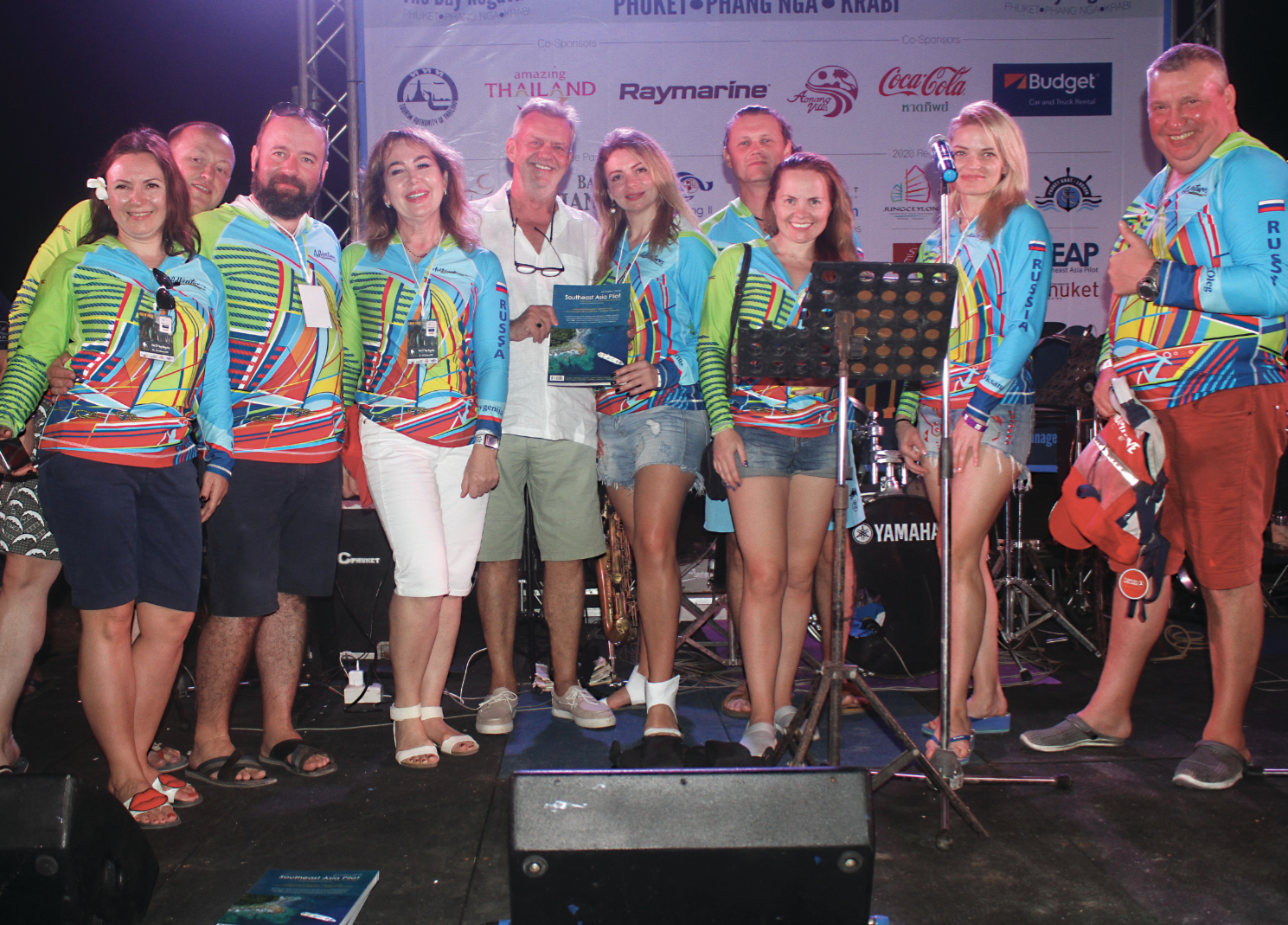
Four days of racing between the islands of Phang Nga Bay and Krabi. Perfect for families and less serious racers. Held shortly after Chinese New Year, there’s a party at a different beach venue each night. Racing under IRC, OMR and local handicap classes. www.bayregatta.com
Supported by the Singapore Sailing Federation and co-organised by Changi Sailing Club and Singapore Armed Forces Yacht Club, this is the current identity of the old Straits Regatta of the 1990s. www.csc.org.sg
2024 marked the 62nd Anniversary of the China Sea Race, organised by Royal Hong Kong Yacht Club. This 565nm Category 1 Offshore Race is run under the auspices of RORC, and takes competitors from Hong Kong, China to Subic Bay in the Philippines. www.rolexchinasearace.com
2025 was this event’s third year. Held at ONE°15 Marina Sentosa Cove, it seems to have taken over where the Singapore Yacht Show left off. Expect a lineup of around 70 yachts and a lot of ‘lifestyle’ razzamatazz to go with them. www.singaporeyachtingfestival.com
Before the Covid pandemic, this regatta had attracted up to 30 keelboats and multihulls. Formerly popular with Hong Kong and Pattaya based yachts, being on the Gulf side of the peninsula, it has recently struggled for numbers. Well worth supporting as one of the ;’riginal’ Thailand beach party regattas. Raced under IRC, OMR and local handicap. www.samuiregatta.com
Jointly organised by Changi Sailing Club and Berjaya Resorts, Tioman. A week of racing and cruising off Malaysia’s east coast, this is the newest event on the block. Includes two passage races, a round the island race and in-shore racing. enquiry@csc.org.sg
Based at the Phuket Yacht Club in Ao Chalong, this 5-day event – once a multihull-only 3-day event – now attracts a mixed fleet following the demise of Phuket Raceweek. www.phuketyachtclub.com
This is the Republic of Singapore Yacht Club’s signature keelboat event, held over two weekends each year. Three days of Fleet Racing in Singapore waters for perpetual Challenge Trophies dating back to 1923. www.rsycregatta.org
From Cairns or Darwin through the Indonesian archipelago to Singapore, with stopovers at Timor, Banda, Lembata, Wakatobi, Flores, Sulawesi, Bali, Java, Borneo, Belitung and Bintan. www.sail2indonesia.com
Three days of sailing over two weekends in front of Singapore’s Raffles Marina. This event is co-organised by Raffles Marina and Singapore Management University (SMU) and is the premier regatta on the Singapore racing scene. www.wcsr.sg
Organised by Darwin’s Dinah Beach Cruising Yacht Association, this 600-mile event is a bit on-and-off, but check out the website; it’s touted to become one of the classic blue water events in Southeast Asia. www.dbcya.com.au/darwin-to-ambon
Organised by the Royal Hong Kong Yacht Club, this three-day event attracts all of the top Asian sailors in IRC racing. Raced off Hong Kong and China. www.rhkyc.org
Hong Kong to Shenzhen, then three days’ racing in and around Shenzhen’s Daya Bay. Inshore, island races plus passage race. www.chncup.com
The Royal Hong Kong Yacht Club’s bienneial 390-mile downwind passage to Sanya on Hainan Island, renowned as a playground for China’s jet set. www.chinacoastraceweek.com
A three-day, 673nm fast passage race finishing in Nha Trang. This is another favourite with the Hong Kong racing fraternity. www.rhkyc.org / www.chinacoastraceweek.com
(Possibly end of October) Organised by the Puerto Galera Yacht Club, the All Souls Regatta was first held in 2004 and has quickly become the most popular regatta in the Philippines. www.pgyc.org
Starts from Royal Selangor Yacht Club and finishes with inshore racing off Langkawi. Includes overnight and passage racing. Raced under IRC and local handicap systems. www.rmir.com
This regatta attracts up to 100 yachts and 600 sailors for a week of coastal and inshore racing and parties. Raced on Phuket’s west coast and culminating with the Royal Awards Ceremony, it’s the granddaddy of regional regattas. www.kingscup.com
By invitation only, the Kata Rocks Superyacht Rendezvous (KRSR) is designed to bring like-minded people together from a curated guest list that features yacht owners, major trend-setters, builders, industry professionals and VIP guests interested in yachting and luxury lifestyle, plus an influential mix of luxury lifestyle and yachting media.
The event is open to both sailing and motor yachts measuring over 24 metres in length, visiting or based in Phuket – Southeast Asia’s leading luxury location and superyacht hot spot www.katarockssuperyachtrendezvous.com
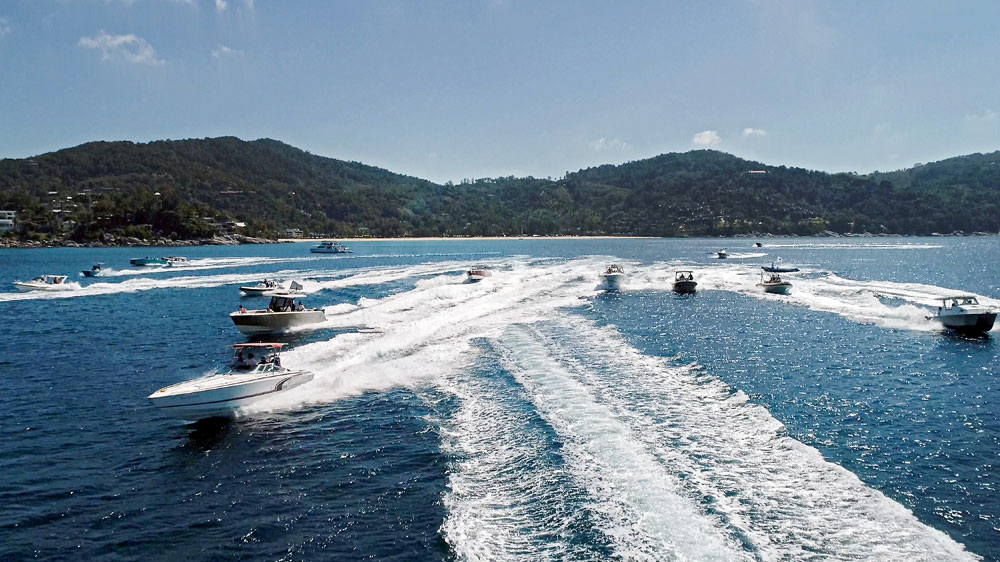
Heading towards its 7th edition in December 2026. Along the course, participants collect a single playing card at several key locations. Infused with a distinct ‘Miami Vice’ vibe, the KRPR promises a day filled with fun, camaraderie and friendly competition on the water. www.katarockspokerrun.com
Penguin Shipyard International (PSI)at Tuas caters largely for commercial vessels and mega-yachts up to 500 tons. This is an aluminium shipbuilder with a track record that dates back to 1995, building and repairing high-speed commercial vessels, including ferries, crewboats, cargo vessels and patrol craft. In addition, it arranges international superyacht haulouts.
PSI operates a 30,000-square metre site, with a 500-metric ton straddle carrier, four purpose-built workshops and open-yard repair slots. Their facilities include a 50m x 50m covered shipbuilding hall, 6,000 square metres of open area and a 50-metre commissioning pier. To date, they have built more than 50 vessels for the group’s own requirements and for third-party ship owners.
For more information visit www.penguin.com.sg
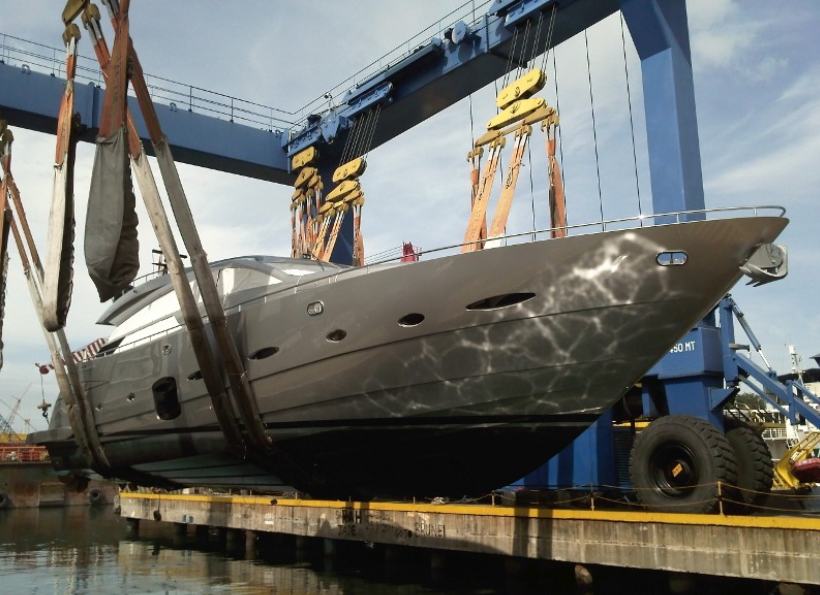
Superyacht refit at Penguin Shipyard
A mile northwest of The Republic of Singapore Yacht Club in the Pandan River is this well-equipped shipyard, managed by the Pacific Radiance Group, that recently started catering for superyachts.
They manage a variety of works: repair, maintenance, fabrications, hot works, refit and conversion – alongside or at dry dock.
Superyachts can access 188 metres of water frontage, two dry docks up to 100 metres and 8 acres of hard stand. CrestSA Marine & Offshore
ST Engineering have two well-established shipyards with a full range of services to support the lifecycle of superyachts. The Tuas yard is for repairs and conversions with two floating docks up to 240 metres in length and two 250 metres wharfage with travelling cranes.
The Benoi yard is for new builds, repairs and conversions and has two Syncroflits, two construction halls, eight outfitting workshops, a permanent launchway and 500 metres of deep-water wharves with travel cranes. ST Engineering Marine
Located in the southern Tuas Basin, Dauphin has 150 metres of seafront with two slipways for vessels up to 95 metres. Ashore is an 18,000 square metre covered workshop, offices and two acres of open fabrication area. Dauphin Shipyard
A mile northeast of Boustead, in Bass Harbour, is Northern Shipyard. It’s a smaller yard that currently provides full superyacht services. It has a 1,000-ton slipway, two hangers (90m and 66m), a 200-ton travel lift, 50 metres of finger pier and two acres of hardstand. It provides full services for superyacht repair, refit and maintenance. Northern Shipyard Langkawi
Formerly Wavemaster Yacht Centre, this yard is situated on the west entrance to Bass Harbour at Bukit Malut. It currently provides full superyacht repair and refit services.
Alongside the wharf there is a minimum depth of seven metres at low tide. 140-ton and 500-ton capacity travel lifts service 17,000 square metres of hardstand. Behind the hardstand are two 24-metre high, insulated and ventilated, hangers – each of 70 x 25 metres – and a 20 x 24-metre climate controlled composite lamination hall.
There are adjoining carpentry, aluminium, electrical and mechanical workshops, each with individual overhead gantry cranes. On-site staff naval architects and engineers design for new builds, conversions, and major overhauls.
Berthing for yachts of 13-70 metres, with fresh water, 3-phase shore power and telecommunications is available off the wharf. Petrol and diesel are also available.
Lockers, washrooms, showers, chandlery, supermarket are all within easy walking distance.The yard has 24-hour security. Boustead Langkawi Shipyard
Located just inside the entrance of Tha Chin River, Ratanachai Slipway is the biggest of the local shipyards in and around Phuket town.
Maximum capacity is 52 metres and 210 tons. Bow depth 1.95m, stern depth 3.95m. The river entrance is shallow and should be navigated at high tide only. Full services are available. Ratanachai Slipway
Further up the river on the right, just before the bridge, is another Thai-speaking yard with a slipway capable of lifting up to 40 metres with a large concrete hardstand. This is a good location for Phuket-based long-term projects, especially if you’re on a budget and can speak fluent Thai – or have a good translator.
At the mouth of the river on the same bank there is an alongside concrete wharf where some finishing works can be done afloat after launching. Asian Phuket Marine and Dockyard
With head office located at Samut Prakan on the Chao Phraya River, this very capable shipyard has recently opened a smaller yard down in Asimar, Surathani on the South China Sea coast. Both Asian Marine Services yards specialise in new ship building, repair, engineering and fabrication for vessels up to 60 tons. Asian Marine (Surat Thani)
With head office located at Samut Prakan on the Chao Phraya River, this very capable shipyard has recently opened a smaller yard down in Asimar Surathani on the South China Sea coast. Both Asian Marine Services yards specialise in new ship building, repair, engineering and fabrication for vessels up to 60 tons. www.asimar.com
A subsidiary of Penguin Shipyard International, offering the same shipbuilding and repair services as their Singapore Yard.
Based in north Batam, an hour ferry ride from Singapore, PTKS has a 700-ton and a 250-ton travelift, five workshops with overhead cranes and 12 acres of concreted grounds.
The 700 ton travelift handles vessels up to 80 metres in length and 19 metres wide. With over 1,000 staff across all trades, PTKS is capable of undertaking large-scope new builds, refits and repairs and conversion activities concurrently. PT Kim Seah Shipyard
The port city of Surabaya in East Java is an ideal location for slipping, sourcing and fabrication. With a mainly Chinese Christian population of five million, Surabaya is the largest naval and shipbuilding city port in Indonesia.
There are many slipways that cater for vessels over 30 metres and a number of vessels have been built here very economically. These mainly government-supervised yards have produced traditional Pinisis, superyachts and myriad commercial vessels.
Being the largest naval and marine merchant city of the archipelago, Surabaya boasts an abundance of marine contractors, parts and equipment, but local knowledge is essential to bring any new build or refit projects to fruition.
Located in Tayud, Consolacion, on the island of Cebu, Colorado Shipyard Corporation (CSC) caters to commercial and private vessels over 30 metres.
Colorado’s dockyard facility sits on nine hectares with five slipways and a transferring system for up to 300 tons. All the usual fabrications are available. Colorado Shipyard
Located in the Free-Port Zone in Subic Bay, this in-water refit facility near Lyte Wharf has completed dozens of excellent superyacht refits over the past few years.
Vessels of up to 90 metres can tie stern-to and access the full variety of work sheds and competent local craftsmen on this 4-acre concrete slab. www.hys-yachts.com
Located in the Australian Marine Complex (AMC) Echo Marine Group are situated in Henderson near Fremantle.
They deliver a consistently high standard of service, engineering, workmanship, and finish across all refit, maintenance and superyacht repair projects.
Extensive wet-berth and hard-stand space is available with multiple haul-out options comprising 800-ton slipway with transfer trolley system, 8,000-ton syncrolift and a 12,000-ton floating dock. Echo Marine Group
This section lists the Marina Facilities in Southeast Asia, complete with the capacities, amenities and facilities they offer.
We haven’t listed Greater China’s marinas here yet because they’re all new, much is lost in translation and we need to better understand their capabilities and services for visiting yachts. The China pages will give you a taste of what is available – but no guarantees you’ll find what you read!
With regard to haul-out, repair, refit and so on, a separate page deals with major facilities, including for superyachts. Here, in the marina listings, we indicate which marinas have similar facilities for smaller yachts.
Berths: 230 | VHF: Ch69 | Haul out ramp: 47 & 80 tons trailer lifts | Repair-refit facilities & services: Limited | Chandlery: Yes | Superyachts: Yes | Hardstand: 66 | Fuel: Yes | F&B: 3
Berths: 80 | VHF: Ch67 | Haul out: Travel lift 35 tons, ramp, forklift | Hardstand: 100 | Repair-refit facilities & services: Limited | Chandlery: No | Superyachts: No | Fuel: Yes | F&B: 1
Berths: 450 | VHF: Ch12 | Haul out: Travel lift 75 & 25 tons; 5-ton fork lift; trailer boat ramp & tractor | Hardstand: 40 | Drystack: Yes | Repair-refit facilities & services: Yes | Chandlery: Yes | Superyachts: Yes | Fuel: Yes | F&B: 2
www.oceanmarinayachtclub.com
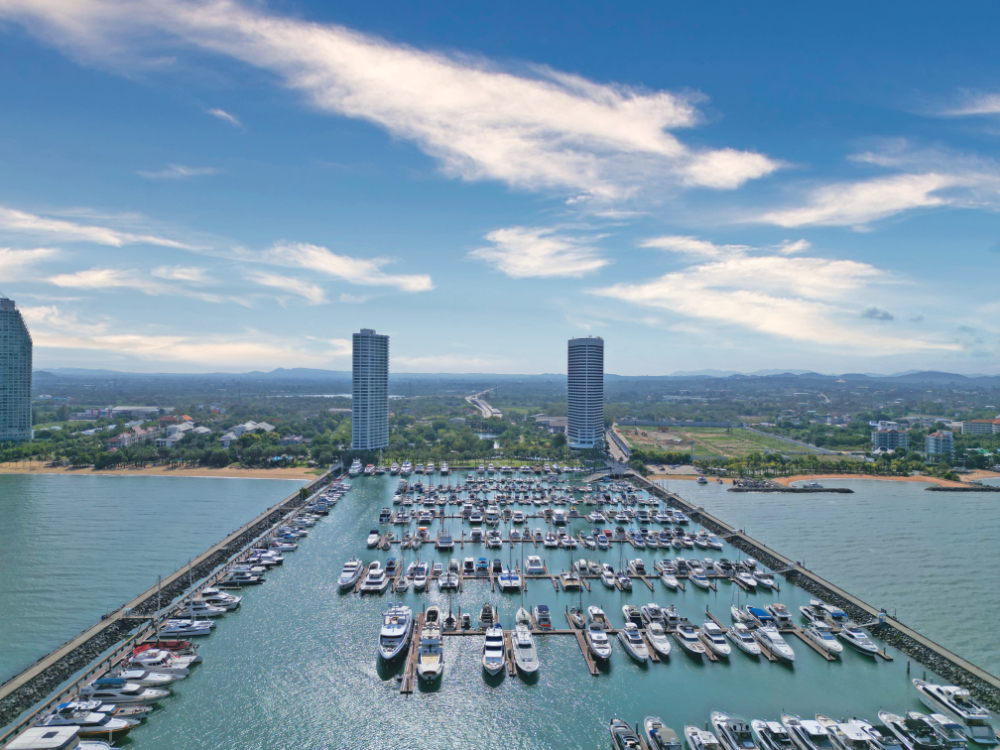
Berths: 180 | VHF: Ch71 & 67 | Haul out: 4 x Travel lifts 40, 50, 80 & 120 tons | Repair-refit facilities & services: Yes | Chandlery: Yes | Superyachts: No | Drystack: 12 | Hardstand: 144 | Ramp: 7-ton forklift | Fuel: Yes | F&B: >10
www.phuketboatlagoon.com

Berths: 332 | VHF: Ch68 | Haul out: No | Repair-refit facilities & services: Yes – at berth only | Chandlery: Yes | Superyachts: Yes | Fuel: Yes | F&B: 3
Berths: 70 – Phase 1 | VHF: Ch69 | Haul out ramp: 38 tons forklift | Hardstand: 40 | Repair-refit facilities & services: No | Chandlery: No | Superyachts: Yes <40m | Fuel: Yes | F&B: 1
Berths: 80 | VHF: Ch79 | Haul out: Travel lift 35 tons | Repair-refit facilities & services: Yes | Chandlery: No | Superyachts: No | Hardstand: 200 | Fuel: Yes | F&B: 1
Berths: 76 | VHF: Ch79 | Haul out: Travel lift 50 tons | Repair-refit facilities & services: Limited | Chandlery: No | Superyachts: Yes <35m | Hardstand: 26 | Drystack: 60 | Fuel: Yes | F&B: 1 only; subject to change
Berths: 75 | VHF: Ch16 | Haul out: No | Superyachts: No | Repair-refit facilities & services: No | Chandlery: No |Fuel: No | F&B: 2
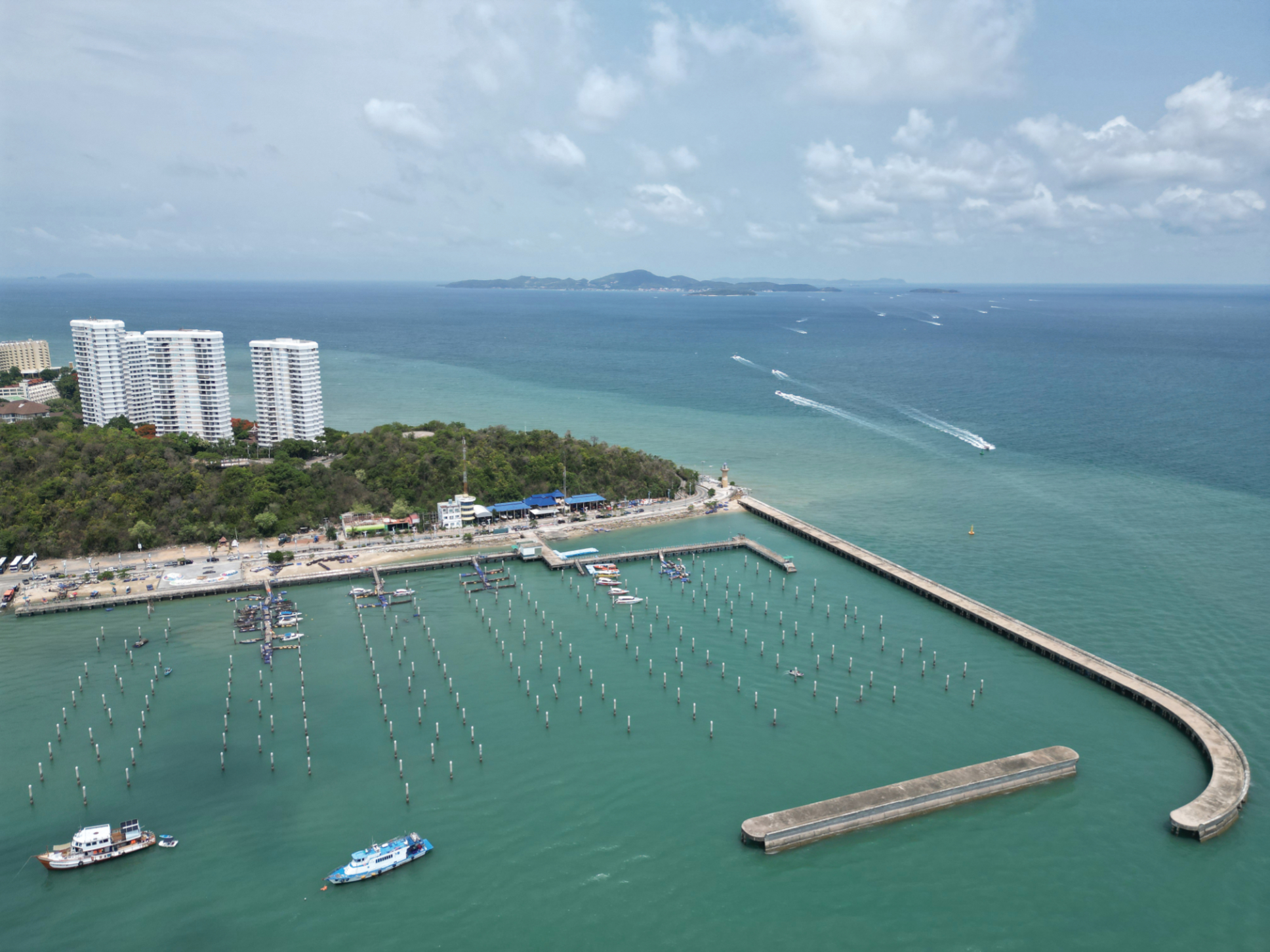
Berths: 128 | VHF: Ch68 | Haul out: No | Repair-refit facilities & services: No | Chandlery: No | Superyachts: No | Fuel: No | F&B: 2
Berths: 140 | VHF: Ch11 | Haul out: No | Repair-refit facilities & services: No | Chandlery: No | Superyachts: No | Fuel: Yes (outside lock) | F&B: 2
Berths: 72| VHF: Ch8 | Haul out: No | Repair-refit facilities & services: No | Chandlery: No | Superyachts: No | Fuel: No | F&B: 2
Berths: 261 | VHF: Ch16 & 81 | Haul out: No | Repair-refit facilities & services: No | Chandlery: Yes | Superyachts: Yes | Fuel: Yes | F&B: Several
Berths: 197 | VHF: Ch16 | Haul out: No | Repair-refit facilities & services: Limited | Chandlery: Yes | Superyachts: No | Fuel: Yes | F&B: 2
Berths: 135 | VHF: Ch16 | Haul out: No | Repair-refit facilities & services: Limited | Chandlery: Yes | Superyachts: Yes | Fuel: Yes | F&B: 3
Berths: 12 | VHF: Ch16 | Haul out: No | Repair-refit facilities & services: No | Chandlery: No | Superyachts: No | Fuel: No | F&B: 2
Berths: 30 | VHF: Ch77 | Haul out: No | Chandlery: No | Superyachts: Yes | Fuel: Yes | F&B: 2 | CIQ: Yes
Berths: 66 | VHF: Ch16 | Haul out: No | Chandlery: No | Repair-refit facilities & services: No | Superyachts: 2 | Fuel: No | F&B: 2 | CIQ: Yes
Berths: 30 (stern-to) & 6 moorings | VHF: Ch16 | Haul out: No | Repair-refit facilities & services: No | Chandlery: No | Superyachts: No | F&B: 2
Berths: 10 | VHF: Ch77 | Haul out: <20 Tons | Repair-refit facilities & services: No | Chandlery: No | Superyachts: No | Fuel: No | F&B: 2
Berths: 78 | VHF: Ch69 | Haul out: No | Repair-refit facilities & services: No | Chandlery: No | Superyachts: Yes| Fuel: Yes| F&B: 1 | CIQ: Yes
Berths: 6 | VHF: Ch16 | Haul out: No | Repair-refit facilities & services: No | Chandlery: No | Superyachts: No | F&B: 2
Berths: 270 | VHF: Ch77 | Haul out: No | Drystack: 40 | Repair-refit facilities & services: Yes | Chandlery: Yes | Superyachts: Yes | Fuel: Yes | F&B: 4 | CIQ: Yes
Berths: 35 | VHF: Ch77 | Haul out: Travel lift 60 tons | Ramp: 10- & 12‑ton forklifts | Drystack: 50 | Hardstand: 200 | Repair-refit facilities & services: Yes | Chandlery: No | Superyachts: No | Fuel: No | F&B: 2
Berths: 168 | VHF: Ch77 | Haul out: No | Repair-refit facilities & services: No | Chandlery: No | Superyachts: Yes | Fuel: Yes | F&B: 4
Berths: 152 | VHF: Ch77 | Haul out: Travel lift 70 tons | Drystack: 40 | Repair-refit facilities & services: Yes | Chandlery: No | Superyachts: Yes | Fuel: Yes | F&B: 3
Berths: 118 | VHF: Ch77 | Haul out: Travel lift | Drystack: 195 | Repair-refit facilities & services: Yes | Chandlery: No | Superyachts: Yes | Fuel: Yes | F&B: 2
Berths: 49 | VHF: Ch11 | Haul out: No | Drystack: 195 | Repair-refit facilities & services: No | Chandlery: No | Superyachts: No | Fuel: No | F&B: none onsite
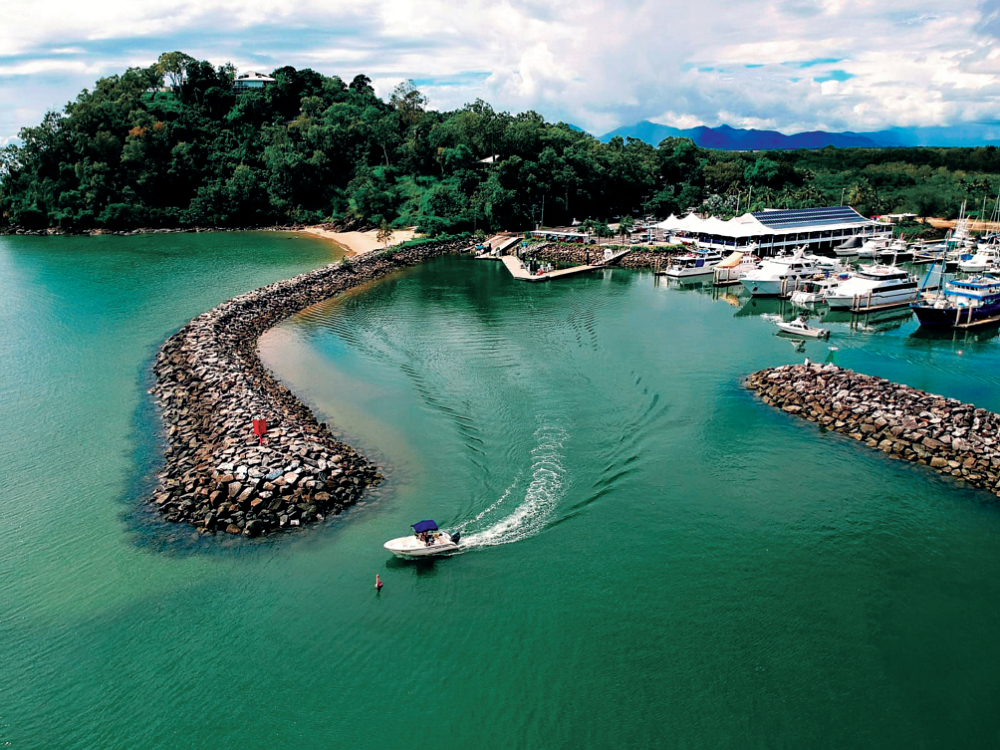
Berths: 130 | VHF: Ch14 | Haul out: No | Repair-refit facilities & services: No | Chandlery: No | Superyachts: 4 | Fuel: Yes | F&B: 2 | CIQ: Close by
Berths: 20 | VHF: Ch71 | Haul out: No | Repair-refit facilities & services: No | Chandlery: No | Superyachts: No | Fuel: No | F&B: 2
Berths: 20 | VHF: No | Haul out: No | Repair-refit facilities & services: No | Chandlery: No | Superyachts: No | Fuel: No | F&B: No | CIQ | Yes
Berths: 37 | VHF: No | Haul out: No | Repair-refit facilities & services: No | Chandlery: No | Superyachts: No| Fuel: No | F&B: 1 | CIQ | Yes
Berths: 40 | VHF: Ch72 | Haul out: No | Repair-refit facilities & services: No | Chandlery: No | Superyachts: No | Fuel: No | F&B: 2
Berths: 24 | VHF: Ch16 | Haul out: No | Repair-refit facilities & services: No | Chandlery: No | Superyachts: No | Fuel: No | F&B: No | CIQ: Close by
Berths: 60 | VHF: Ch69 | Haul out: SEAlift, forklift, crane | Hardstand: 12 | Repair-refit facilities & services: Yes | Chandlery: Yes | Superyachts: 2 | Fuel: No | F&B: 6
Berths: 80 | VHF: Ch69 | Haul out: No | Repair-refit facilities & services: No | Chandlery: No | Superyachts: No | Fuel: No | F&B: 1
Berths: 80 | VHF: Ch16 | Haul out: No | Repair-refit facilities & services: No | Chandlery: No | Superyachts: No | Fuel: No | F&B: 2
Berths: 24 | VHF: No | Haul out: No | Repair-refit facilities & services: No | Chandlery: No | Superyachts: No | Fuel: No | F&B: No | CIQ
Berths: 76 | VHF: Ch18 | Haul out: No | Repair-refit facilities & services: No | Chandlery: No | Superyachts: 12 | Fuel: No | F&B: 12 | CIQ | Yes
Berths: 124 | VHF: Ch69 | Haul out: Travel lift 65 tons | Hardstand: 70 | Repair-refit facilities & services: Limited | Chandlery: No | Superyachts: No | Fuel: Yes | F&B: 2
Berths: 200 | VHF: Ch69 | Haul out: No | Repair-refit facilities & services: No | Chandlery: No | Superyachts: 4 | Fuel: Yes | F&B: 2 | CIQ: Close by
Berths: 30 | VHF: Ch72 | Haul out: Ramp & Crane | Hardstand: 12 | Repair-refit facilities & services: Limited | Chandlery: No | Superyachts: 2 | Fuel: No | F&B: 1 | CIQ: Close by
Berths: 125 | VHF: Ch71 | Haul out: No | Repair-refit facilities & services: No | Chandlery: No | Superyachts: No | Fuel: No | F&B: 1 | CIQ: Close by
Berths: 100 | VHF: Ch71 | Haul out: No | Repair-refit facilities & services: No | Chandlery: No | Superyachts: No | Fuel: No | F&B: 1
Berths: 40 | VHF: Ch71 | Haul out: No | Repair-refit facilities & services: No | Chandlery: No | Superyachts: No | Fuel: No | F&B: 6
Berths: 104 | VHF: Ch71 | Haul out: No | Repair-refit facilities & services: No | Chandlery: No | Superyachts: Yes | Fuel: No | F&B: 1
Berths: 6 / VHF: Ch16 / Haul out: No / Repair-refit facilities & services: No / Chandlery: No / Superyachts: No / Fuel: No / F&B: No / CIQ / Yes
Berths: 30 | VHF: Ch16 | Haul out: No | Repair-refit facilities & services: No | Chandlery: No | Superyachts: No | Fuel: No | F&B: No | CIQ | Yes
Berths: 67 | VHF: Ch69 | Haul out: No | Repair-refit facilities & services: No | Chandlery: No | Superyachts: 10 | Fuel: Yes | F&B: 8 | CIQ | Yes
Berths: 170 | Haul out: Fork lift | Drystack: 157 | Repair-refit facilities & services: Limited | Chandlery: No | Superyachts: No | Fuel: Yes | F&B: 2
Berths: 200 | Haul out: No | Repair-refit facilities & services: No | Chandlery: No | Fuel: No | Superyachts: Yes | F&B: 2
Berths: 53 | Haul out: Ramp and Trailers <7 tons <10 tons | Repair-refit facilities & services: Limited | Chandlery: No | Superyachts: No | Fuel: No | F&B: 2
Berths: 250 | Haul out: Ramp and Trailer | Repair-refit facilities & services: No | Chandlery: No | Superyachts: Yes | Fuel: Yes | F&B: 2
Marina Club Discovery Bay closed at the end of 2018. It is scheduled to re-open in 2020 as the remodelled Lantau Yacht Club, with 150 berths ranging from 10 to 60 metres, according to their website.
Berths: 60 | VHF: Ch16 | Haul out: Travel lift 40 tons | Repair-refit facilities & services: Yes | Chandlery: No | Superyachts: Yes | Fuel: No | F&B: 2
Berths: 150 | VHF: Ch16 | Haul out: Travel lift 60 tons | Repair-refit facilities & services: Yes | Chandlery: No | Superyachts: Yes | Fuel: Yes | F&B: 4
